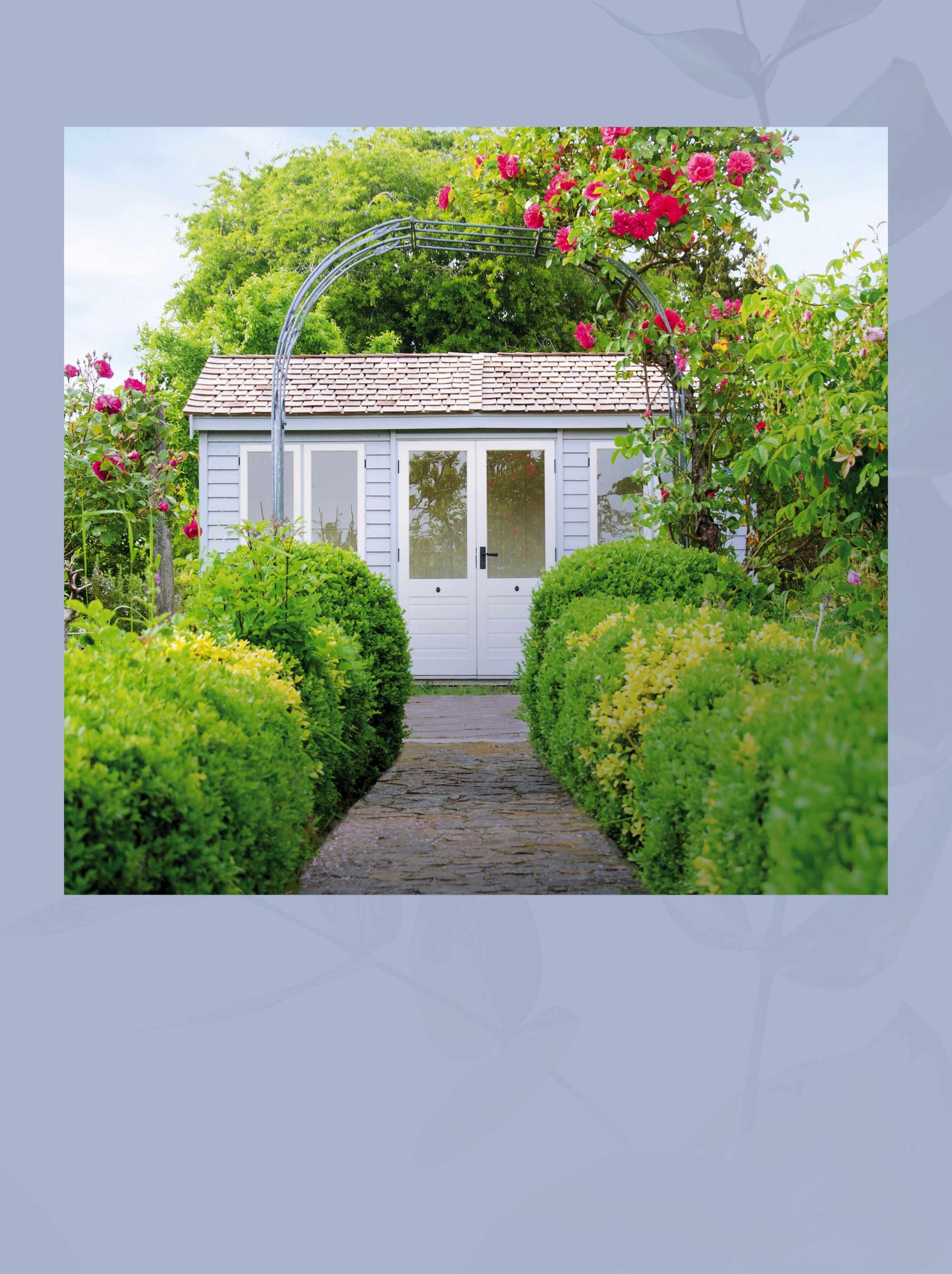GA DENS




ild gardens. That pairing of words is challenging, because for many people, ‘wild’ means untouched by humans, but a garden is a landscape wholly crafted by us. Do we think a wild place can only be one without people? A romantic ideal of pristine untamed beauty, where everything thrives free from human influence – somewhere that, as landscape ethicist Rick Darke puts it, ‘the last best things reside’. In our modern, increasingly urbanised world, there are few places like this left, so it’s no wonder we revere landscapes we consider to be natural. But much of our countryside has been man-made over centuries of farming and forestry – often, what we see as ‘wild’ is actually not.
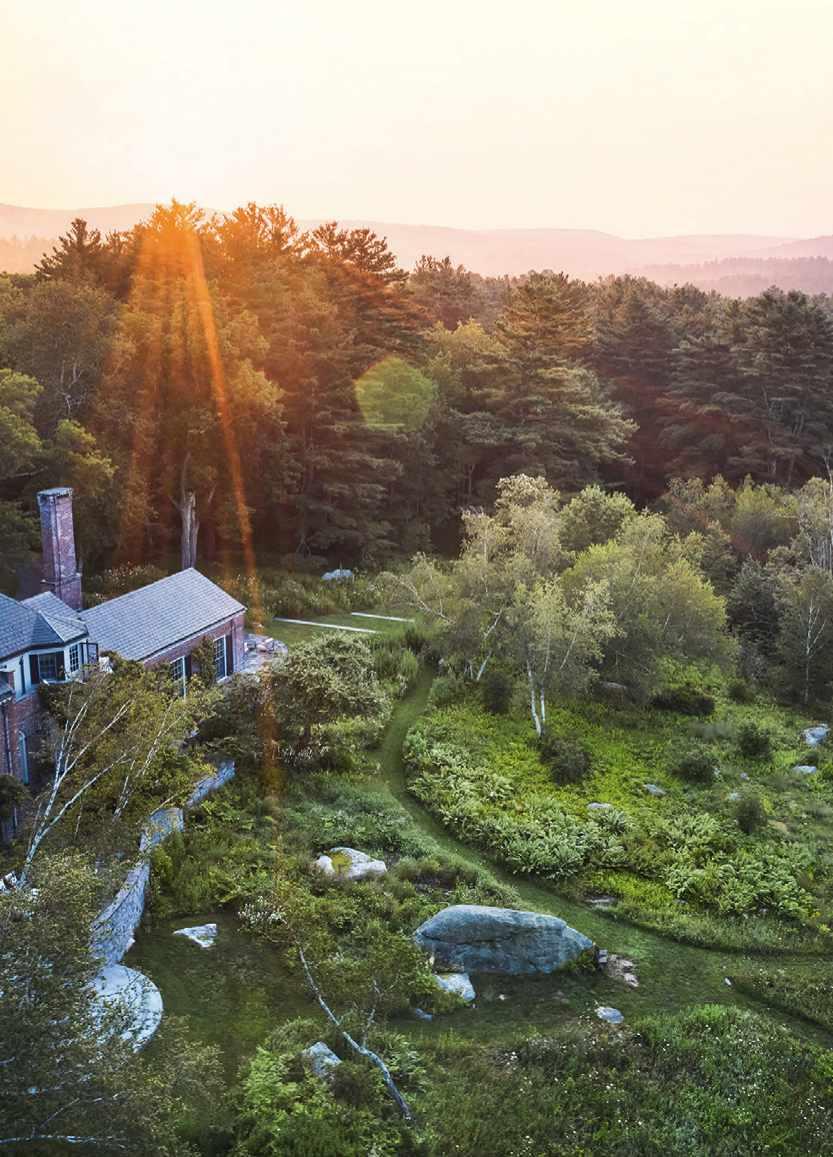
Maybe, if we flip this and open our minds a little, what we see as ‘not wild’, can be. As environmental historian William Cronon says: ‘Wildness can be found anywhere, from seemingly tame fields to the cracks of a sidewalk’. It’s all around us, and we are part of it, if we decide to be. Our gardens can be habitats for lots of wildlife, as well as a bridge that connects us back to nature and the wider world. Obviously, gardens by themselves cannot fix all the issues that we face, but as author Michael Pollan puts it, ‘the habits of thought they foster can take us a long way in that direction’.
In this special issue, we explore gardens that have embraced those habits of thought, from Dan Pearson’s Robin Hill (page 28) and Knepp Castle Walled Garden (page 82) to a water-meadow garden (page 60) and one perfect for pollinators (page 94). No single garden here has all the answers, but each one offers some idea of how we can approach, develop and manage our gardens in a more nature-friendly way.
Instagram @gardens_illustrated
Twitter @GdnsIllustrated


Facebook @gardensillustrated


Focus on the things that really matter.
Centimetre-level accuracy. Guided by satellites.
No petrol means no fuss, no mess and no emissions. Make the choice today for a better environment for all. Choose Kress.
No boundary wire. No local antenna. No emissions.


28 Nature’sway Dan Pearson has been guided by nature in his design for a dramatic garden landscape in 20 acres of Connecticut wilderness
46 Runningwild Self-taught gardener Louisa Morgan has turned the use of self-seeding plants into an art in her Monmouthshire garden
60 Justaddwater André Schott’s small suburban garden features seven ponds, their boundaries seamlessly blurring into each other in a mix of naturalistic, marginal and aquatic plants
68 Newawakenings Dutch designer Frank van der Linden’s own garden is a masterclass in combining functionality and naturalism
82 Rewildingminds Tom StuartSmith’s plans for ‘rewilding’ Knepp Castle Walled Garden are an exciting experiment in curating a new type of ecological aesthetic
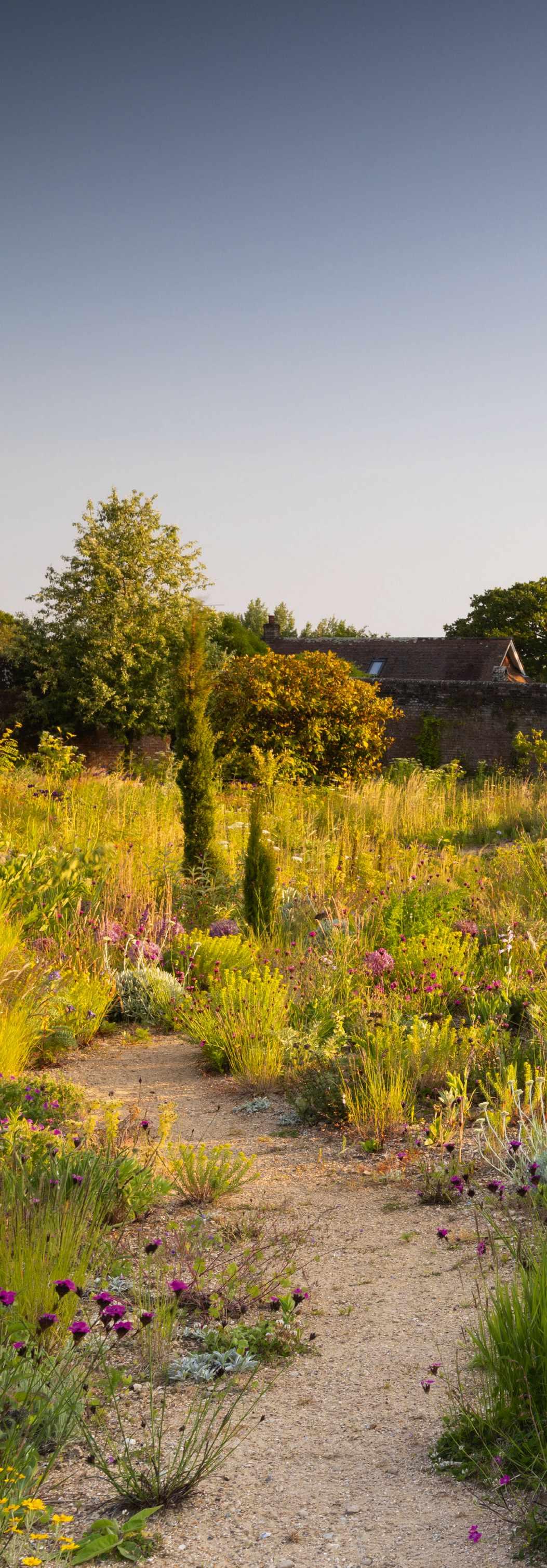
38 Plantprofile: Echinops National Collection holder Andrew Gladman recommends the best of these boldly coloured flowers that are loved by pollinators
54 Coolandunusual The nursery in southwest Scotland that specialises in rare perennial species and ‘fancy’ forms of wild plants
74 The bad and the beautiful Be prepared to rethink your view of weeds with Jacky Mills’ beautiful cut-flower displays, which elevate these uninvited garden guests to undisputed stars
27 Gardeningtalent Meet Anna Mortimer, the gardener responsible for Belmont Estate’s organic fruit and vegetables
66 Who’swho Ecologist Phil Sterling on the importance of bringing more moths and butterflies into our lives
SEE PAGE 20
Display of weeds and wild plants, styled by Jacky Mills, photograph by Éva Németh (page 74)
Dan Pearson, page 28 Rogues gallery, page 74 Knepp, page 82 Bee’s knees, page 94
• Save money when you subscribe to the digital edition of Gardens Illustrated – page 20

• Join us on an exclusive reader day with Tom Stuart-Smith and Charlie Harpur to explore Knepp
Castle Walled Garden – page 92
• Win a trip to Italian garden show Orticolario, by Lake Como† – page 118
† Competition open to UK readers only.
Ngoc Minh Ngo
Ngoc photographs a Dan Pearson design, page 28. “Robin Hill is a spectacular corner of the world, made all the more beautiful by Dan’s sensitive design and head gardener James’s devoted care.”
Andrew Gladman
Andrew explores the variety and beauty of Echinops, page 38. “It’s wonderful to be able to champion these fantastic plants –hopefully I can inspire everyone to add some to their gardens.”
Mark Bolton
Mark photographs a beautiful Welsh garden, page 46. “Louisa’s garden is such a peaceful place that sits perfectly in the landscape – and therefore is an absolute treat to photograph.”
James Basson
James lives in the South of France where he runs Scape Design, a practice specialising in low-maintenance and dry gardens. He is a fervent advocate for creating sustainable landscapes. The winner of four Chelsea Gold medals, he was awarded Best in Show in 2017.




Fergus Garrett
Fergus was appointed head gardener at Great Dixter by Christopher Lloyd in 1993. He is passionate about passing on his knowledge through student programmes at Dixter and worldwide lectures. He was awarded an RHS Associate of Honour in 2008 and an RHS Victoria Medal of Honour in 2019.
Anna Pavord


Anna’s books include her bestseller The Tulip and most recently Landskipping. For 30 years she was The Independent’s gardening correspondent. In 2000 the RHS awarded her the Veitch Memorial Medal. She lives and gardens in Dorset.

Dan Pearson
Dan is one of the UK’s best-known garden designers. Eight of his gardens, including the Tokachi Millennium Forest in Japan, have won awards and he was awarded Best in Show for his garden at Chelsea in 2015. He was awarded an OBE in the 2022 New Year Honours for services to horticulture.

Sarah Price
Sarah is one of the UK’s most sought-after garden designers who gained worldwide recognition for her designs for the 2012 London Olympic Park. She won Gold at Chelsea in 2012, 2018 and 2023, and was GMG Garden Columnist of the Year in 2016 for her design series in Gardens Illustrated
 ANDREW MONTGOMERY ANDREW MONTGOMERY
ANDREW MONTGOMERY ANDREW MONTGOMERY
Subscription enquiries and back issues
UK 03330 162114
USA/CANADA 1 866 464 8103 (TOLL-FREE)
REST OF THE WORLD +44 1604 973722
UK buysubscriptions.com/contact buysubscriptions.com/gardensillustrated
USA/CANADA GILcustserv@cdsfulfillment.com, britsubs.com/garden


UK/REST OF THE WORLD Gardens Illustrated, PO Box 3320, 3 Queensbridge, Northampton NN4 7BF.
USA/CANADA Gardens Illustrated, PO BOX 37495, Boone, IA 50037-0495 USA.
Advertising enquiries
+44 (0)117 300 8805 heather.golden@ourmedia.co.uk
Editorial enquiries
+44 (0)117 300 8622 gardens@gardensillustrated.com
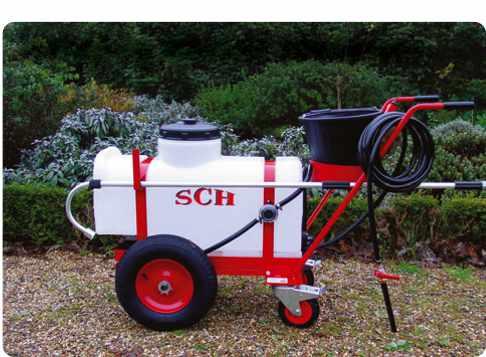
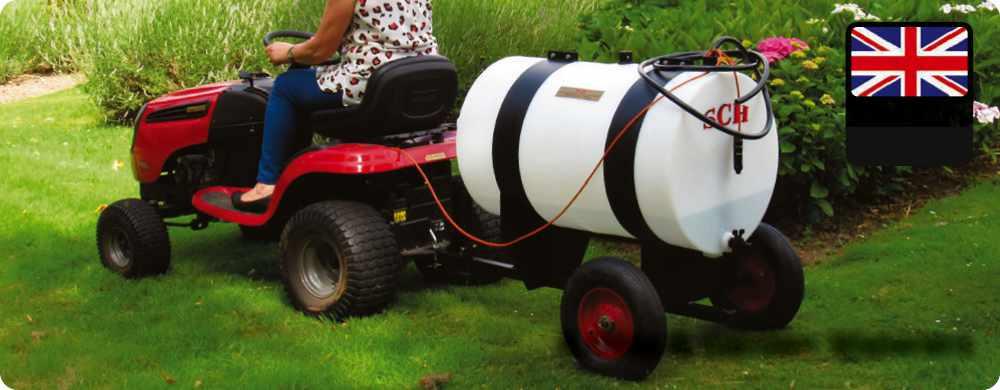
Gardens Illustrated, Our Media Ltd (an Immediate Group Company), Eagle House, Bristol BS1 4ST.

Syndication & Licensing
Gardens Illustrated is available for licensing and syndication. +44 (0)117 300 8787, emma.brunt@ourmedia.co.uk
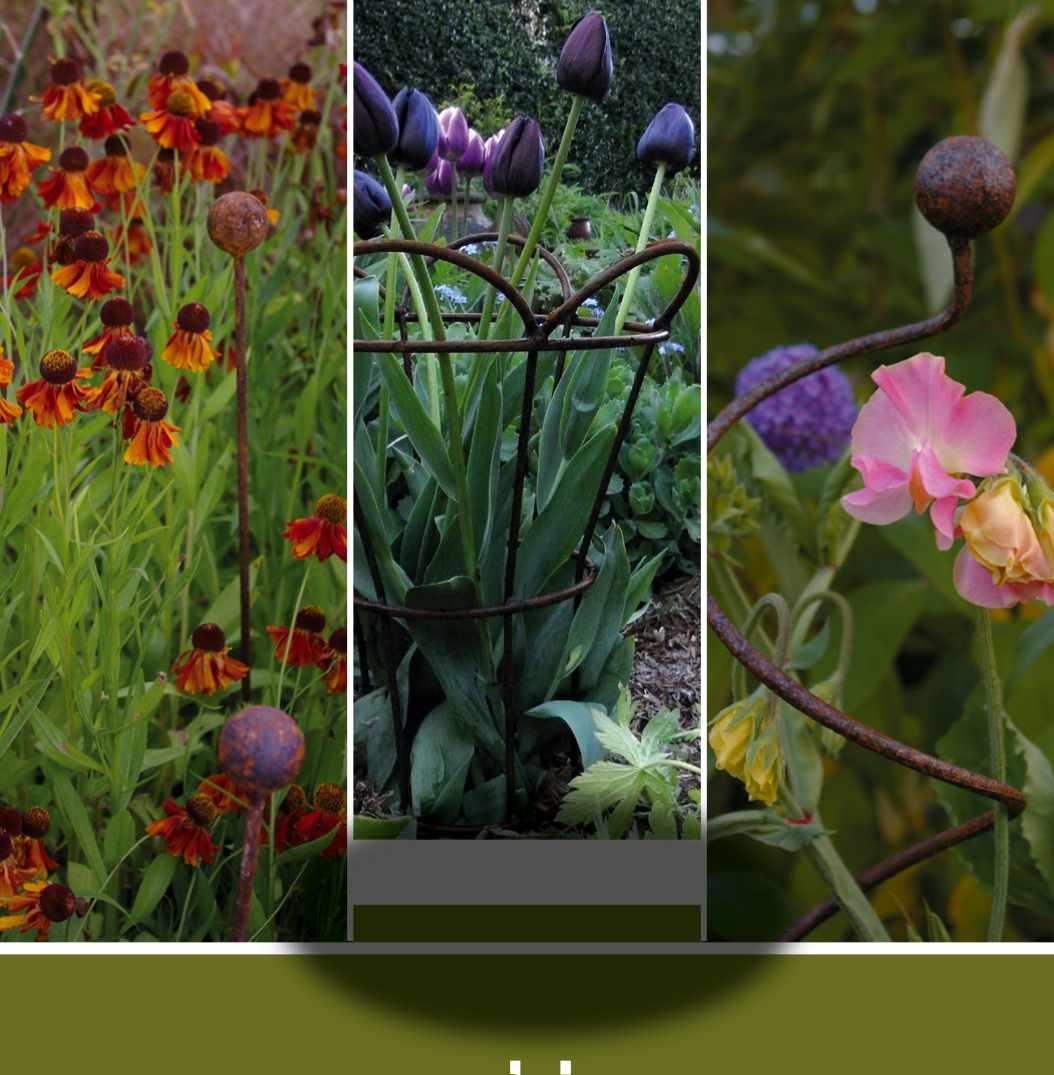
App support

For App support please visit apps.immediate.co.uk/support
We abide by IPSO’s rules and regulations. To give feedback about our magazines, please visit ourmedia.co.uk, email editorialcomplaints@immediate.co.uk or write to Katherine Conlon, Our Media Ltd (an Immediate Group Company), Eagle House, Bristol BS1 4ST.

Editor Stephanie Mahon
Art director David Grenham
Deputy editor Sorrel Everton
Deputy art editor Niki Goss
Production editor Juliet Giles
Digital editor Daisy Bowie-Sell
Commissioning content editor Veronica Peerless
Content producer Molly Blair
Botanical adviser Dr James Compton
Thanks this issue Hilary Brown
ADVERTISING
Group advertising manager Laura Jones 0117 300 8509 laura.jones@ourmedia.co.uk

Portfolio advertising manager Heather Golden 0117 300 8805 heather.golden@ourmedia.co.uk
Advertising designer Parvin Sepehr
INSERTS
Laurence Robertson +353 (0)876 902208

CIRCULATION, MARKETING, PROMOTIONS, PRESS & PR
Newstrade manager John Lawton
Subscriptions director Jacky Perales-Morris
Direct marketing manager Aimee Rhymer
Buyer Karen Flannigan
PR & Outreach Manager for Comms Emma Cooney emma.cooney@ourmedia.co.uk
MANAGEMENT
Chief executive officer Tom Bureau
Group managing director Our Media Andy Marshall
Managing director Our Media Andrew Davies
Head of brand marketing and brand lead Rosa Sherwood
SYNDICATION & LICENSING
Director of licensing & syndication Tim Hudson
PRODUCTION
Production director Sarah Powell
Group production manager Louisa Molter
Production co-ordinator Lauren Morris
As passionate gardeners we know plants are important, but as well as being a source of food and beauty, plants improve air quality and boost the natural environment, they improve mental well-being and enrich communities. In short, people need plants, and plants need horticulturists.
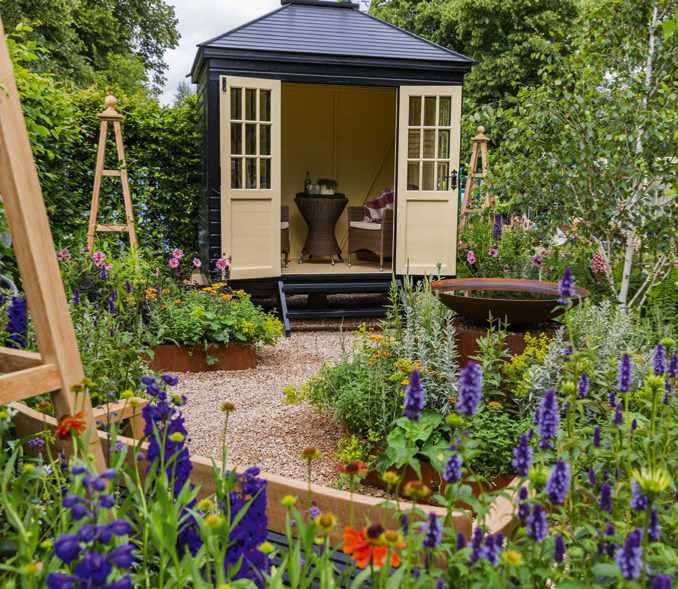
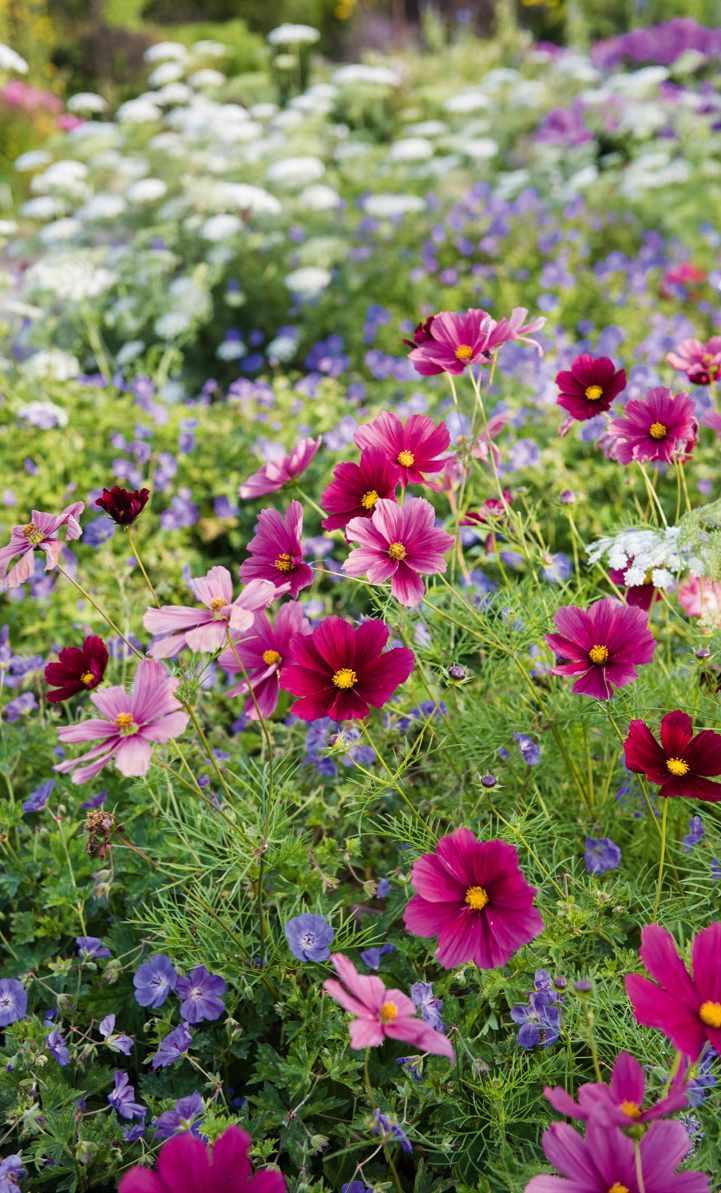
For those with an interest in horticulture or sustainability – as well as gardeners who would like to start, or further, a career in the industry – an RHS qualification is an opportunity to broaden and formalise skills. The RHS Level 2 in Principles and Practices of Horticulture is a deeper dive into the scientific principles underpinning horticultural practices, helping you to progress whether you’d like to change careers, turn a dream garden into a reality, or green an urban space.
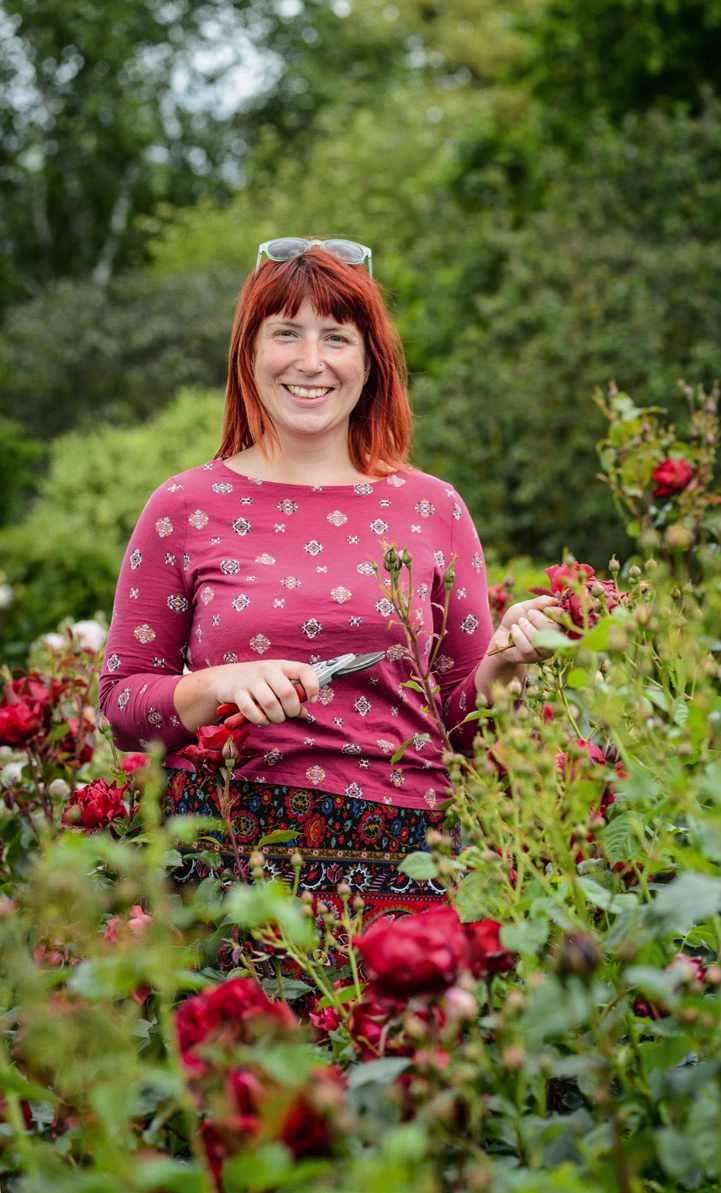
Taught by leading experts, the RHS Level 2 qualification in the Principles and Practices of Horticulture is divided into two sections: the Certificate in Practical Horticulture and the knowledge-based Certificate in the Principles of Plant Growth and Development. Students will benefit from learning essential craft skills, including planting, pruning and maintenance, alongside solid theoretical grounding behind the science of plants, how they function, nutrition, health and adaptations. The course covers a range of inspiring topics,
such as enhancing biodiversity, the impact of climate change, planting style concepts (modern, period and wild), and propagation techniques.
As a highly valued qualification in the horticulture industry, RHS Level 2 can provide students with a helpful nudge forward in career development. Learn how to develop problem-solving skills and make new friends with like-minded gardeners while enhancing your horticultural knowledge and gaining confidence in gardening craft.
Whether you’re a keen hobbyist looking to expand your knowledge or a budding professional aiming to launch a career in horticulture, this course will benefit all gardening enthusiasts. Plus, there are no prerequisites for entry at Level 2, making it ideal for those with some foundational knowledge. To allow students to continue to work or train while they study, RHS qualifications are part-time and designed to be completed over one year. Teaching can be face-to-face at RHS-approved centres, online via distance learning or a blended balance of the two. The course will end with a mix of practical and theoretical assessments and a formal certificate is issued on completion.
Interested in enrolling in a RHS Level 2 qualification? Visit rhs.org.uk/qualifications. Follow @RHS_Learning for more details.

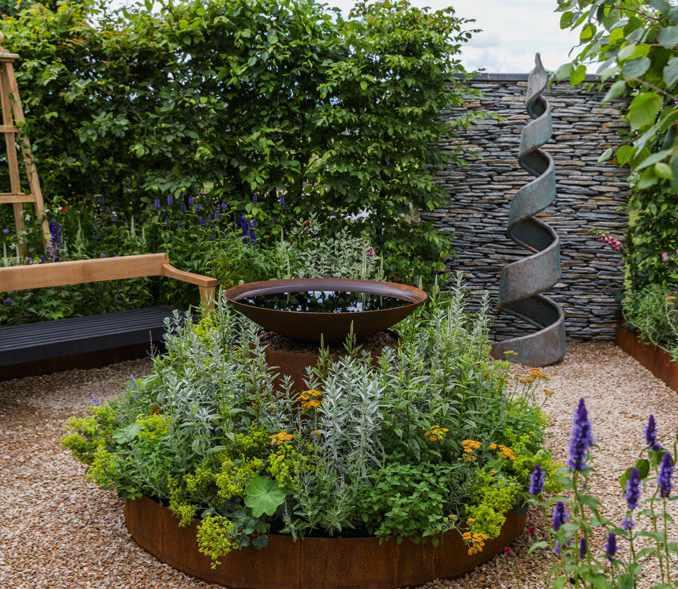
If you’re ready to enrich your knowledge of horticulture, biodiversity and natural habitats, a RHS Level 2 qualification could be for you
Gertrude Jekyll (1843-1932) was one of the UK’s most influential horticulturists. A plantswoman, designer and author, she created some 400 gardens, introduced at least 30 new varieties of plants to British gardens, and was one of the first women to be awarded the Royal Horticultural Society’s Victoria Medal of Honour (along with Ellen Willmott, in 1897). In the 1890s, she began a long professional collaboration with the architect Sir Edwin Lutyens, when she commissioned him to design a house for her, Munstead Wood, near Godalming in Surrey. In the 11 acres of gardens surrounding the Arts and Crafts house, Jekyll experimented with garden design, particularly her innovative use of colour, and laid out a woodland garden that exemplified her approach to artistic ‘wild gardening’. After the house was put up for private sale last year, it was acquired by the National Trust, with government funding. The Trust is fundraising to restore and renovate the garden and house, which it plans to open to visitors. Find out more at gardensillustrated.com/munsteadwood
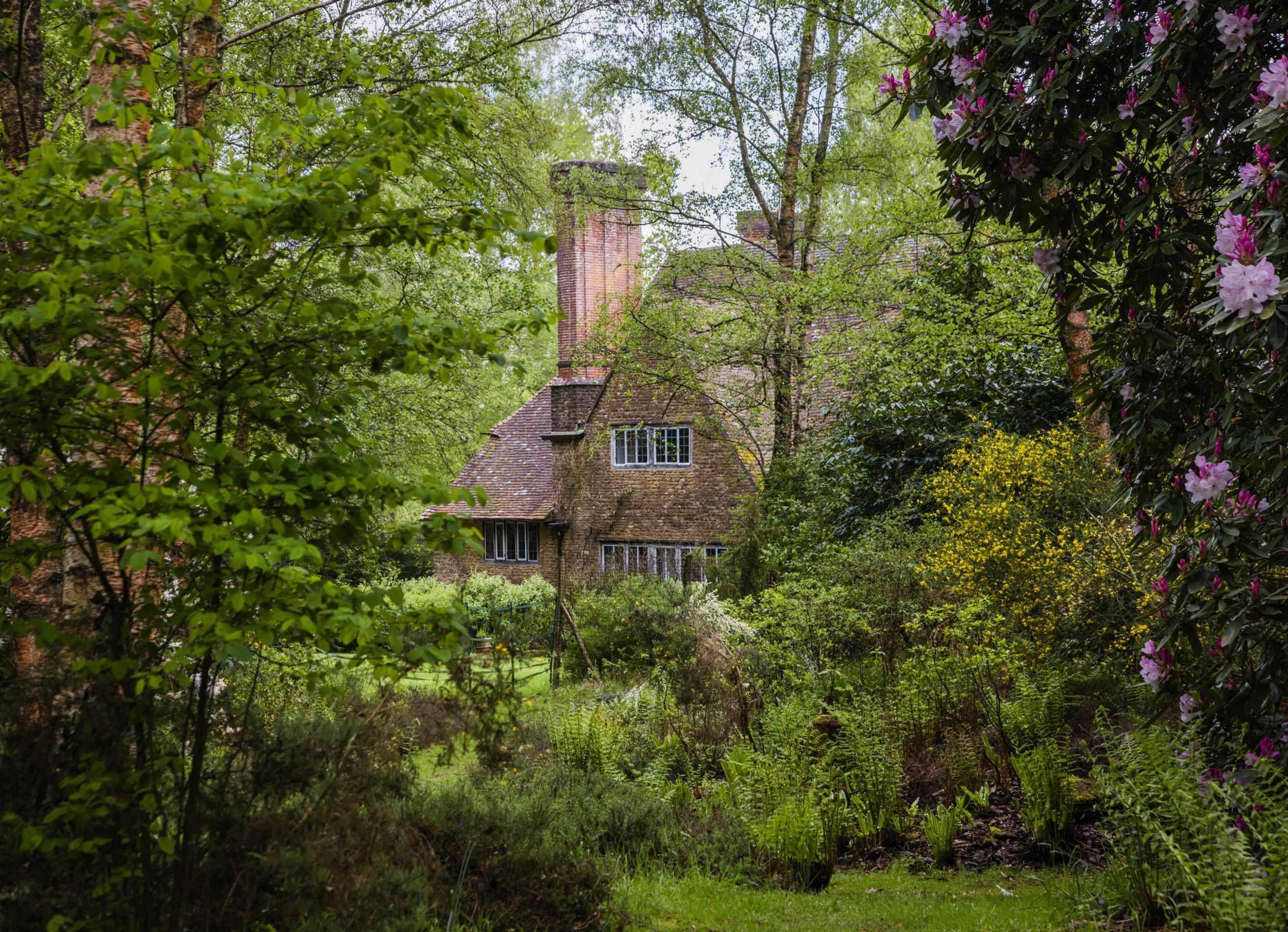
Wild gardens are undeniably a hot topic at the moment. From so-called ‘weeds’ taking centre stage at this year’s RHS Chelsea Flower Show to the garden rewilding project in the Walled Garden at Knepp Castle (see page 82), wild planting is everywhere. Not everyone is excited by the trend. In response to the ‘weeds’ at Chelsea, TV presenter Alan Titchmarsh cautioned against the trend for rewilding, arguing it could pose a risk to the crafts and skills of gardening.
However, when garden coach, author and host of the Gardens, Weeds & Words podcast Andrew Timothy O’Brien (above) spoke recently to Gardens Illustrated, he wondered whether we may need to relinquish even more control over our borders and be a little more tolerant of the plants we currently think of as ‘weeds’.

“We’ve been taught to despise them, rooting them out or poisoning them at every opportunity,” he said.“We spend time, money and energy pulling out those plants perfectly adapted to grow well in our soil, to replace them with expensive introductions that need coddling.” To read more of Andrew’s thoughts on garden rewilding, scan the QR code below with your phone’s camera or head to gardensillustrated.com/howwild

All three of the young designers competing for the coveted RHS Young Designer of the Year Award at this year’s RHS Flower Show Tatton Park (19-23 July) have included an air of wildness in their gardens. “I find wilder gardens that imitate nature more tranquil,” says Camellia Hayes, whose garden, Seeking Resilience, creates an enveloping, nurturing space in which native wildflowers, such as wild carrot, teasels and knapweed, mix with ornamental grasses to create a sense of nature reclaiming a small pocket park. Native wild plants also feature in Ollie Pike’s garden for the Bible Society, which takes its inspiration from the wildflower meadows that are often found in churchyards across the UK; while Nathan Webster’s woodland-style garden, Off the Grid, makes use of green, textured plants, such as ferns and nettles, and aims to show how an individual can live off-grid within nature. rhs.org.uk
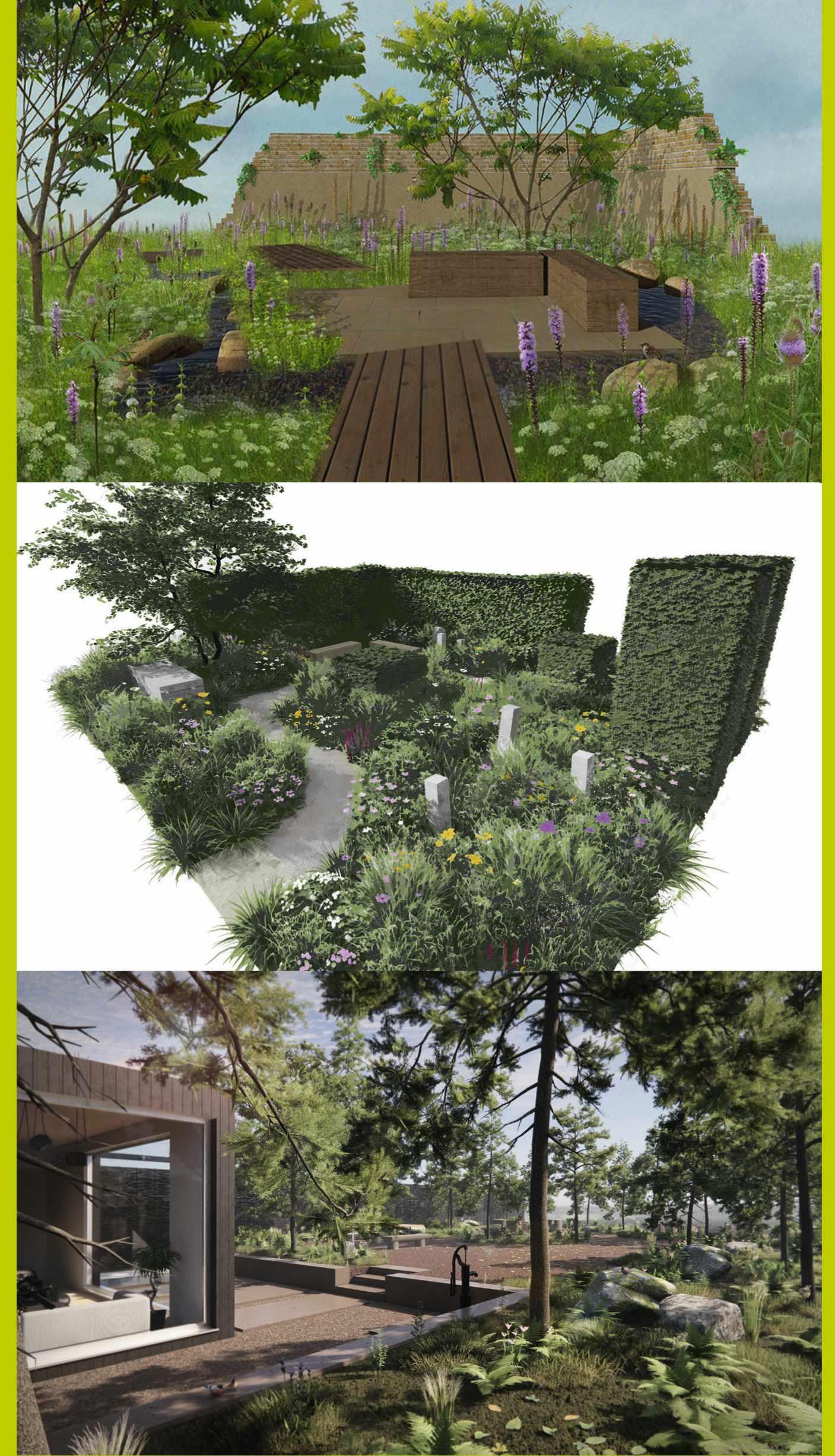
Greener cities Planning permission has been granted to Mowat & Company to create a tiny forest at the junction of Kingsland Road and Forest Road in Dalston, east London. The Forest Garden, which will sit at the heart of a new mixed-use development, will feature a diverse selection of trees chosen for their resilience, underplanted with a seasonally changing woodland carpet of ferns and other shade-loving plants, including UK natives such as English bluebells, wood anemones, primroses and wild garlic. mowatandco.com

British speakers, including Tom and Sue Stuart-Smith, Nigel Dunnett and Noel Kingsbury, will join other designers and gardeners in Mannheim, Germany, for a new international symposium, titled The Dynamic Vision – Designing and Maintaining Naturalistic Plant Communities, on 24-25 August. The two-day event, organised by a team including landscape architect Bettina Jaugstetter, forms part of the Bundesgartenschau (German National Garden Show) or BUGA for short, which runs until 8 October. Tickets cost €350, which includes entry to BUGA. gds-staudenfreunder.de

JULY No Dig Day Course
Discover the basics of Charles Dowding’s no-dig method on this one-day practical introduction.
Sunday 23 July, 10.30am-4pm. £195. Homeacres, Alhampton, Shepton Mallet, Somerset BA4 6PZ. charlesdowding.co.uk
JULY
Guided Garden Walk

Explore the walled and woodland gardens of Logan Botanic Garden. Tuesday 25 July, 10.30am12pm. £2.50 (plus entry for non-members). Port Logan, Stranraer, Dumfries and Galloway DG9 9ND. Tel 01776 860231. rbge.org.uk
You can find lots more events to enjoy this summer by going to our online diary. Scan this QR code with your phone camera or go to gardensillustrated. com/events
AUGUST Garden Design Workshop Join a half-day introduction to design.

Sunday 6 August, 10am-12.30pm or 1.304pm. £50. RHS Garden Bridgewater, Occupation Road, Worsley, Salford, Greater Manchester M28 2LJ. Tel 0161 503 6100, rhs.org.uk

Encourage someone to create their own mini wildlife sanctuary with the new Wildlife Garden seed kit from Seed Pantry. Each box includes seeds of four summer-flowering plants – cornflowers, globe thistles, verbena and foxgloves –that feature on the RHS’s plants for pollinators list and so provide essential food for bees, butterflies and other important pollinators. The kit costs £14, and also includes compost discs, four biodegradable husk pots and plant markers to get them started. seedpantry.co.uk
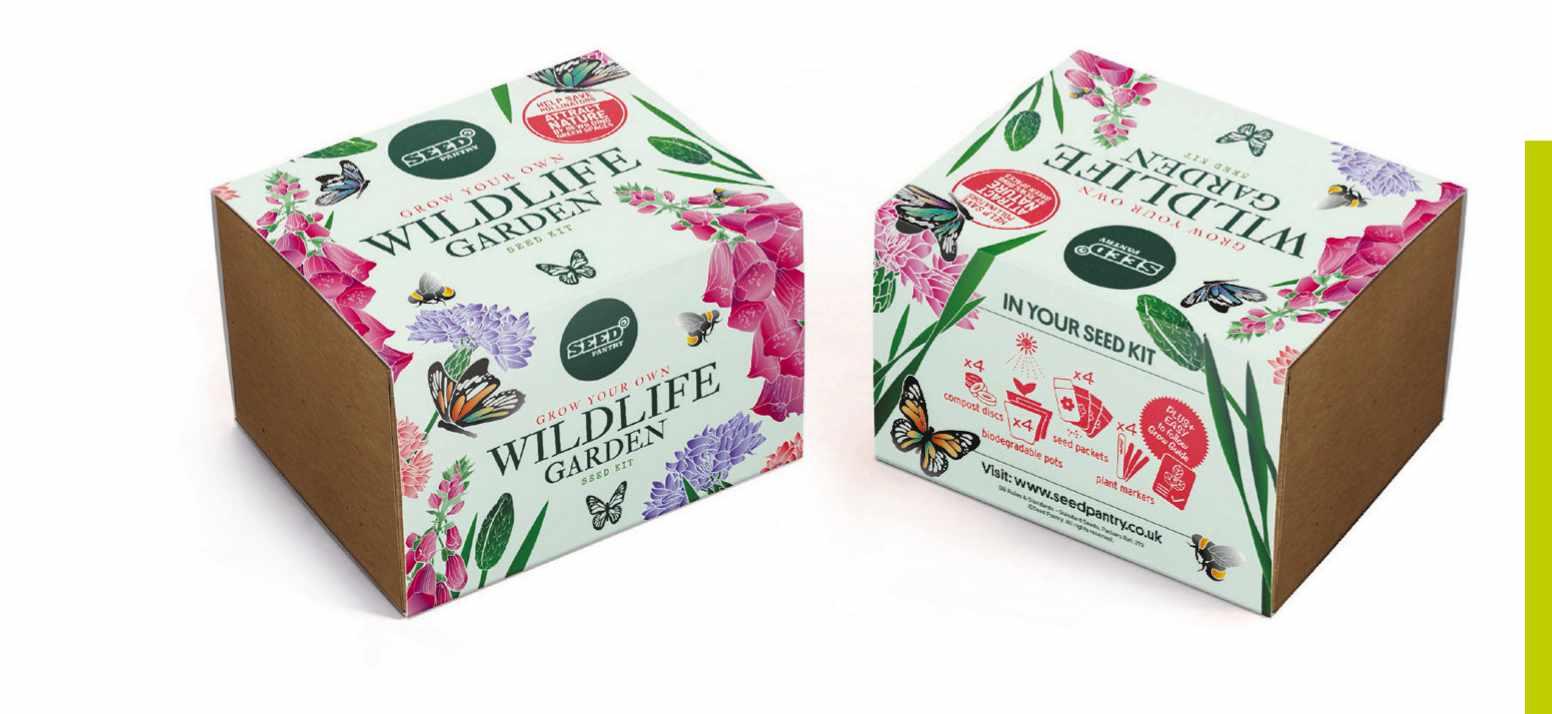
Our peatlands play such a huge part in protecting the environment – storing carbon, providing habitats for wildlife and preventing flooding – that helping to protect them by reducing and removing peat from horticulture is becoming increasingly important. So it’s great to see that The Little Botanical (thelittlebotanical.com) has introduced a peat-free range of houseplants that includes crotons, calatheas, asparagus ferns and Boston ferns. This welcome new range comes hot on the heels of the launch of Geb & Green (gebandgreen.co.uk), which is growing peat-free houseplants on a large commercial scale in a recycled growing medium. Both join the excellent Harriet’s Plants (harrietsplants.co.uk), which has long been a front-runner in growing peat-free houseplants.
CAMOUFLAGED
Browning Recon Force Elite HP5, £184.99, NatureSpy, 01978 437837, naturespy.org

STARTER
Garden Wired Wildlife Camera Kit, £112.99, UK Wildlife Cameras, 020 3727 5239, ukwildlifecameras.co.uk
TWITCHER
RSPB WiFi Camera Nest Box System, £220, RSPB, 0345 034 7733, shopping.rspb.org.uk
Find more wildlife cameras for your garden by scanning this QR code with your phone camera, or visit gardensillustrated.com /wildlife-camera

Seedling trowel Fiddly planting jobs just got a little bit easier with this new seedling trowel from Greenman. Made from mirror-polished stainless steel and featuring a depth gauge, it’s perfect for planting out plugs, seedlings, seeds or small bulbs and costs £13.95.
greenmangardentools.com
dive into nature
Come and swim at one of our swimming pond open days this summer. See gartenart.co.uk
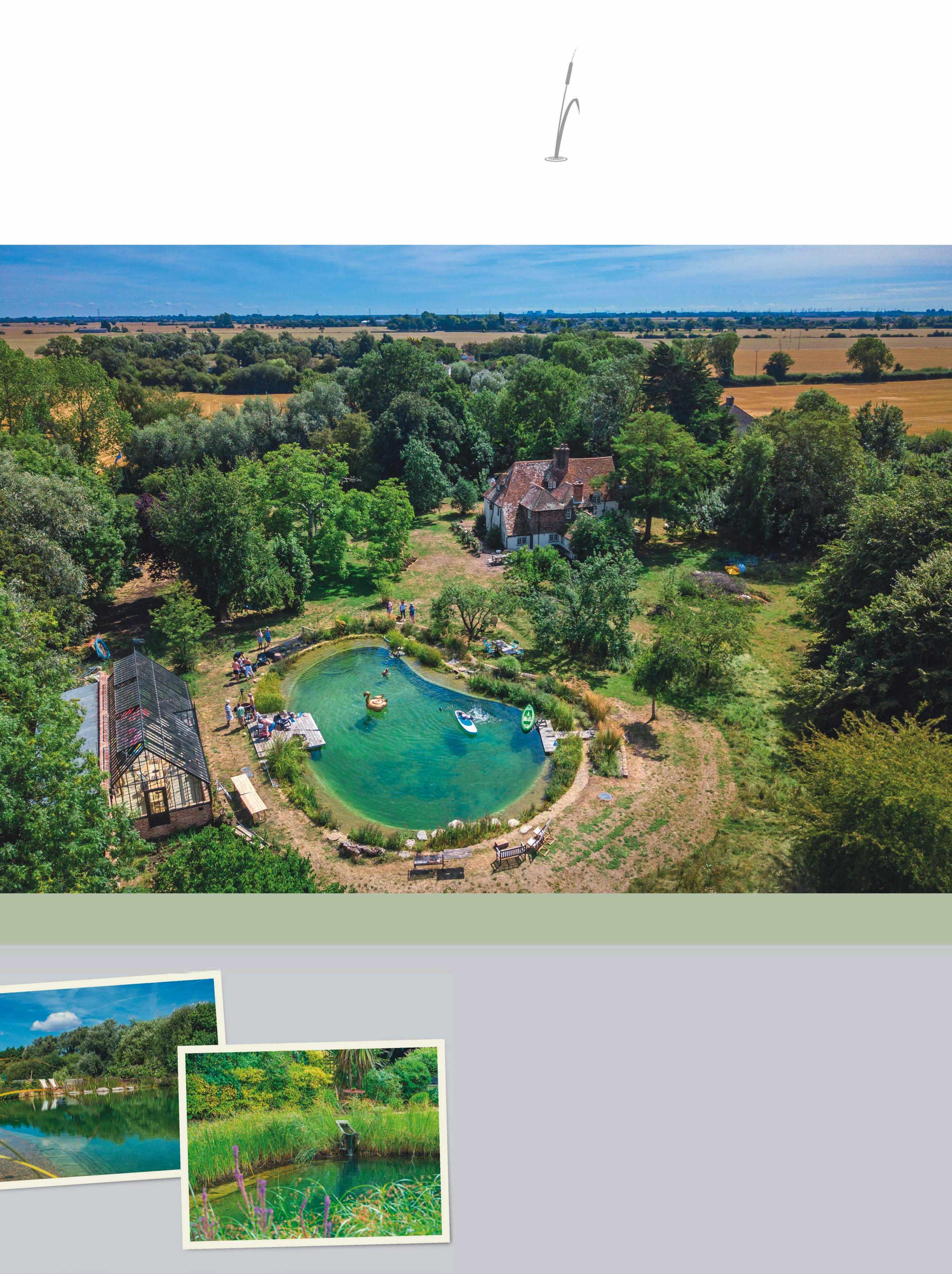
"I always say it's the best thing we've done. But it's more than just the swimming. It's such a beautiful thing to have and every season it looks a little bit different, you see all the plants coming up and they flower at different times."
Hugo and Fran Warner - Kent
Gartenart Swimming Ponds
Unit 112 Screenworks, 22 Highbury Grove, London N5 2EF 020 7183 3333 www.gartenart.co.uk

For a low-impact, sustainable, wildlife-friendly garden
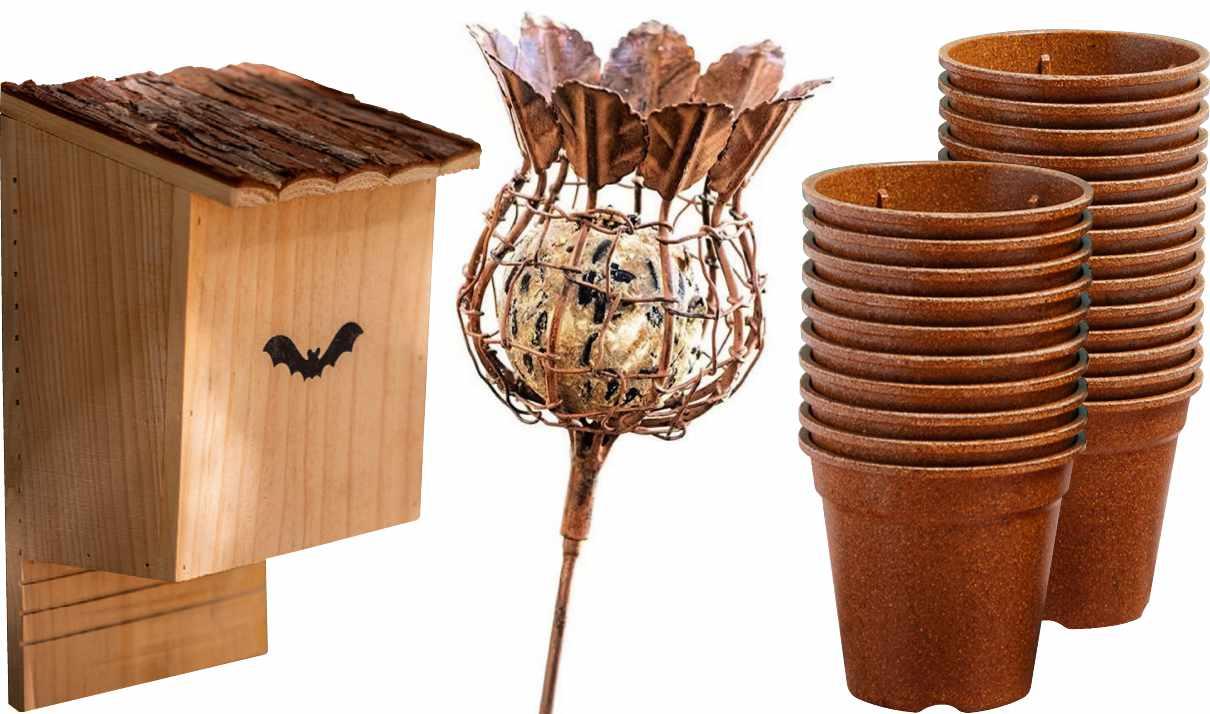


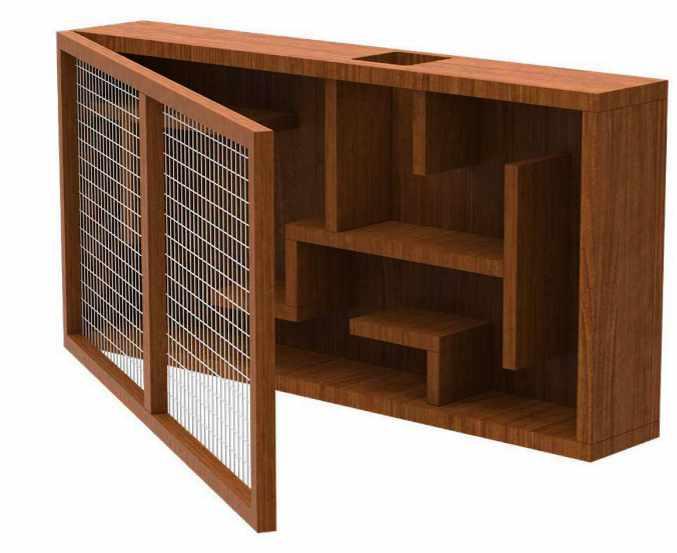
 COMPILED BY MOLLY BLAIR
COMPILED BY MOLLY BLAIR
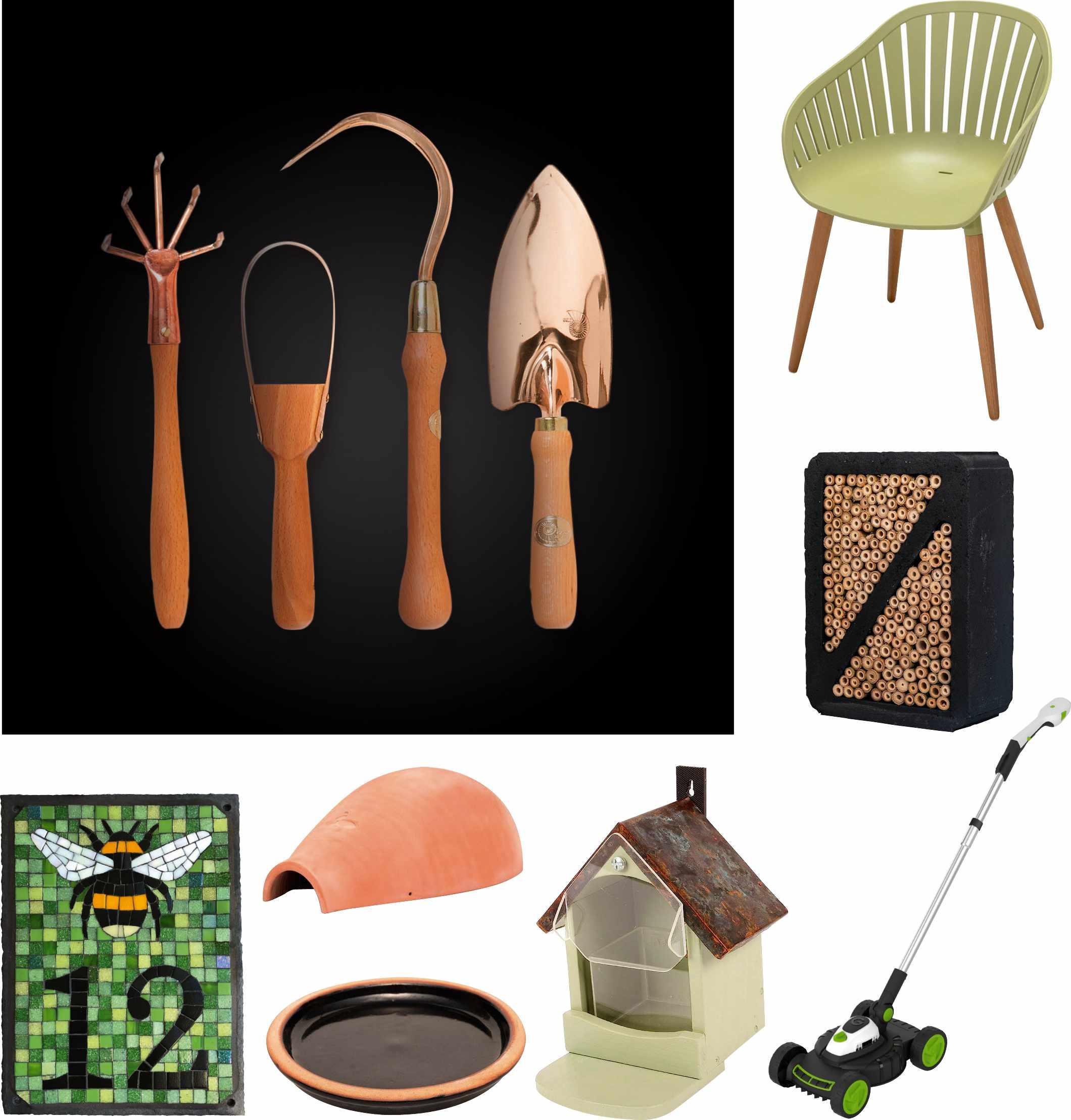 1. Copper Hand Tools – Lyra 5-Claw Weeder, £53, Nunki Weeder, £35, Corvus Weeder, £53, Castor Trowel, £41, all 01628 958888, implementations.co.uk
1. Copper Hand Tools – Lyra 5-Claw Weeder, £53, Nunki Weeder, £35, Corvus Weeder, £53, Castor Trowel, £41, all 01628 958888, implementations.co.uk
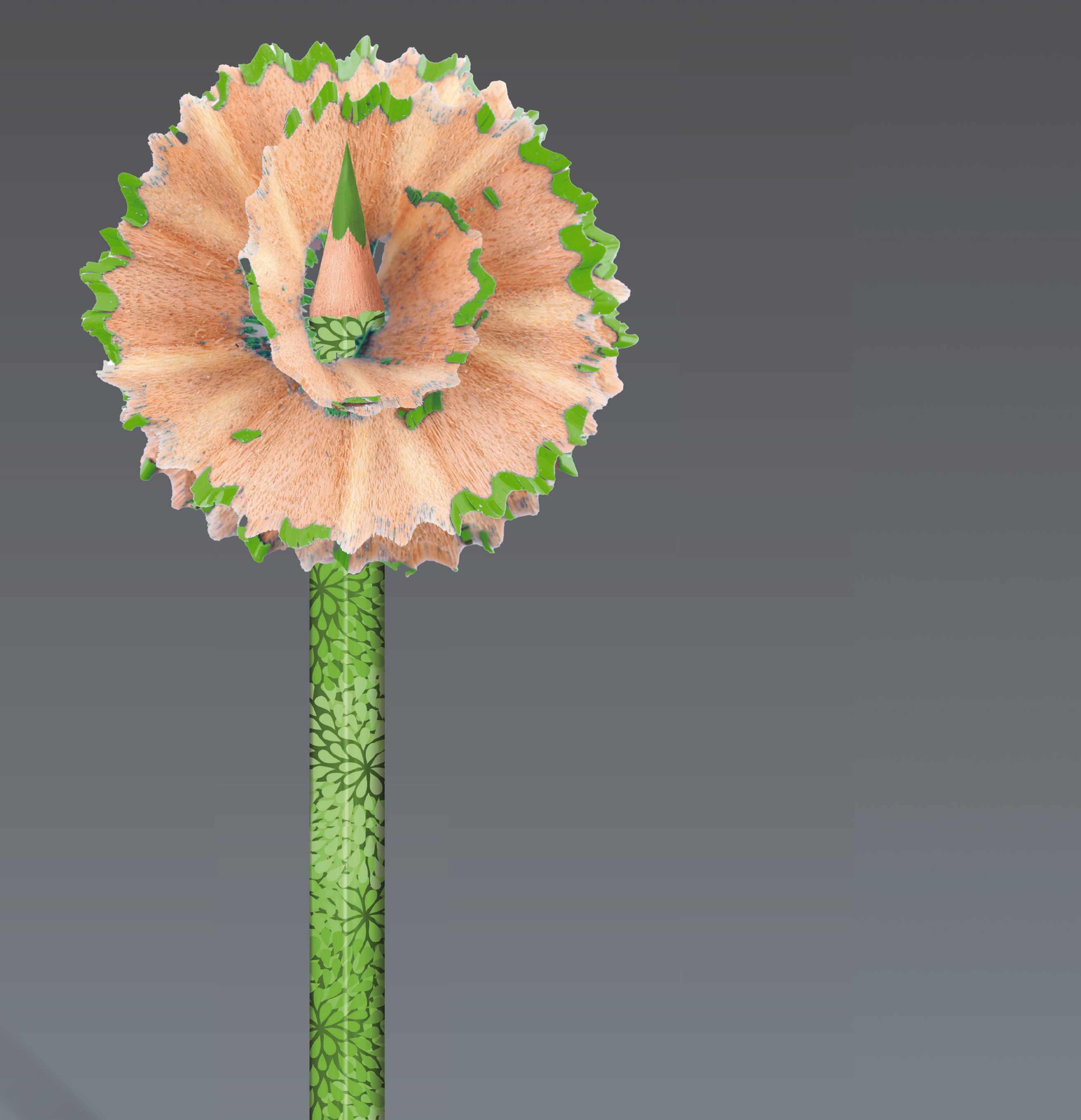
Many leading garden designers were at Inchbald and help our current graduates with their careers
Inchbald is one of the most established garden design schools in the world. For over 50 years we have been creating successful design careers.
So many of the world’s leading designers are Inchbald graduates. They have all benefited from the high standard of tutoring on which the school’s reputation is built.
Now they help our current students on their pathway to success by offering advice, internships and frequently employment. Find out more visit inchbald.co.uk today.

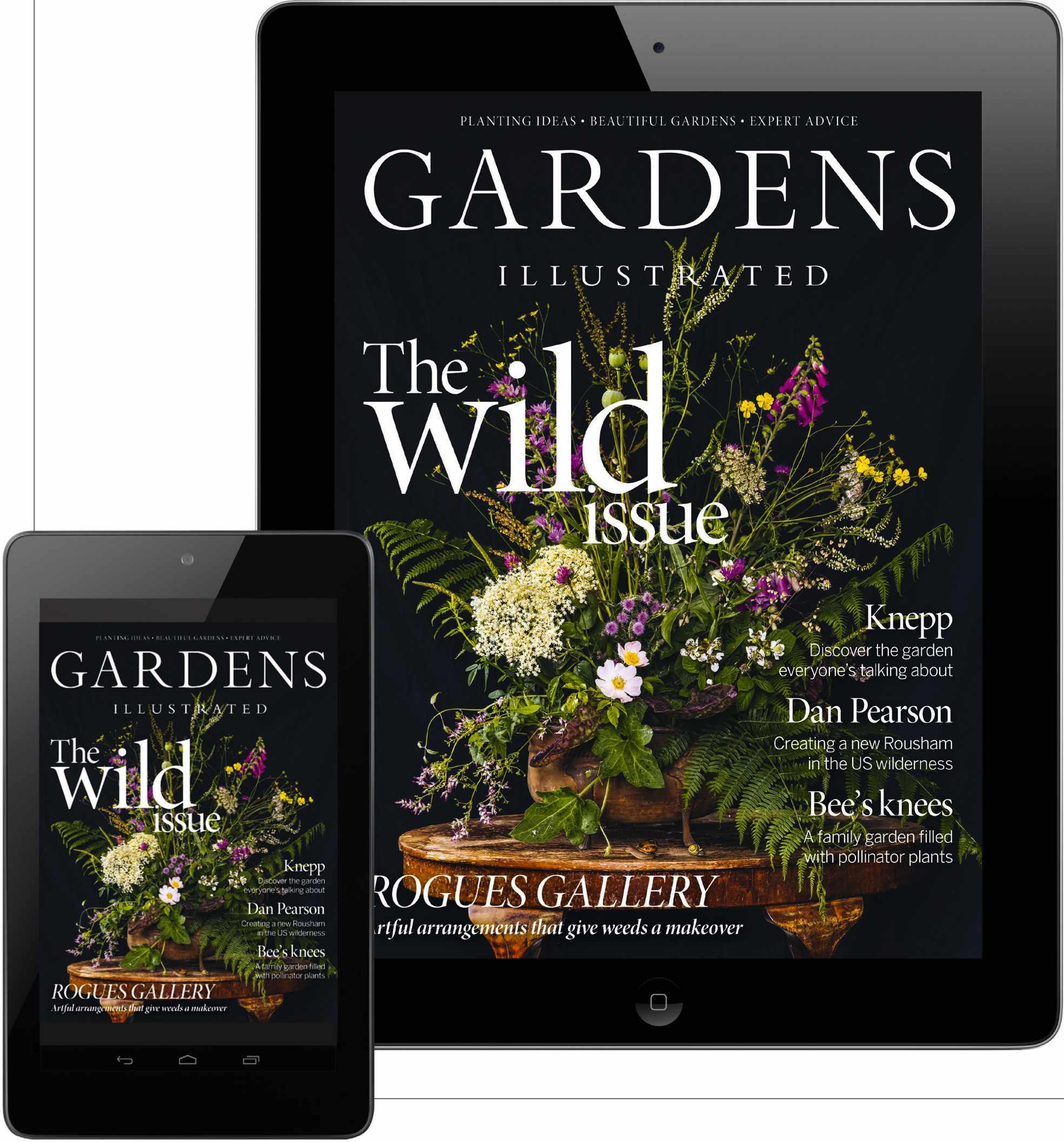




TIMELESS CLOTHING & EQUIPMENT TO CARRY YOU THROUGH THE SEASONS carriercompany.co.uk
always made in the uk

How wild is wild in the context of the average garden? And should we all be gardening differently to encourage more wildlife? Ken Thompson looks into the role gardens play as habitats for creatures great and small
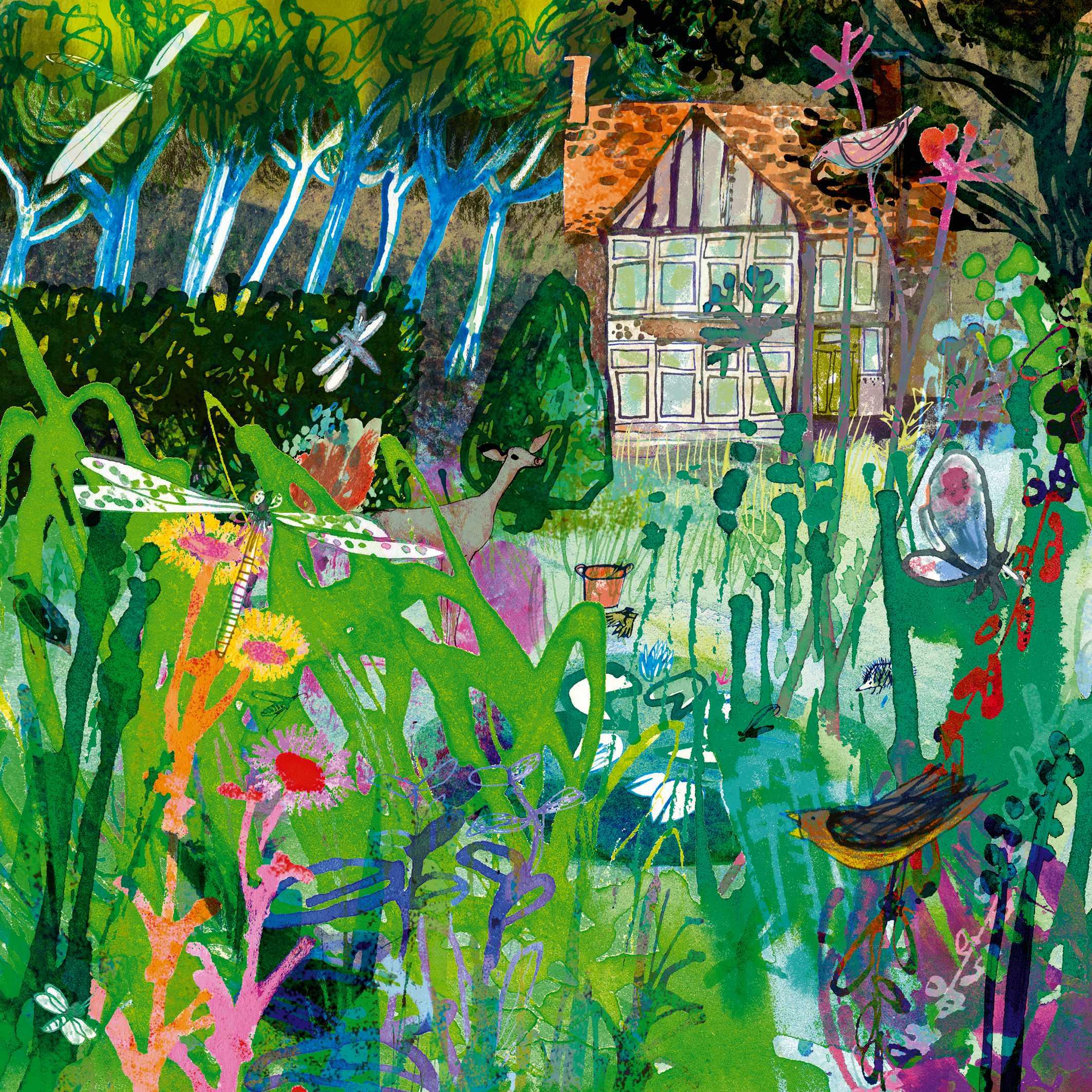 ILLUSTRATION JILL CALDER
ILLUSTRATION JILL CALDER
As you can’t fail to have noticed, rewilding is everywhere. But what exactly does it mean for gardeners? One problem is the word itself, which is so elastic that it can mean almost anything, depending on whom you talk to. If you could eavesdrop on ecologists arguing about rewilding, you might find them debating the pros and cons of reintroducing carnivores such as wolves and lynx to the UK – in other words, not a conversation of any great interest to the average gardener.
A common thread in any discussion of rewilding is an increase in wildness, although ‘wild’ itself is another word that no two people can agree on. It’s perhaps better, because it’s more concrete, to talk about the withdrawal of human influence. In short, more human influence equals less wildness. But in a gardening context, what doesn’t look at all wild to you and me can look surprisingly wild to the wildlife itself.
Any impartial observer would surely agree that the average garden is the product of some fairly intensive human effort. Few things are less
wild than a herbaceous border, and it is thought that the result of the complete withdrawal of human influence from a garden would, before very long, be a wood. Indeed, one definition of gardening could be the maintenance of a state of permanent succession, constantly countering the tendency of progression towards a climax woodland.
Even the ‘wild’ habitats created by some gardeners, such as wildflower meadows, are very far from being truly wild. Real agricultural meadows are the product of decades or even centuries of human management, and the creation and maintenance of a garden meadow requires just as much effort as any other part of the garden. If this effort is withdrawn, a meadow would rapidly succumb to invasion by trees and shrubs.
Ecologist Jennifer Owen spent 30 years monitoring the wildlife of her suburban garden in Leicester, starting in 1972, and it remains to this day one of the very few gardens for which we have even a partially complete wildlife inventory.
Two things stand out from Owen’s study. One is the astonishing biodiversity her garden supported – whether we look at butterflies, hoverflies, bees or ladybirds, somewhere between a fifth and half of all the species known to occur in the UK turned up at least once. The other notable finding is that all this happened without any attempt to create any kind of ‘wild’ habitat.

In other words, Owen’s garden was a garden, pure and simple, with all the things you would expect to find in a normal suburban garden, and nothing else. If all that wildlife was happy to inhabit, or at least visit, her garden, that must be because gardening provides suitable habitats for the wildlife to feed and, very often, also to breed.
Less human influence means, often surprisingly quickly, more trees and shrubs. And one of the consistent findings of all comparative studies of garden wildlife is the importance of the quantity of vegetation. Gardens with more trees, more large shrubs and more hedges support more wildlife than gardens with fewer large woody plants. This is hardly surprising: plants are the foundation of the garden food web, and a greater volume of vegetation means more food for herbivores
and more habitat for wildlife of all kinds. In the light of this, you might reasonably ask if a handsoff approach (resulting in succession to closed woodland), would necessarily be a bad thing; if trees are good, maybe more trees are even better?
The answer is categorically no. From a wildlife perspective anyway – the result of such a process wouldn’t look much like a garden. Of course, woodland has its own rich wildlife, but little of it is the same as that supported by a garden, most of which would be lost. To make only the most obvious point, conversion to woodland would be disastrous for most pollinators. Apart from a brief spell in spring, the average woodland provides little in the way of flowers.
The default state of the average garden is rather open and disturbed, with relatively little tall vegetation. So more trees and shrubs extend the range of habitats available, which is normally good news for wildlife, but if we keep adding trees we soon run into diminishing returns.
The juxtaposition of open, warm and sunny conditions with damp and shady areas is one of the things that makes garden wildlife so diverse, so too many trees risks losing what makes gardens special in the first place.
In the final analysis, gardens are rich in wildlife not despite gardening, but because of it. Of course, as in any habitat, the character of the wildlife present is dictated by the nature of the habitat, and garden wildlife doesn’t have much in common with that of, say, chalk grassland or ancient woodland. But the answer to that conundrum is not to try to create facsimiles of such ‘wild’ habitats in gardens, but rather to protect the remaining examples of the real thing in the wider countryside. And meanwhile, carry on gardening. ■
• Dr Ken Thompson is a plant ecologist known for his scientific and practical approach to gardening. He is author of books on invasive species, biodiversity, wildlife gardening, weeds and compost making.
Gardens are rich in wildlife not despite gardening, but because of it… The juxtaposition of open, warm and sunny conditions with damp and shady areas is one of the things that makes garden wildlife so diverse



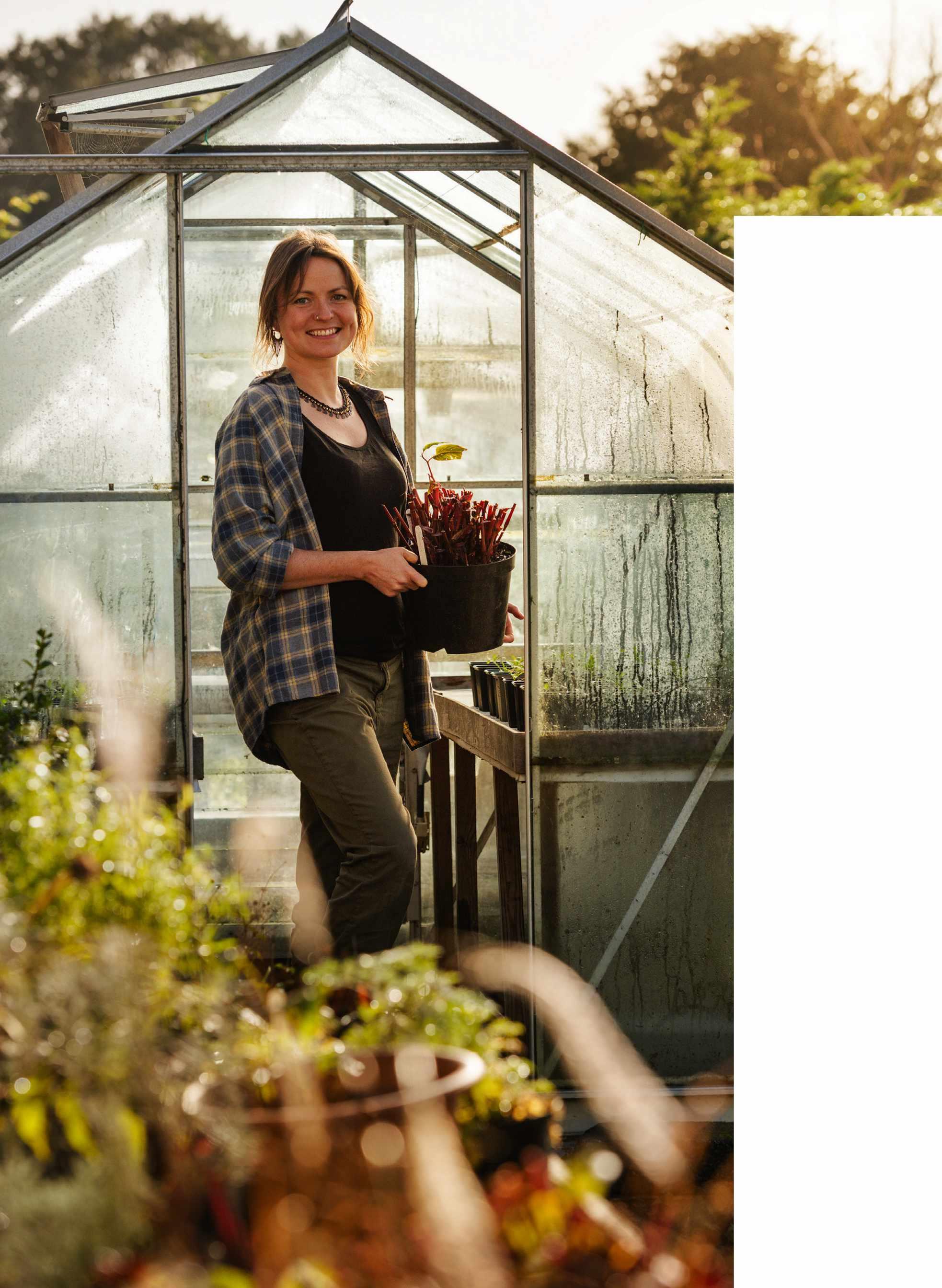
If gardening is a career change, what did you do before?
I worked as a project co-ordinator for a charity focusing on international voluntary youth projects. I took a career break to take part in one of these projects and spent six months in Chiapas, Mexico, helping to set up a centre for permaculture and environmental education. Being in close contact with the natural world made me realise I wanted to work outside. That was the start of my journey into horticulture. Horticultural heroes Some of the people I admire most are those who have either brought about a shift in attitudes or have excelled in their field, be that plantsmanship, design or the craft of gardening. Some names that spring to mind are visionary 19th-century gardener William Robinson; the late Christopher Lloyd and Great Dixter’s head gardener Fergus Garrett; the late plantswoman Beth Chatto; Gravetye Manor’s Tom Coward; no-dig pioneer Charles Dowding; horticultural ecologist James Hitchmough; designer Dan Pearson; and planting-design expert Nigel Dunnett.
Favourite landscape I visited the Dolomites in Italy last summer and the diversity of the flowers on the high alpine pastures was like nothing I’ve seen before. It really brought home to me that we need to do more to preserve and restore our biodiversity here in the UK.
Three most worthwhile tips for every gardener Experiment, try new things, make mistakes; it’s a great way to learn. Garden from the soil up – get to know your soil and what its limitations are, then work with plants that thrive under those conditions; it will save you a lot of work. Find a balance between planning and responding to what’s going on in front of you – both approaches hold a lot of value.
Favourite planting style I’m a fan of wilder, naturalistic planting. I think it’s especially effective when balanced by elements of formality in a garden – a mown edge to a meadow or topiary and hedging to provide winter structure.
What principles have guided your attitude to gardening?
We can learn a lot from observing how plants grow in the wild. Remembering that plants don’t exist in isolation but are part of a wider ‘garden system’ can guide decisions and help us to tread more lightly in the environment.
Do you have a future focus for Belmont Estate? Over the next few years I’ll be focusing on developing the gardens and grounds. My aim is to make the estate feel special; I’d like to contribute to it being a place where people can connect with the natural world in meaningful ways. I hope that this will include delivering community sessions and helping to get people excited about nature and gardening.
Contact Instagram: @plantsnwilds
To find out more about the rewilding project at Belmont Estate in Somerset, and its community and education experiences aimed at encouraging a better connection with nature, go to belmont.estate
Remembering that plants don’t exist in isolation can help us tread more lightly in the environment
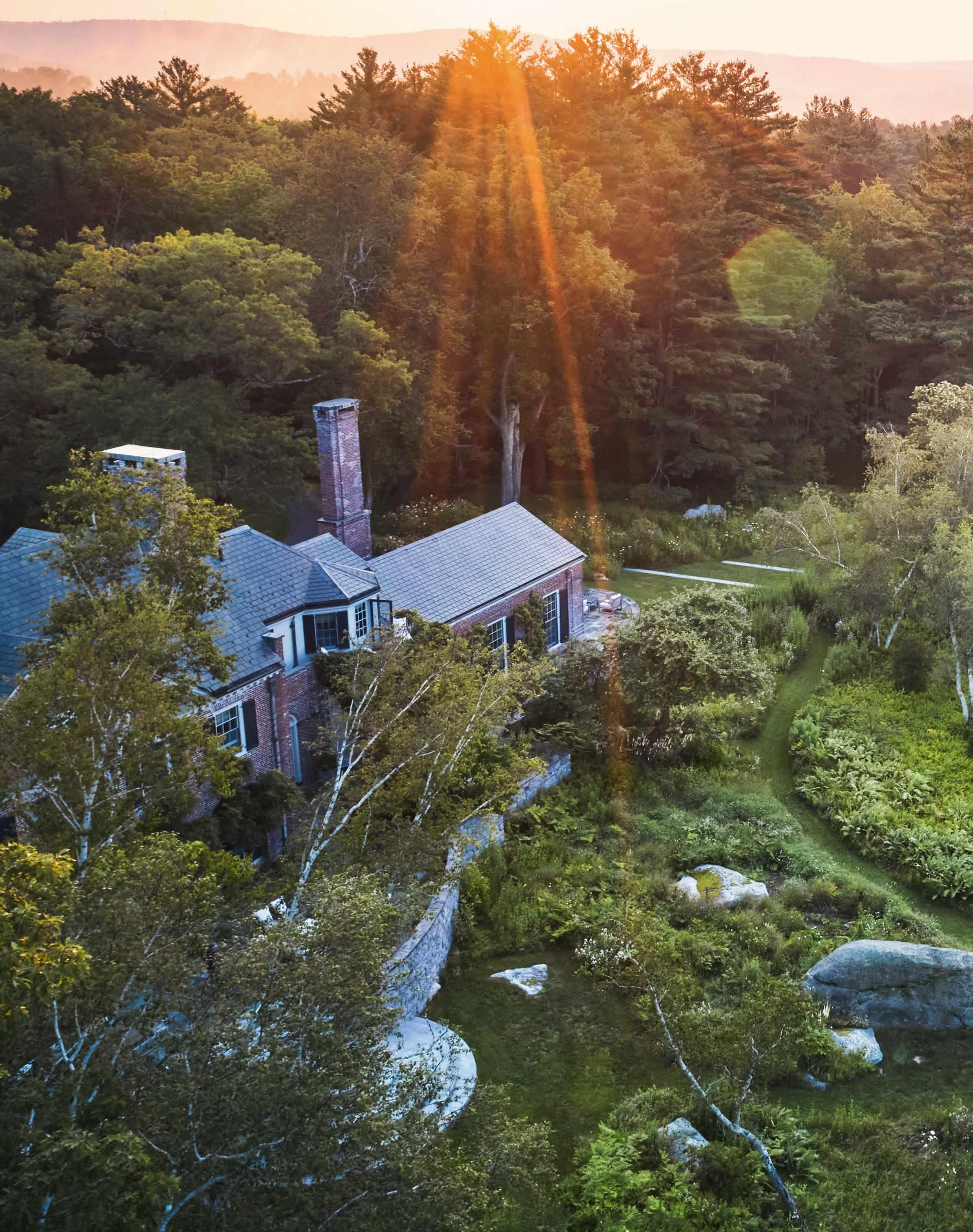
With an almost imperceptible hand, designer Dan Pearson has conjured a dramatic landscape garden from 20 acres of Connecticut wilderness
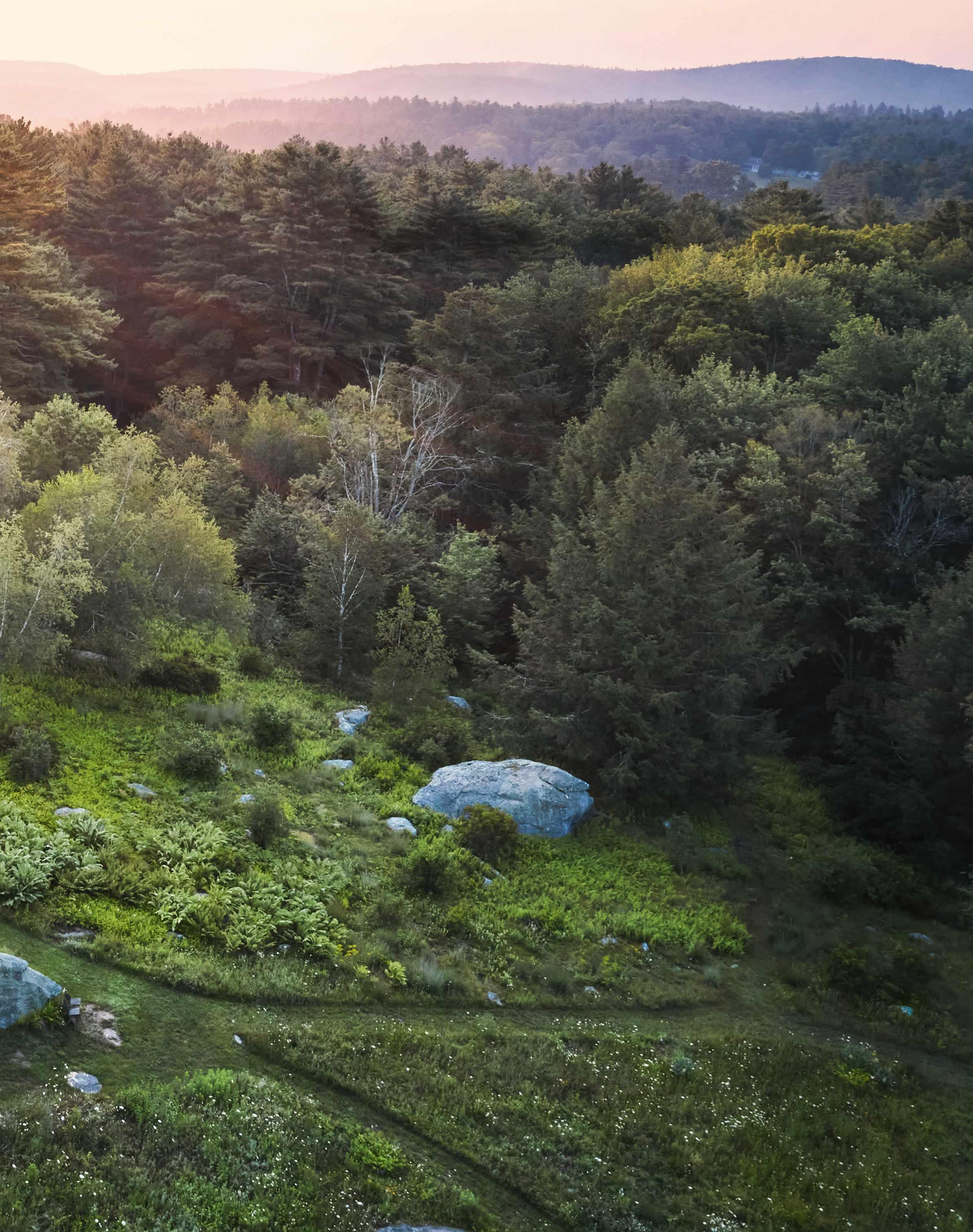
WORDS KENDRA WILSON PHOTOGRAPHS NGOC
Name Robin Hill. What Sweeping garden landscape around a 1920s house. Where Connecticut, USA. Size 20 acres. Soil Acidic and dry, thin and rocky in the meadow, richer in the woodland, long-cultivated in the cutting garden. Climate Winters in New England can be very cold, and the nearby town of Norfolk is known as ‘the icebox of Connecticut’, with a short growing season (five months) and cool evenings in summer, due to its altitude. Hardiness zone USDA 5.
When Dan Pearson first began work at Robin Hill, an estate in the wilds of northwest Connecticut, the pretty, 1929 house was cut off from its surroundings with encircling walls. Dan drew desire lines, which became a series of walks, breaking out from the east-west axis of the house and heading south into the meadow.
I’d hesitate to call it a garden,” Dan Pearson says regarding Robin Hill, a 20-acre property in Connecticut that his studio has been steering for the past decade. Although there are set pieces (a herb garden to one side of the house, an enclosure with a circular pond by the entry court), even the cutting garden is so removed from the idea of ‘a garden’ that it is hidden in summer behind a wavy edge of Calamagrostis x acutiflora ‘Karl Foerster’, its boundaries dictated by a pre-existing stone wall. To the occasional visitor, Robin Hill betrays none of the breathless industry of some conventional gardens; instead, all is serene. This is remarkable, given that it could have gone so wrong.
In the winter that Susan Sheehan, a New York art dealer, fell for the neglected but pretty 1929 house, she and partner John O’Callaghan were beguiled by the snowy scene. Dan takes up the story: “When the landscape awakened in spring, Susan was confronted by this enormous amount of growth coming from everywhere, and became fearful, in terms of her responsibility.” The property backs on to 6,000 acres of restored forest, and the fact of a very real and encroaching wilderness was a shock. “One night we saw a mountain lion attacking a deer on the back field,” says Susan.
Dan’s 2009 book Spirit: Garden Inspiration was what inspired his prospective client to hire him;
she knew nothing of his design work. When Dan in turn asked Susan to gather some pictures that inspired her, she sent him a 250-page document, which he compares to the art critic John Berger’s Ways of Seeing. At the end of this visual journey, she had written: ‘And I don’t think I want a garden.’
Dan saw that she wanted an environment rather than something that would look highly tended. “The work we do is always about sense of place but it’s just as much about the people who occupy it, and how you can make it resonate for them,” he says. “Our role as designers here was to ease her into this place and make her feel less fearful.”
The New England landscape is alive with ghosts, some of which are evoked in low farmers’ walls running through reclaimed woodland. At Robin Hill, older remnants are muddled with the marks of more recent owners, including an interior designer in the 1980s, whose green and white garden was “famously tasteful”. Someone down the line must have shared Susan’s fear of wilderness, building high walls in the entry court and securing the terrace with a parapet wall. “It was like being on an ocean liner,” recalls Dan. “It was a ‘don’t jump’ situation.”
Once Susan was persuaded that these barriers needed not only to be lowered but broken down, connections with the landscape took a delightful turn in the form of generous, Lutyens-style
To continue turn to page 36
Above Circular, Lutyens-style steps (far left) lead down from the house to a sloping meadow. Surrounded by tall trees, the large clearing gives the landscape a place to breathe, and is home to ever-increasing numbers of native wildflowers. “There is a serenity to it,” says Dan.
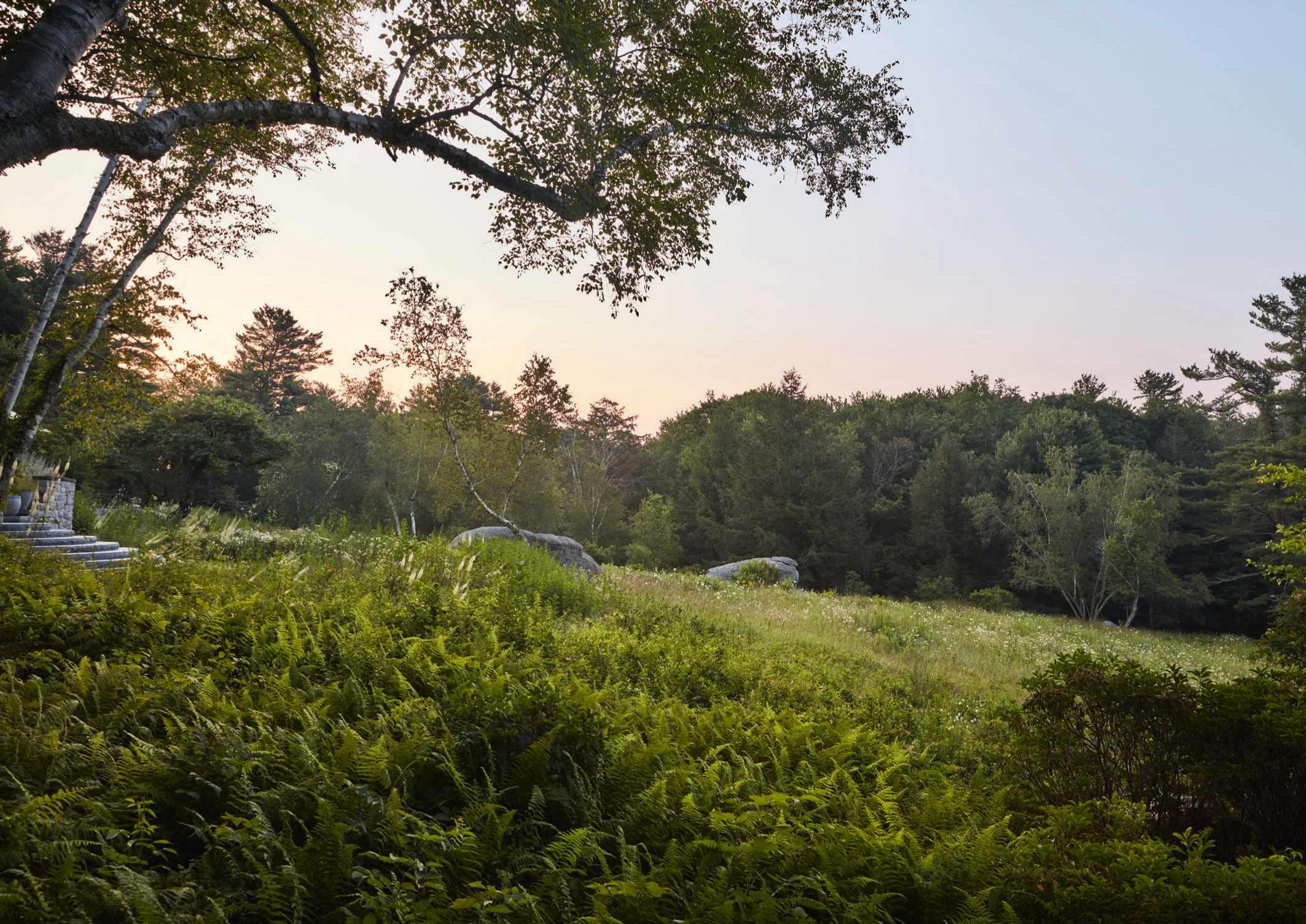
Right above From the east terrace, stone risers in the turf are an elegant invitation to walk – deep into the woods. Native rudbeckia is part of the meadow at the woodland edges, and the smaller trees are Magnolia virginiana
Right A seating area in an allée that runs along the woods by the west side of the house, demarcated by a low stone wall or ‘table’. It was built wider at this end, for a forced perspective that gives the impression that the stone table is longer than it really is.
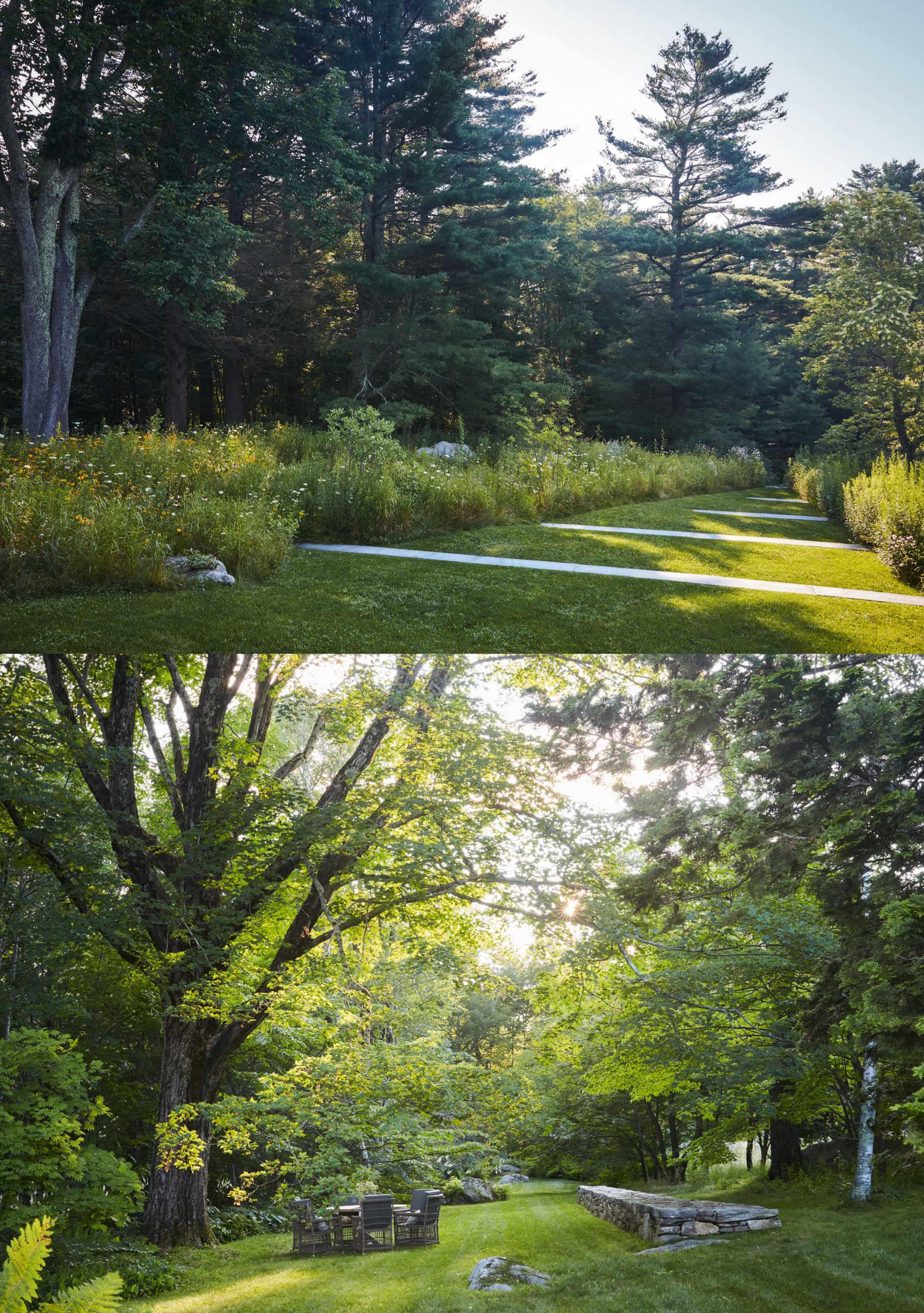

The very gentle additions that Dan put in – they don’t force you to wander, they make you want to wander
In the cutting garden, sited within an existing stone wall enclosure, Calamagrostis x acutiflora ‘Karl Foerster’ creates a meadow atmosphere. “We’ve chosen a range of perennials with the feeling of wild plants, providing a painterly mood inside the space,” says Dan. They include repeats of different purples: Geranium Rozanne (= ‘Gerwat’), Salvia nemorosa ‘Caradonna’ and Nepeta racemosa ‘Walker’s Low’.
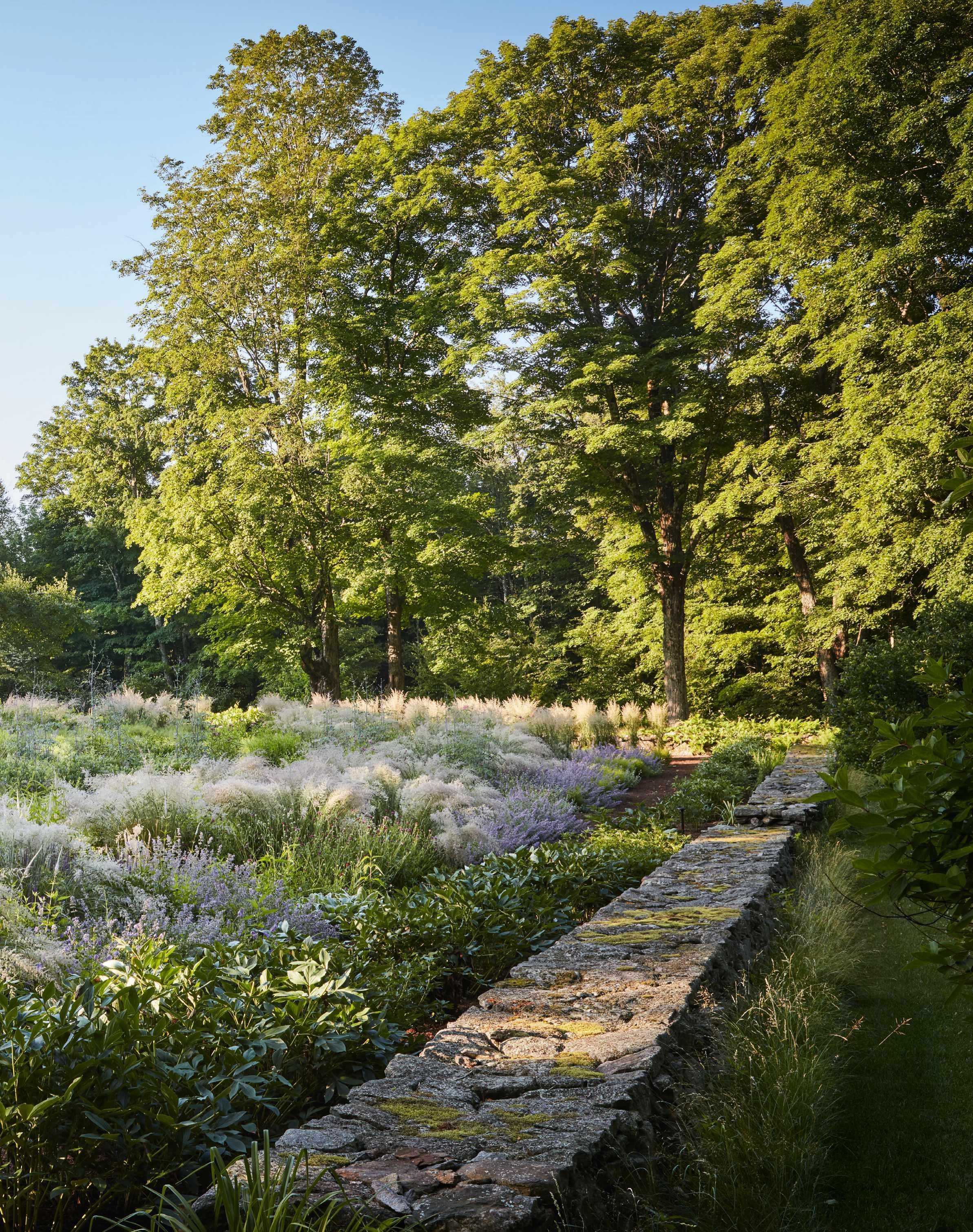
On reviewing a site that had been highly tended and then abandoned for ten years, Dan Pearson Studio looked at the framework of established trees and saw that there was a layer missing: “a human level”. This was an invitation to work on the edges, to create glades and to play with shadow and light. “We’ve pushed the woods back very gently,” he says. Accents in the garden are mainly introduced species and cultivars, such as Cornus kousa (which is hardier in this area than native Cornus florida) and Cercidiphyllum japonica, while natives come to the fore in the in-between areas.
“The edge condition is where things happen, where things are most biodiverse,” says Dan. This is where it’s useful to

have a skilled gardener here in James McGrath, who is in tune with hyper-local conditions. “James is steering things that were just ideas in the beginning; he’s trying them out, seeing how they work.” This fine-tuning allows a degree of subtlety, making a walk around Robin Hill a transcending experience.
“It’s a joke between the guys on my team and me that we’ll do things that nobody will ever notice,” says James, “but we know that we did it in a way that seems as though we’d never been there.” They manage these liminal areas, as well as the vast meadow, by controlling invasive species and adding exponentially more natives – “the flowers and plants that will flourish on their own because they are of and from this mountain.”
The three-acre South Meadow, enclosed by trees. “The spires in bloom are our native Actaea racemosa, which naturally appear around the property,” says head gardener James McGrath. For designer Dan Pearson, nature comes first. “I’m looking at landscape, rather than anything more formal or imposed.”
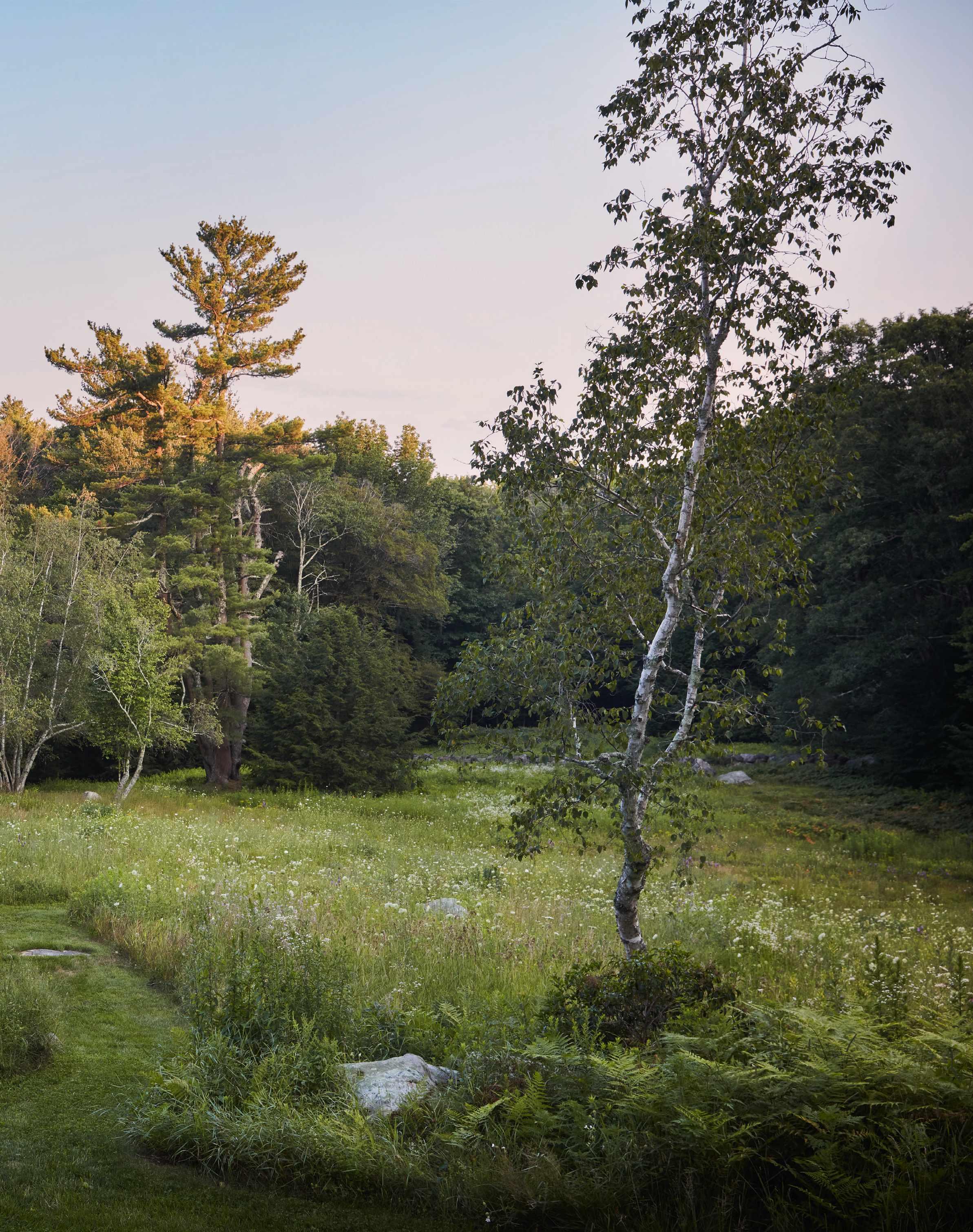
circular steps that break up the long elevation along the south-facing terrace and, to the east, stone risers in a descending grass path that make the journey towards woodland seem like a perfectly reasonable idea. Susan notes: “These very gentle additions that Dan put in – they don’t force you to wander, they make you want to wander.”
To compare Robin Hill to Rousham, the Oxfordshire garden designed by 18th-century landscape architect William Kent, is not entirely farfetched. Giant boulders have the drama of classical gods in this subtly guided American landscape, with both places celebrating light, shadow, glades and in-between places. A series of trails break out across the landscape from the house, circling around it and leading considerably farther out.
Once in the woods, on-site materials fashioned into land art create pausing places: a stone cairn rising from an expanding pool of Epimedium x versicolor ‘Sulphureum’; piles of branches left over from arboreal work morphing into sculpted wood piles. “It felt like a poetic way to approach the place,” says Dan. “These episodes stay in your mind as you’re moving through, surprising you in a way that Rousham does, with a little moment where the light changes and something holds it in that clearing.”

Closer to the house, the cathedral-height trees are given a more human scale by a lower layer of Cornus kousa, with glowing white bracts in early
summer. Elsewhere, pre-existing flame azaleas (Rhododendron calendulaceum) lead a quiet existence between tall trees and mossy ground, but briefly burst into shades of orange. “And suddenly that emerald carpet is illuminated with its polar opposite,” says Dan. He has added to this “dressing up and dressing down” with crab apples, their blossom and fruit marking microseasons, with tupelo planned for further colour in autumn. “Working these moments into the woodland makes things über – just for a minute.”
A massive factor in making this garden sing was the appointment as head gardener of James McGrath, whose international experience includes time at Great Dixter. Since his arrival five years ago, about 1,000 plugs of natives have been added annually, both to the vibrant in-between places and the meadow below the house. “I love the pushand-pull of tightly cultivated and loose,” James observes. The ongoing conversation is important: “James has very much honoured the original design,” says Dan. “He’s very gentlemanly with his communications; we have an old-fashioned backwards-and-forwards about how things could evolve.” For her part, Susan is happy to stand back: “Please refer to this as Dan and James’s garden.” ■
USEFUL INFORMATION
Find out more about Dan’s work at danpearsonstudio.com
Above A stone cairn in the woods, made by local stonemason
Stephen Bundschuh. “I wanted these beautiful objects made out of natural materials from the landscape to direct you through the place, taking your eyes somewhere and providing a pause,” says Dan.
Right Pollen-heavy Japanese stewartia (Stewartia pseudocamellia) lights up the woods, fringed with native ferns. This is the finishing point of the allée to the west of the house that begins with a table and chairs under tall trees (see page 31), and is brightened by a middle layer of Cornus kousa
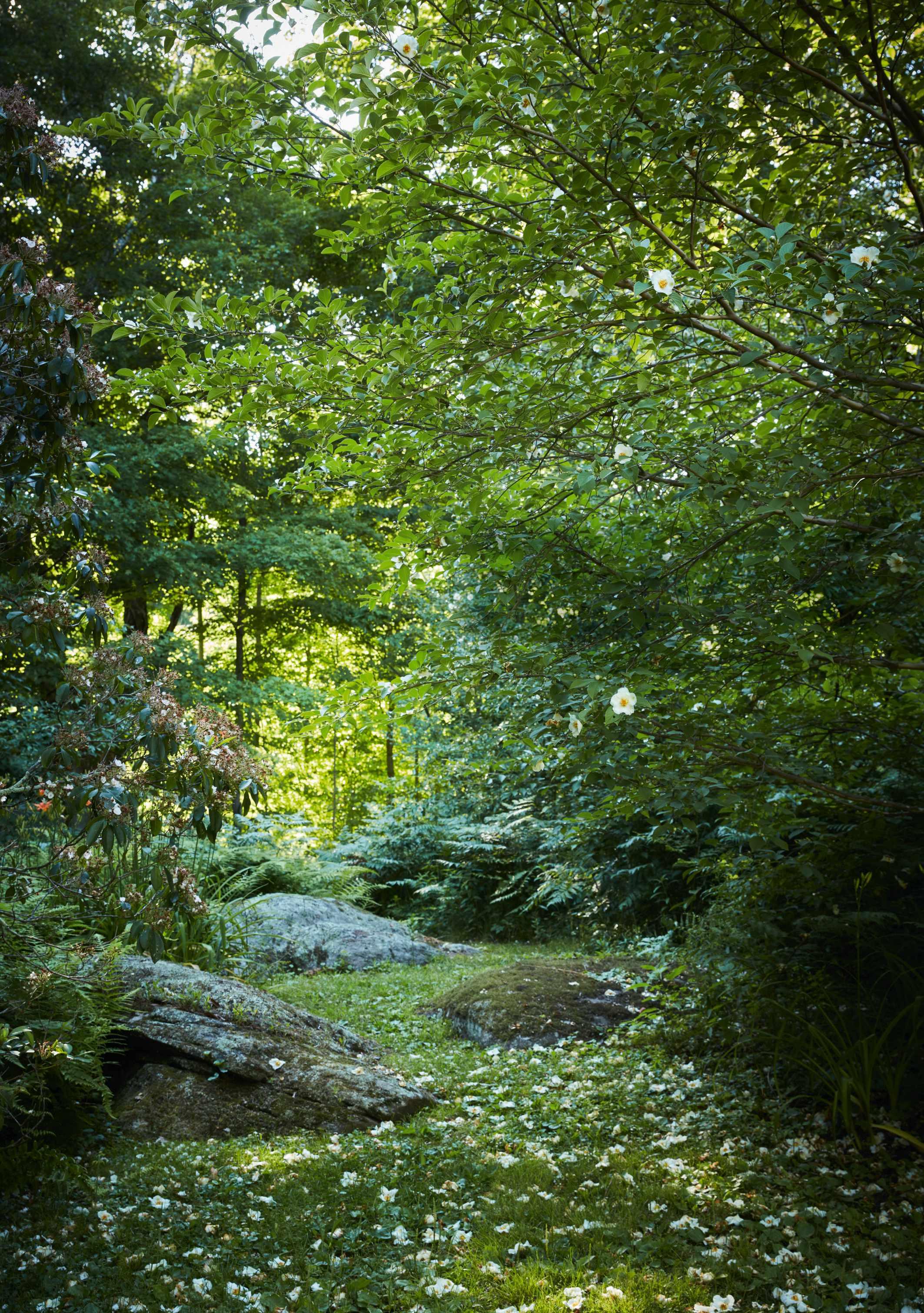
Episodes stay in your mind as you’re moving through, surprising you in a way that Rousham does
Echinops ritro ‘Veitch’s Blue’
Perennial cultivar with steel-blue flowers from midsummer, often re-flowering in autumn. A perfect choice for the middle of a border in clumps or in drifts. It is among the UK’s most widely grown globe thistles, with good reason. 90cm. RHS H7, USDA 3a-8b†
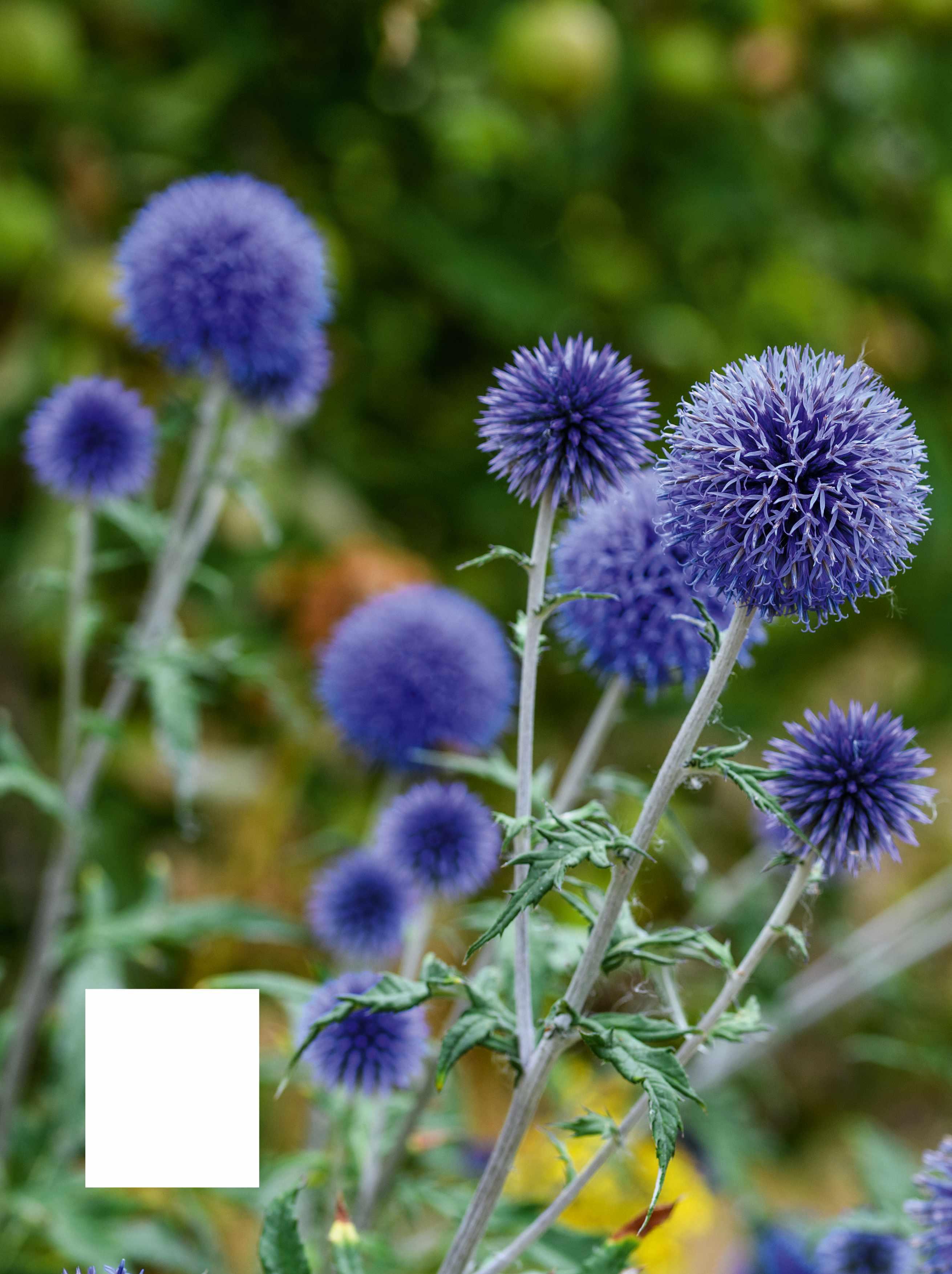
What A genus of around 218 species of annuals, biennials, and herbaceous perennials, commonly known as globe thistles. Only a small proportion of globe thistle species have reached gardens in the UK – the majority are cultivars of Echinops bannaticus and Echinops ritro Origins Species originating from across Europe, Africa and Asia. Of the cultivars grown in the UK, most originate from cooler regions of Europe.
Season Attractive jagged foliage from spring to midsummer. Flowers emerge first in midsummer, often re-flowering in autumn.
Size Variable between species and cultivars. Echinops ritro cultivars typically reach a maximum height of 1m with a spread of 50-70cm. Echinops bannaticus cultivars can reach 1.5-2m tall with a spread of 70cm-1m. Richer soils produce wider and bushier plants while in poorer soils plants are more compact and upright.

Conditions Full sun to part shade in medium to well-drained soil, flowering best in full sun. Staking often required in richer soils.
Hardiness Hardiness varies depending on species but the species and cultivars featured here are fully hardy across the UK with an RHS hardiness rating of H6-H7, and suitable for gardens in USDA zones 3a to 10b.
*Holds an Award of Garden Merit from the Royal Horticultural Society. †Hardiness ratings given where available.
Echinops sphaerocephalus
A widespread Eurasian species that is among the tallest and most dramatic globe thistles available in the UK. It is most recognisable for its highly branched, maroon stems, each tipped with white globes. Sets seed abundantly. 2.5m. RHS H7, USDA 3a-9b.
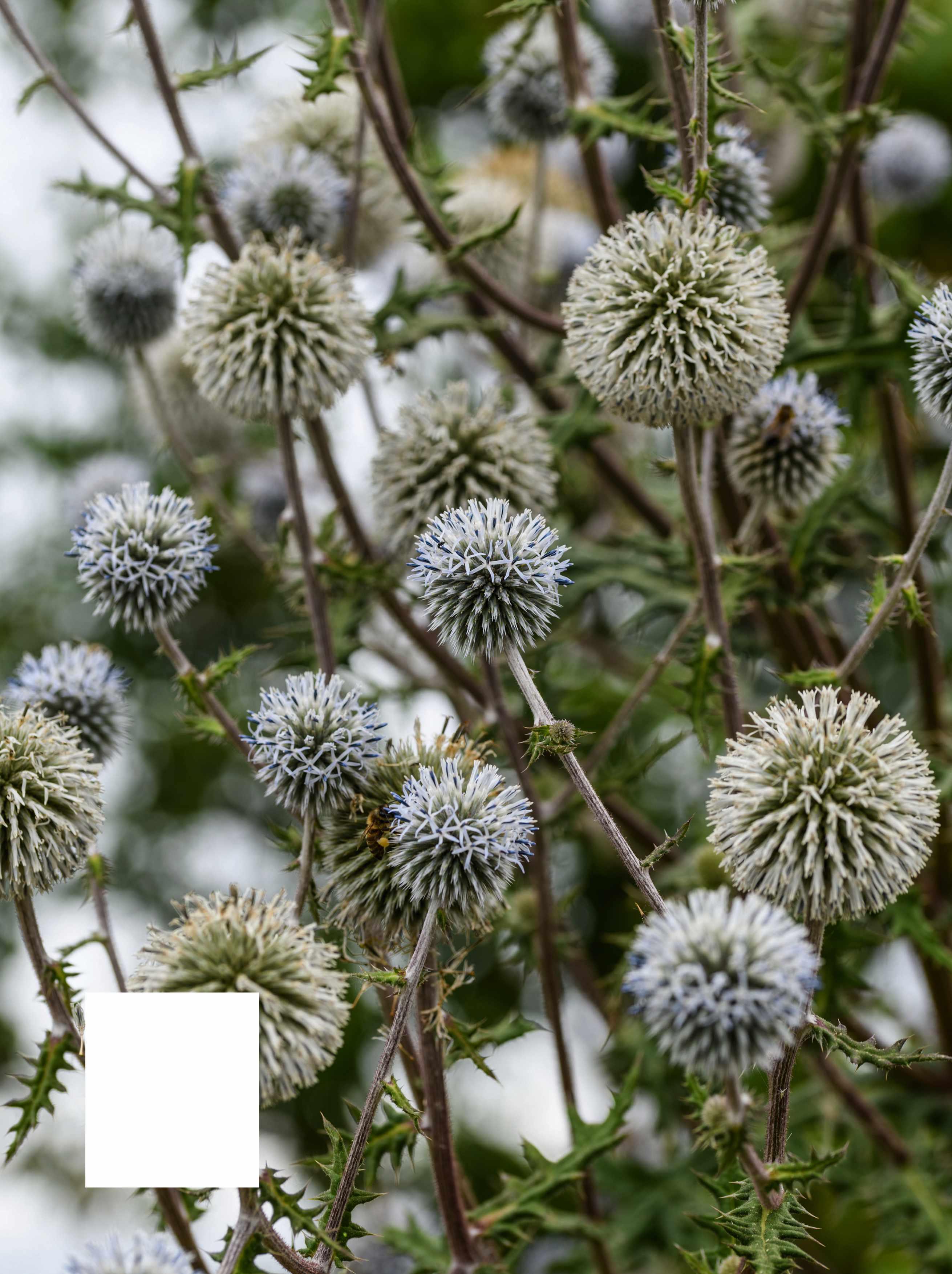
Echinops bannaticus
‘Star Frost’
A white-flowered cultivar flowering in summer and autumn. Inflorescences similar in appearance to E sphaerocephalus but with green-brown stems and benefiting from a perennial habit. 1.2-1.5m. USDA 3a-8b.
Among the wealth of perennials available to the gardener today, few match the drama of globe thistles. They are known for their true-blue, spherical inflorescences, each of which starts life as small grey-green mace-like globe, before individual blue flowers open from the top of the sphere down. Echinops are at their best planted en masse, creating veritable oceans of suspended blue spheres bobbing gracefully in the breeze. Bees and other pollinators are equally enticed by globe thistles, with the compound inflorescences among the most abundant and frequently replenished sources of nectar available. Unoccupied globes are therefore a rare sight on a summer’s day, ensuring borders hum approvingly.
Few perennials can compete with globe thistles for drought tolerance. Once established, they require no additional watering –even in sweltering droughts as other perennials wilt and wither away. Globe thistles combine this drought tolerance with complete hardiness, continuing to grow well in cold, wet conditions and surviving unscathed in even the coldest of UK winters before emerging anew each spring.
A classic position is in dry gardens and what I would term ‘scrubland’ gardens. In a sparse setting against a backdrop of shrubs such as buddlejas and brooms, globe thistles can be used to great effect as structural punctuation throughout the planting scheme. In spring, their finely cut
Echinops sphaerocephalus

‘Arctic Glow’
A shorter and more manageable cultivar of E sphaerocephalus. It’s a short-lived perennial that produces an abundance of above-average sized, white globes in midsummer and autumn. 1m. RHS H7, USDA 3a-10b.
foliage provides a pleasing foil to architectural sea hollies, euphorbias and sedums, before taking centre stage in summer, flooding the garden with blue.
As vigorous clump-forming perennials, Echinops will make excellent additions to any perennial border – even in tightly packed cottage gardens, where they sit gracefully alongside delphiniums, hollyhocks and foxgloves. For the cottage gardener, the globes of Echinops are also wonderful as cut flowers.
The growth of globe thistles means they are well suited to prairie plantings, too. Set among a backdrop of rustling Calamagrostis and Miscanthus, the spires of thistle-like foliage produced by Echinops provide pleasing visual contrast. Their blue inflorescences, meanwhile, serve as complementary contrasts to the abundant yellows and oranges of Helenium, Helianthus and Rudbeckia
For the truest blue flowers, the widely available Echinops ritro ‘Veitch’s Blue’ is peerless – producing steel-blue globes all summer long from mounds of attractive grey-green foliage. For the gravel garden, the more diminutive Echinops ritro subsp. ruthenicus ‘Platinum Blue’ may prove a more eye-catching prospect. It produces among the most attractive and finely cut, silver-spined foliage of all the cultivars, from which arises an abundance of powder-blue globes.
Where height and impact are needed, Echinops bannaticus is hard to beat. Of the blue-flowered cultivars, there is little to
For the truest blue flowers, the widely available Echinops ritro ‘Veitch’s Blue’ is peerless
Echinops bannaticus
‘Blue Globe’
The most widely available E bannaticus cultivar is a good perennial example of the classic blue globe thistle, flowering in midsummer and autumn. Sometimes sold as E bannaticus ‘Blue Glow’. 1.5-2m. RHS H7, USDA 3a-8b.
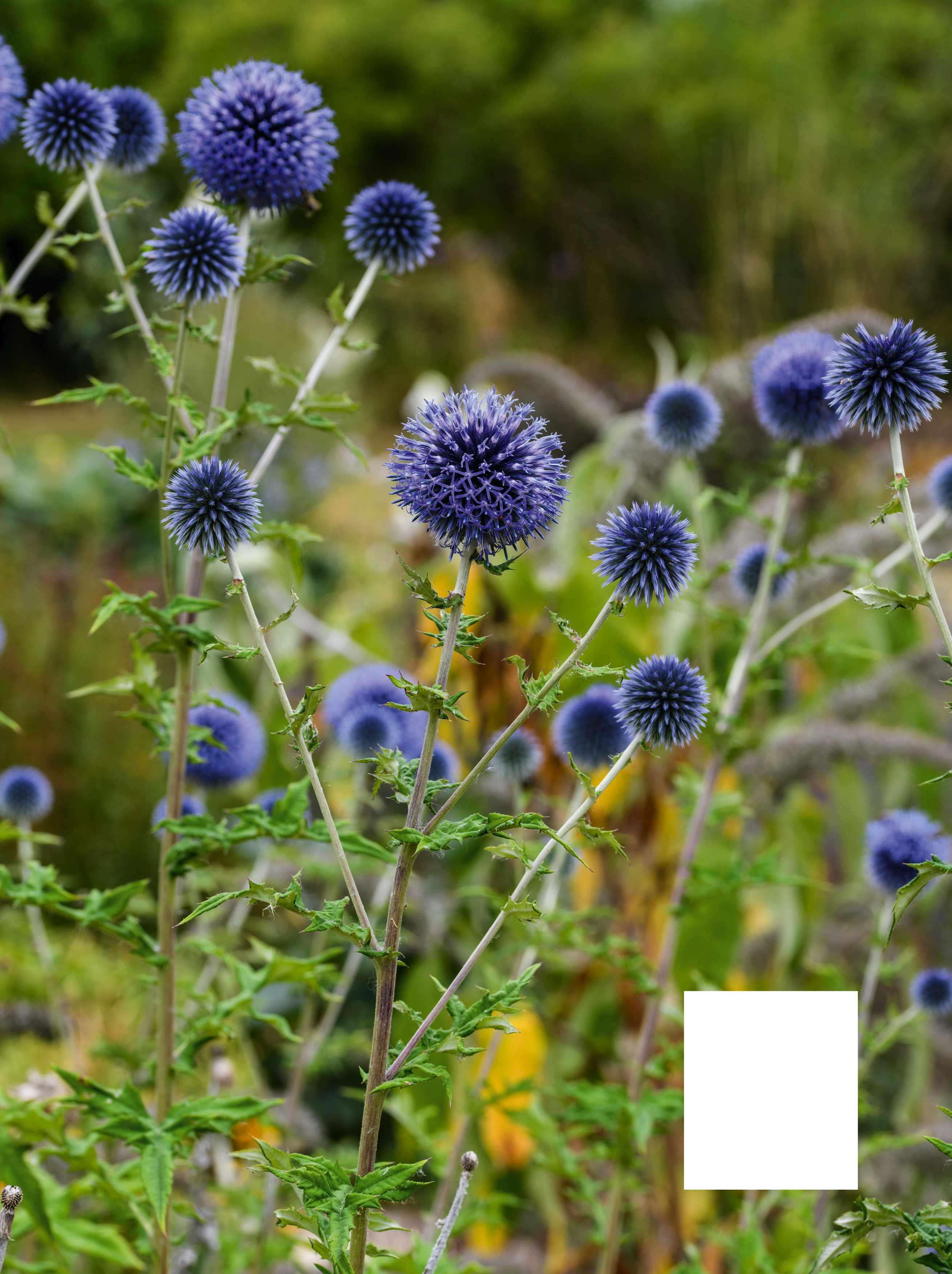
Echinops ritro ‘Baby Globes’
A relatively new cultivar of Echinops ritro, flowering from midsummer to autumn. Its flowers are marginally smaller and their colour paler than the steely blue of most E. ritro cultivars. 80cm. RHS H7, USDA 3a-8b.
• Echinops are low-maintenance and drought-tolerant perennials. Planting them in medium to free-draining poor soil in full sun will often create the best flowering display. A neutral soil is favourable, though many find success in alkaline soils. When planting, simply dig a suitably sized hole, and ensure the plant is firmed in well. Most globe thistle cultivars can be expected to live for five to ten years, and established plants do not require additional watering.
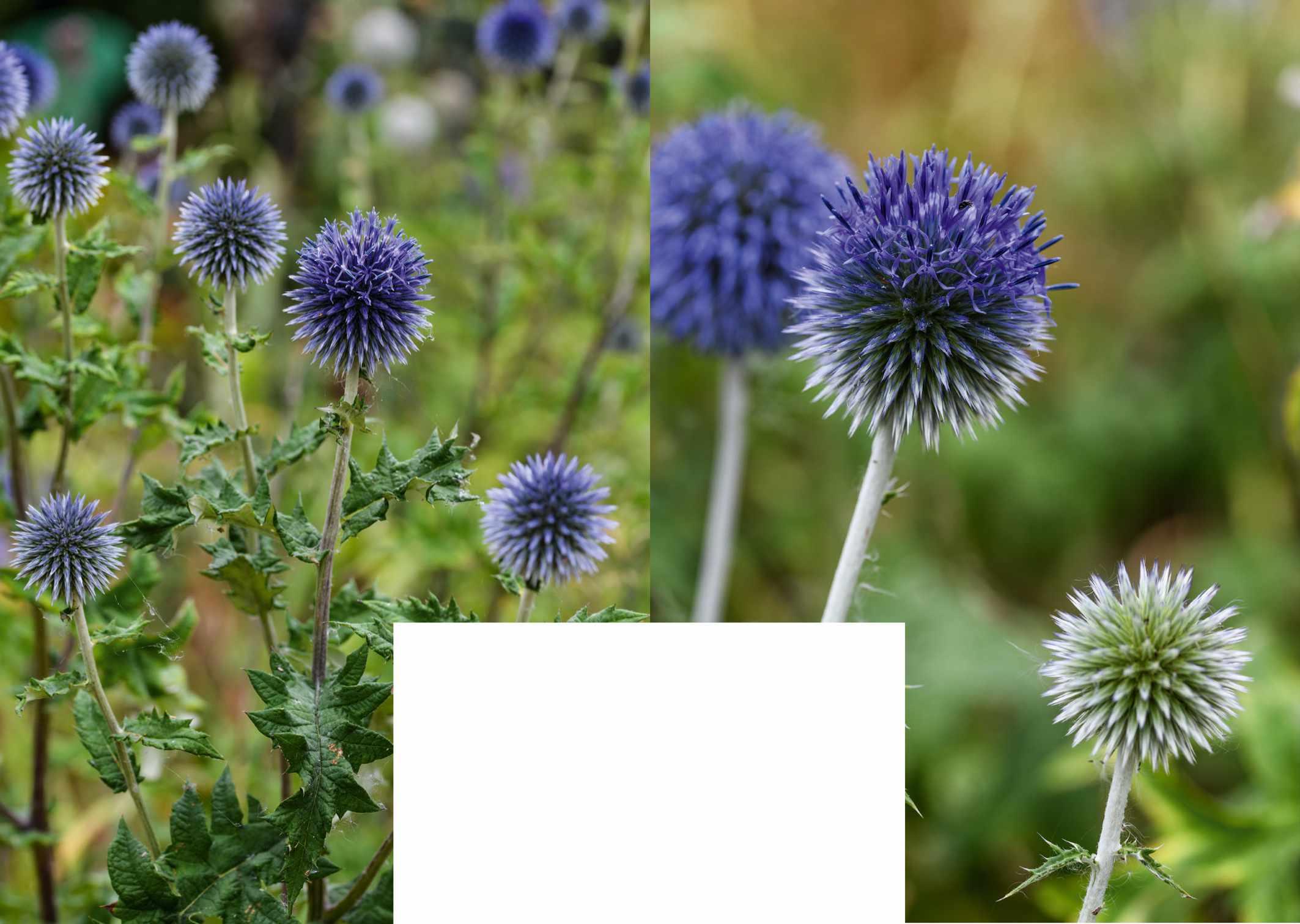
• Echinops are best planted in autumn. Newly planted globe thistles prioritise root growth over top growth. Give autumn-planted Echinops a deep watering at planting and they will be fully drought tolerant by the following spring. Spring-planted specimens require a deep watering every week during their first year, with little reward for this effort until the subsequent year.
Echinops ritro subsp. ruthenicus ‘Platinum Blue’
Its finely cut foliage gives rise to powder-blue inflorescences from midsummer to autumn. Requires a well-drained sunny position to thrive. Tricky to establish but worth persevering with. 60cm. USDA 4a-8b.
• Plant Echinops when young. When you see potted globe thistles in garden centres and nurseries, they can often appear small or unkempt. This is because the growth of their deep taproots is inhibited by cultivation in pots. So, unlike other perennials, which can benefit from growing on in larger pots, globe thistles should be planted out as soon as possible.
• Propagate Echinops by seed. Seed, which is produced in abundance, can be collected in autumn and sown fresh or the following spring on to moist seed compost before covering with grit or vermiculite. Germination should take two to four weeks depending on temperature, and once seedlings have produced the first two pairs of true leaves, you can pot on and then plant out as soon as well rooted. Divide established globe thistles by digging out a large rooted section in spring or autumn and plant where desired.
• Cut back Echinops in autumn or leave until spring. In sheltered gardens, dry Echinops seedheads can be striking and sculptural, particularly when touched with frost. Globe thistles are fully herbaceous, dying back each year. In spring, fresh growth emerges from the ground, at which point you should remove the previous year’s stems. Deadheading in summer can help to ensure a second flush of flowers in autumn and limits self-seeding.
• Echinops are generally pest and disease free. Aphids are the primary pest, with infestations likely in spring to early summer. Leaf distortion is common in infested plants; however, intervention is rarely required. In damp conditions, globe thistles in tightly packed borders may develop mildew; this, too, is rarely problematic. Globe thistles are incredibly resilient perennials and invariably grow away from any pest or disease damage.
Echinops tjanschanicus
A refined perennial species with broad-leaved, thistlelike foliage and white to pale-blue flowers on starkly upright stems. Before flowering, attractive pale-green inflorescences extend the season. 1.5-2m. RHS H6.
Echinops exaltatus
The tallest perennial globe thistle available in the UK. A robust but easily managed species from central and eastern Europe. Produces tennis ball-sized, white to pale powder-blue inflorescences. Rarely available. 2.5m.

Echinops spinosissimus
Originating from the eastern Mediterranean, Middle East and North Africa, this species has incredibly spiny foliage that is only surpassed by its spine-covered flowers. Rarely sets fertile seed. 80cm.
Echinops bannaticus
Native to southeast Europe, this is among the most cultivated of species grown in the UK. The straight species has silvergreen leaves and flowers that range in colour from deep powder-blue to white. 1.2-2m. RHS H7.
choose from between the equally excellent ‘Blue Globe’ and ‘Taplow Blue’ –both can reach 2m when fully grown and produce an abundance of mid-blue inflorescences. Echinops bannaticus also boasts several refined, white-flowered cultivars, including the widely available and ever reliable ‘Star Frost’.

Echinops gmelinii
‘Snow King’
A white-flowered, perennial cultivar that flowers profusely in midsummer. It is notably narrower in habit than other globe thistles so a good choice for planting in clumps where space is at a premium. 1m-1.5m. USDA 3a-8b.
Echinops bannaticus
‘Blue Pearl’
An old and rarely offered cultivar that has the palest powder-blue flowers within the species, but performs almost identically to other E. bannaticus cultivars, flowering from midsummer to autumn. 1-1.5m. RHS H7, USDA 3a-8b.
While abundant plantings of a single cultivar of E ritro or E bannaticus can produce dramatic displays, these species are best planted together. By combining different cultivars, their varying flowering heights and nuanced differences in flower colours can create dynamic tiered displays.
For lovers of the bold and dramatic, there is E sphaerocephalus While the white-flowered 1m-tall cultivar E sphaerocephalus ‘Arctic Glow’ is commonly grown, the straight species form is an entirely different prospect. It grows as a biennial, producing vigorous mounds of deep-green foliage in its first year, before erupting in its second year into 2.5m-tall, highly branched, dark-crimson stems – each topped with off-white globes loved by bees and hoverflies. As a biennial, it rarely re-flowers in autumn – instead it sets highly fertile seed with wild abandon – but for those wonderful summer months, no globe thistle is better.
Perhaps the only other species that can rival the stature of E sphaerocephalus is the sadly uncommon E exaltatus. Of the cultivated species, E exaltatus boasts the largest inflorescences,
commonly exceeding the size of a tennis ball and proving irresistible for pollinators. If deadheaded, it can flower all through summer and autumn before setting precious seed – well worth collecting and sharing with friends.
As the climate in the UK becomes ever more extreme, we gardeners face an uphill battle to find garden plants that are up to the challenge of surviving and thriving. Echinops is one such plant, flourishing in even the most arid of conditions – delighting gardeners and pollinators alike. ■
Dr Andrew Gladman is an entomologist and plant scientist who holds the National Plant Collection of Echinops
Where to buy and see
• Beth Chatto’s Plants & Gardens Clacton Road, Elmstead Market, Elmstead, Colchester, Essex C07 7DB.
Tel 01206 822007, bethchatto.co.uk
• Burncoose Nurseries Gwennap, Redruth, Cornwall TR16 6BJ. Tel 01209 860316, burncoose.co.uk
• Cambridge Botanic Gardens 1 Brookside, Cambridge CB2 1JE. Tel 01223 3362654, botanic.cam.ac.uk
• RHS Garden Wisley Woking, Surrey GU23 6QB.
Tel 01483 224234, rhs.org.uk
can flower all through summer and autumn before setting precious seed
A self-taught gardener with an eye for self-seeders, Louisa Morgan has created a glorious garden in the Usk Valley
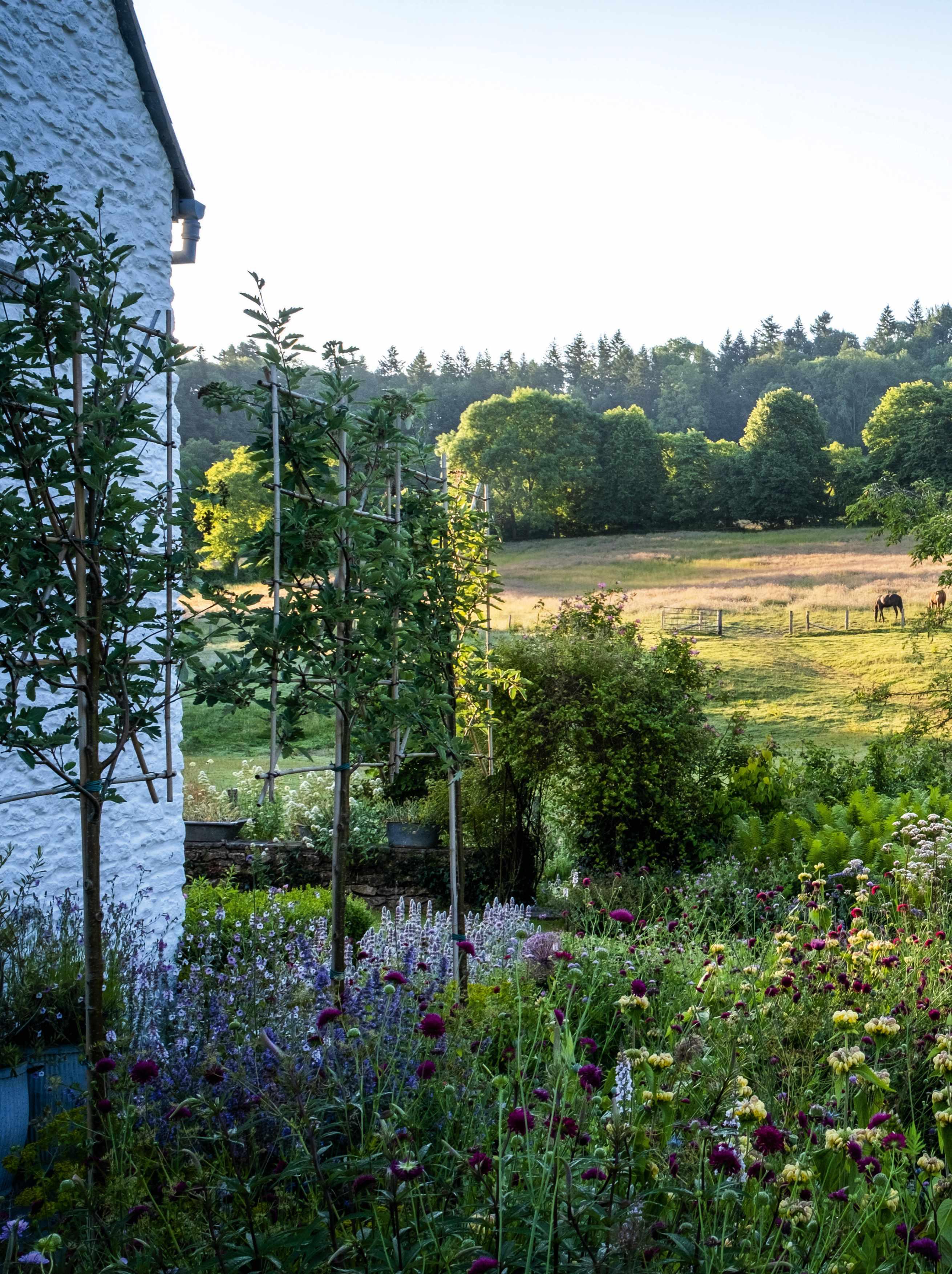 WORDS CAMILLA SWIFT PHOTOGRAPHS MARK BOLTON
WORDS CAMILLA SWIFT PHOTOGRAPHS MARK BOLTON
Name Cwm Farm.
What Exuberantly planted garden featuring a mix of informal and wild planting, and structural elements of topiary and hedging. Where Monmouthshire.
Size Three acres and growing. Soil Rich loam with large areas of heavy clay. Climate Temperate; high rainfall, sharp frosts in winter. Hardiness zone USDA 8.
With a view of the valley, Louisa’s bold, self-seeding, summer borders are a riot of colour against a backdrop of bright-green Matteuccia struthiopteris ferns and a spreading Prunus ‘Kanzan’. Soft-yellow Phlomis russeliana bobs among lavender-blue Nepeta ‘Six Hills Giant’, punctuated by the crimson pincushions of Knautia macedonica
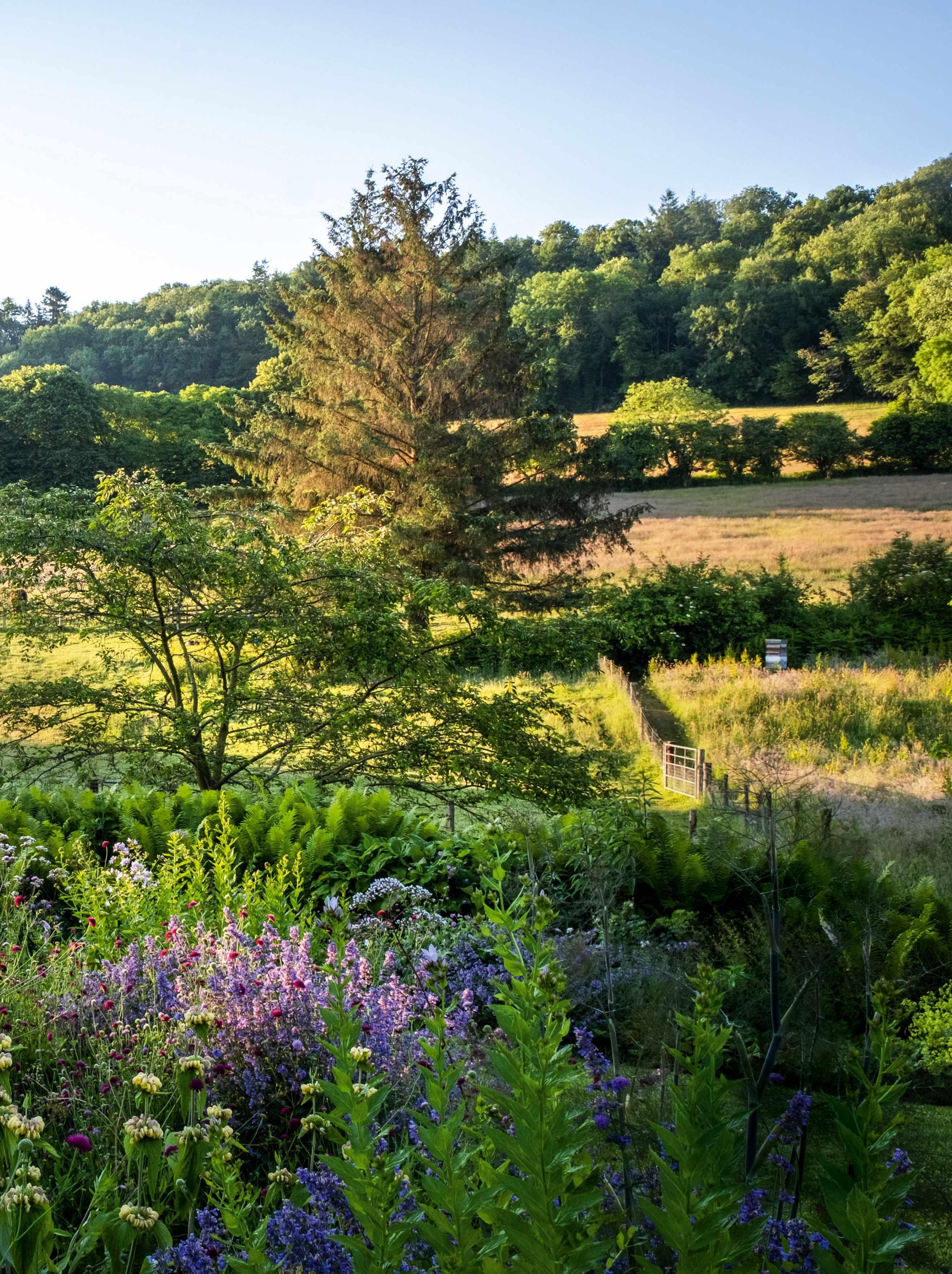
Monmouthshire is a gift to gardeners. For beginners, it’s also a glorious adventure playground: spindly yew and sparse hornbeam grow speedily into serious hedges; stuff happens almost as you watch. A new garden can appear established and older than its years in a pleasingly short time.
The garden at Cwm Farm in the beautiful Usk Valley sits so naturally in its surroundings that it might have been there forever. In fact, it is barely nine years old, and despite being a comparative gardening novice, owner Louisa Morgan opened her delightful garden for the first time earlier this summer for the National Garden Scheme (NGS).
The house was completely run down when Louisa and her husband Lee discovered it 15 years ago. For Louisa, marketing director of the family business Mandarin Stone (suppliers of natural stone, porcelain and decorative tiles), restoring the house to its Grade II-listed glory was familiar territory; the garden, however, was not. Just as she started to think about it, she was diagnosed with breast cancer. Facing prolonged treatment (she has now happily recovered), the garden became an all-important goal, providing
Above Louisa has brought planting up to the 16th-century, whitewashed farmhouse with an exuberant mix of self-seeding favourites, and a row of pleached whitebeam. Behind, two sentinel Italian cypresses stand tall over a froth of tall, translucent Valeriana officinalis. Across the lawn is the greenhouse with its raised beds where Louisa grows most of her plants from seed.

Right The front door to Louisa’s house, laden with the silvery-pink blooms of Rosa ‘New Dawn’, is almost hidden behind a screen of tufted grass Stipa gigantea and giant scabious Cephalaria gigantea
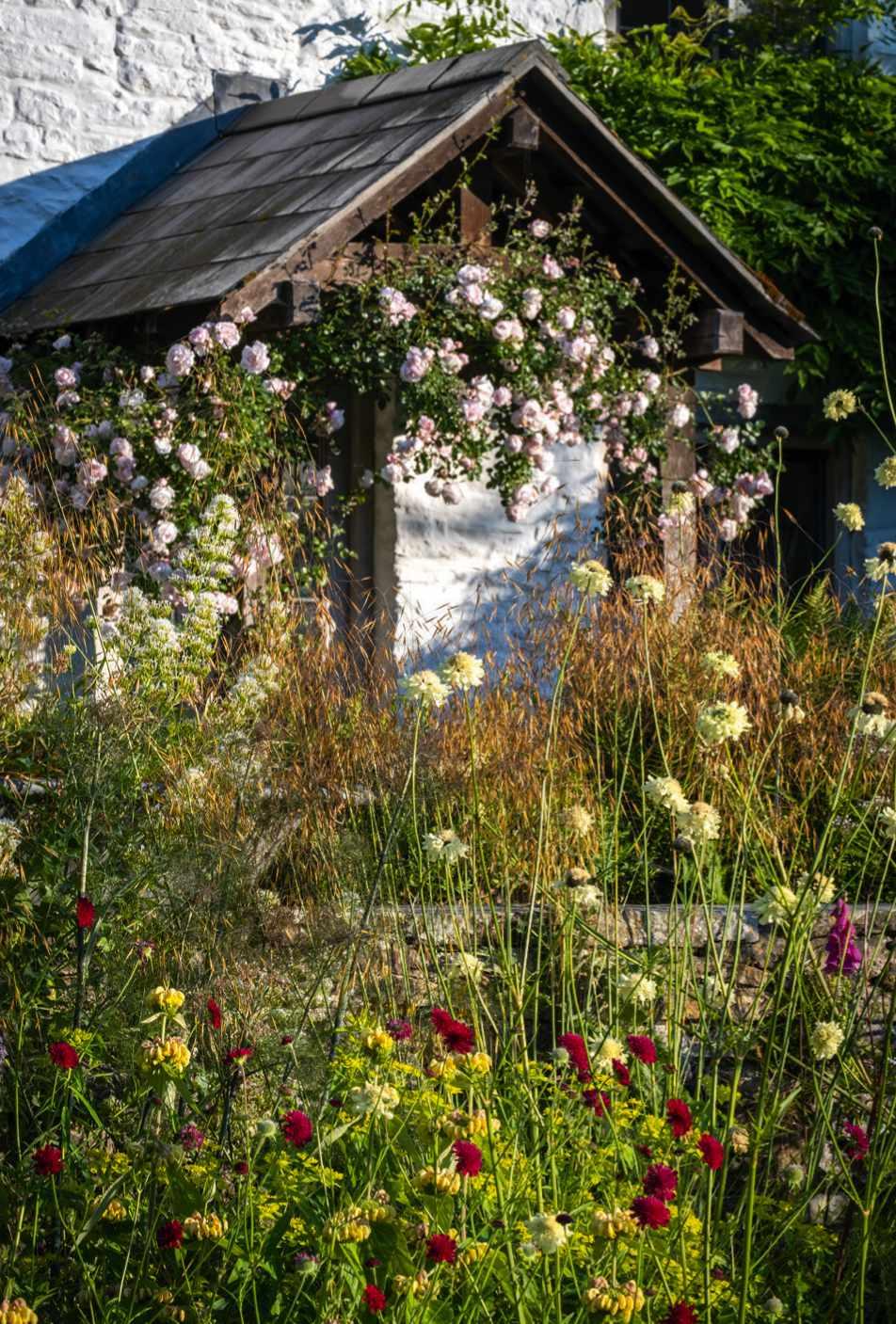
1 Centranthus ruber Red valerian and Louisa’s preferred white cultivar C. ruber ‘Albus’ are both tough perennials that self-seed freely. Louisa lets them go where they want. Height and spread: 1m x 50cm. RHS H4, USDA 5a-8b†

2 Stachys byzantina A reliable self-seeder with silver foliage that complements other flowers and provides good edging for the borders. 50cm x 60cm. RHS H7, USDA 4a-8b.
3 Phlomis russeliana Provides excellent structure in summer and winter but is a prolific self-seeder. 90cm x 75cm. AGM*. RHS H6, USDA 5a-9b.
4 Salvia verticillata ‘Purple Rain’ A prodigious self-seeder that is a good groundcover plant, which bulks up easily. 60cm x 50cm. RHS H5, USDA 5a-8b.
5 Linaria purpurea ‘Canon Went’ Another self-seeder that flowers all summer, with delicate, pink spires threading through the chunkier plants. 90cm x 30cm. RHS H6, USDA 5a-9b.
6 Eremurus x isabellinus ‘Cleopatra’ This foxtail lily took a while to appear, then suddenly popped up all over the place, adding height and contrast in the border. Worth the wait. 1.2m x 60cm. RHS H6, USDA 5a-8b.
7 Astrantia major ‘Alba’ Vigorous, long-flowering and rewardingly easy to grow, its muted colours complement the showier plants. 75cm x 50cm. RHS H4, USDA 4a-7b.
8 Rosa ‘Phyllis Bide’ A beautiful rambling rose that Louisa loves for its changing colourways, from cream to pink to yellow. 4.5m x 1.8m. AGM. RHS H6, USDA 5a-9b.
*Holds an Award of Garden Merit from the Royal Horticultural Society. †Hardiness ratings given where available.

The overall effect is that of exquisitely aged fabric edged with intricate lace, and interwoven with bold blocks of colour
This image Louisa’s first border at the back of the house, with the frothy, pastel colours that have become her signature planting palette. Common and red valerian, Valeriana officinalis and Centranthus ruber, are framed by the towering cardoon Cynara cardunculus, with burnt-orange flower spikes of Eremurus x isabellinus ‘Cleopatra’ adding flashes of colour around the edges.
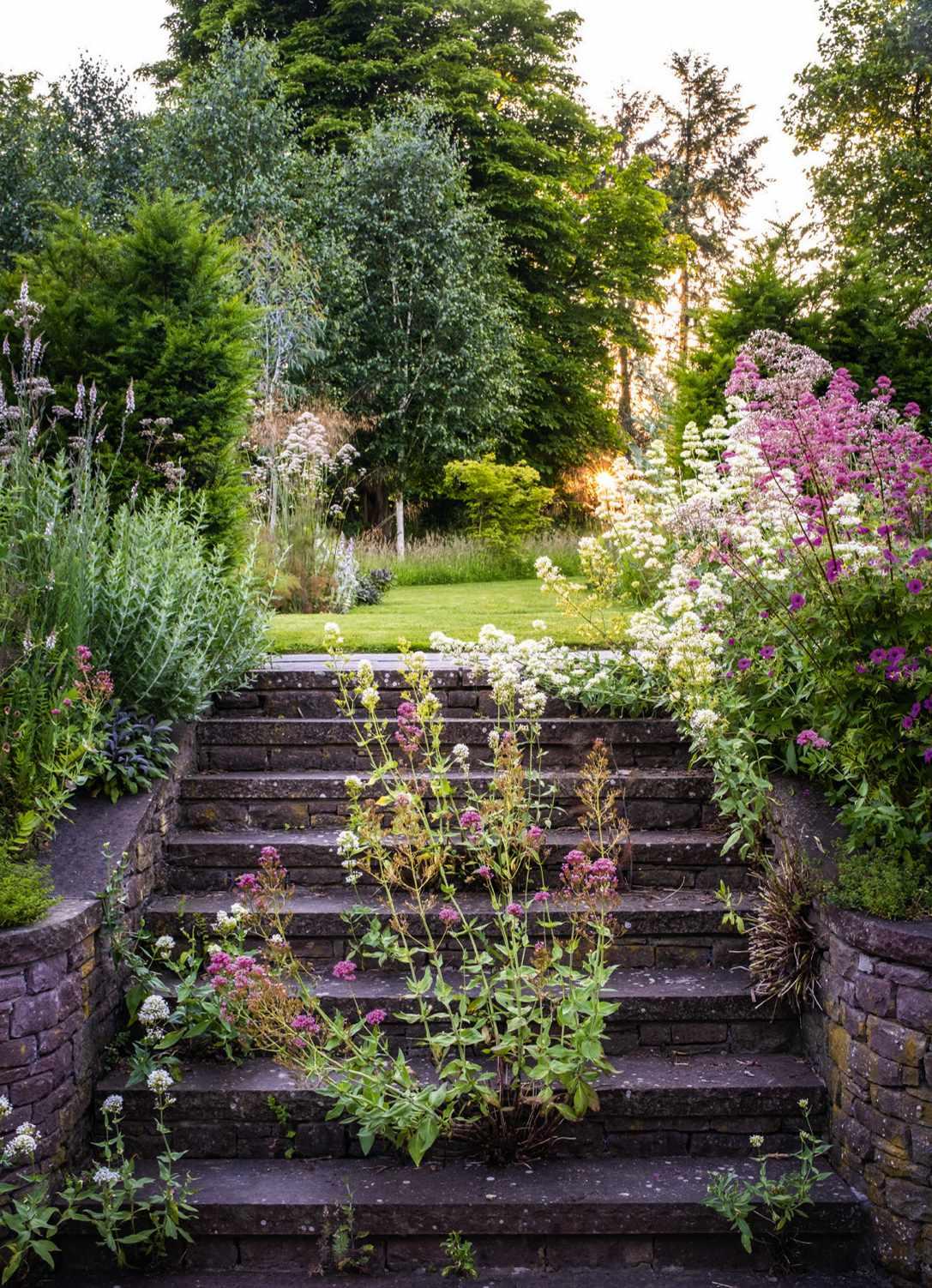
Right Clumps of Valeriana officinalis, the shorter Centranthus ruber ‘Albus’ and Centranthus ruber happily self-seed in the cracks of the steps, which lead towards a small copse of Betula utilis subsp. jacquemontii underplanted with Acer palmatum Going Green (= ‘Sonkootgre’).
both sanctuary and support throughout a challenging time. She threw herself into the project.
The house was surrounded by sharply sloping scrubland; behind it lay the remains of a lawn overrun with small trees and shrubs. At the front, a steep slope ran down to a stream choked by around 200 alders that could only be removed after acquiring a felling licence. Louisa began by excavating the land at the back, removing tonnes of soil to create a large border overlooking a terrace. She knew she wanted a mix of informal, wild planting, but with structure, so she compiled a detailed planting plan, combining gutsy self-seeders, such as stachys, eryngiums, angelica, poppies and stipa, with astrantias, phlomis and the soft-blue Geranium pratense. The overall effect is that of exquisitely aged fabric edged with intricate lace, with flashes of shocking-pink Geranium ‘Anne Folkard’ punctuated with small, crimson full stops of sanguisorba.

Her rapidly growing plant knowledge came from enthusiastic and knowledgeable friends and from visiting shows and gardens. Great Dixter and Sissinghurst were hugely inspirational, as were her three horticultural heroes – BBC Gardeners’ World presenter Monty Don, designers Arne Maynard and “bits of” Piet Oudolf.
In front of the house, generous borders echo the planting at the back: “I like it, and I know it works.” The stream, now free of alders, runs the length of the garden into a pond surrounded by a wildflower meadow. In summer, swallows swoop and a pontoon provides the ideal spot for catching the evening sun. There’s a small copse of silver birch, planted to encourage dwindling birds to return, and to Louisa’s delight, a goldfinch nested there for the first time this year. A tiny terrace hidden among fruit bushes is a recent addition – somewhere to sit and think, should she ever have time. Structure comes from a rapidly growing yew hedge, and crab apples and pleached whitebeams emerging from the borders. Then there’s the greenhouse, lined with rows of neatly labelled pots. Louisa’s greatest pleasure comes from growing from seed plants she
can’t find for sale – her beloved valerian a particular favourite. For this, she collects seed from the flowerheads in summer, then leaves the plants standing for winter interest. Meanwhile the beautifully constructed raised beds that surround the greenhouse have extended into a neighbouring paddock. The garden expansion continues.
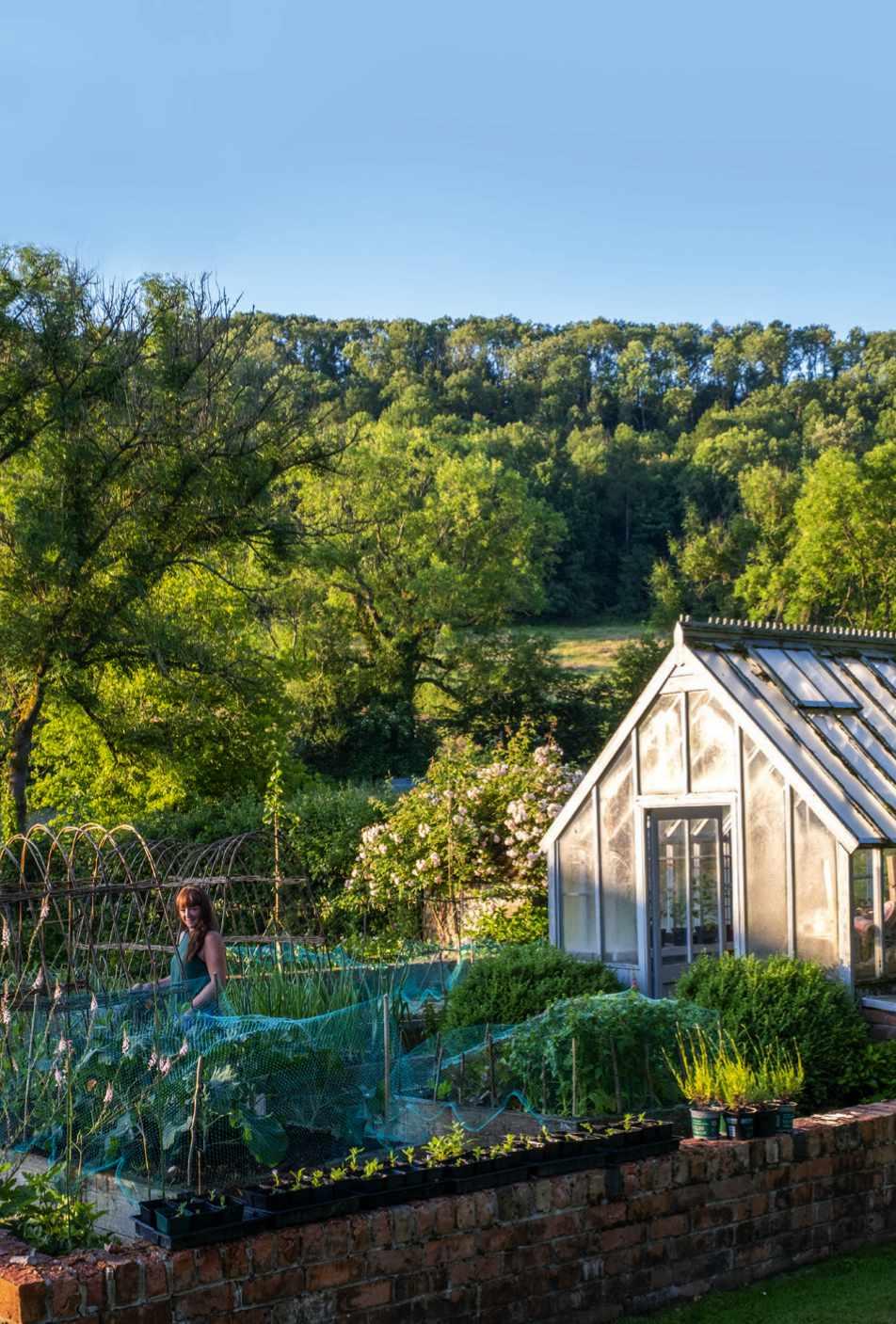
But this garden is not just alive with plants; dogs of varying shapes and sizes cavort on the lawn, chickens roam contentedly and cats sunbathe. Then there’s the wildlife: a pair of Canada geese, nesting by the pond, have produced their first two goslings; ducks potter; butterflies flutter; and bees are busy in their hives.
Helping Louisa with her ever-evolving plot is a once-a-week gardener – her father, who does the mowing – and a friend who makes all the willow arches and frames. But her secret weapon is her husband Lee, who does “whatever needs doing”, be it building planters, constructing a well to hide raised waterpipes, or running up metal arches. Will they ever run out of projects or steam? “Eventually,” promises Louisa, “I’ll say, that’s it.” Frankly, it’s hard to see that happening any day soon. ■
USEFUL INFORMATION
Address Cwm Farm, Pontypool, Monmouthshire NP4 OTB.
Tel 07921 749777. Open By appointment for groups of ten or more.

The stream runs the length of the garden into a pond surrounded by a wildflower meadow. In summer, a pontoon provides the ideal spot for catching the evening sun
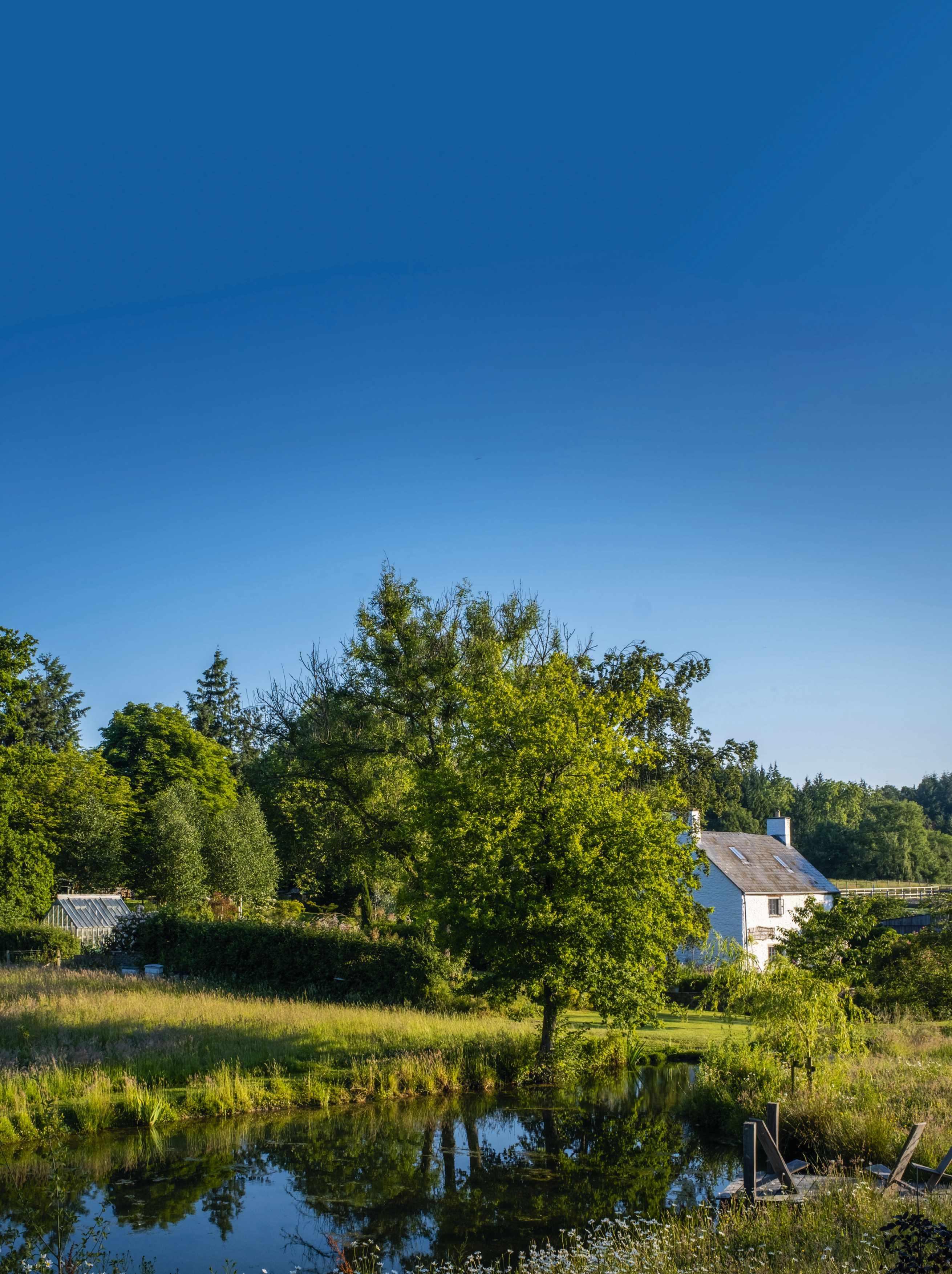
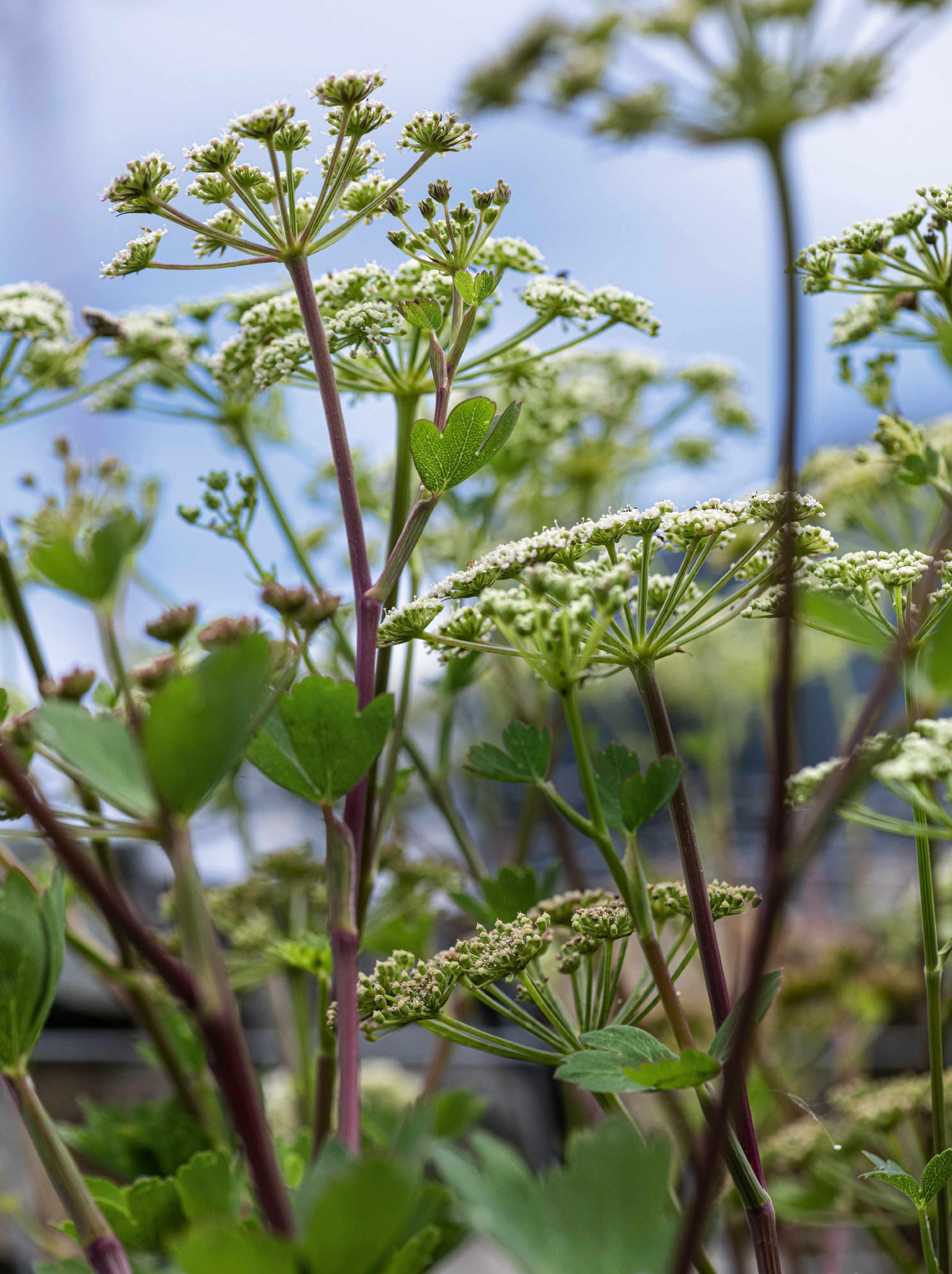
Peucedanum japonicum
A rare perennial species in the Apiaceae family that is native to coastal areas of China, Japan and Korea. Produces thick, edible, glaucous foliage on purplish stems, and umbels of white flowers from July to August. Koreans eat the early spring leaves as a cooked vegetable, and use it medicinally. Leave the seedheads for winter interest. Will grow in any garden soil as long as it is moisture retentive, in sun or partial shade. Height and spread: 1m x 20cm.
WORDS JODIE JONES PHOTOGRAPHS ANDREA JONESAs a young girl, Lisa Wesley was obsessed with plants. “I’d spend hours with my dad looking for wildflowers in the local woods and, when I was about seven, I got hold of some books and began teaching myself all their names.” Then her aunt gave her a little cactus, and soon Lisa had a collection of pocket-money purchases that filled the windowsills of her family home.

Some four decades on, it is no surprise to find that Lisa is running one of the
most interesting nurseries in the country. Growild offers a fascinating selection of rare and unusual perennial species, many of them from Japan, China and the Himalayas. She has a large selection of hardy impatiens, begonias, Cirsium, Taraxacum and Saxifraga stolonifera, and grows so many ornamental members of the nettle family that she is currently applying to be recognised as a National Collection holder of hardy Asian Urticaceae, examples of which include Pilea and Elatostema
Everything is grown from her own seed, cuttings and divisions (or, very occasionally, seed from trusted people who own plants she doesn’t yet have in her collection) to strictly
vegan standards, on the former farm in Ayrshire where she has lived with her partner Andrew Blackwood since 2014.
It seems like an obvious and inevitable outcome for a self-confessed ‘plant nerd’, but Lisa’s journey to this point in her life has been far from straightforward. As a neurodiverse individual, Lisa found it impossible to engage with mainstream academic education and instead spent her childhood and teenage years obsessively drawing and painting.
She went on to become a professional artist, working in performance and installation as well as paper-based practices, but gradually found that
Clockwise from left Growild’s owner Lisa Wesley collects seed from her collection, which she sends out fresh. A sunken water garden, created using stones from the old farm, is home to moisture-loving species.Clockwise from top left Taraxacum albiflos A curious, white and golden-yellow, bi-coloured dandelion. Flowers April to August. Plant in full sun to light shade in any well-drained soil. 15cm x 15cm.

Ajuga lupulina Forms rosettes with cream bracts with flowers hidden beneath them. Flowers July to September. Moist but welldrained soil in full sun to part shade. 30cm x 25cm.
Pilea insolens Bright-green, ribbed leaves on erect, purplish stems and panicles of tiny, white flowers in the leaf axils in autumn. Moist, humus-rich soil in part to full shade. Hardy to -10°C. 70cm.
Aster scaber Large, cordate-shaped leaves and tall spikes of starry, white flowers. Sun to dappled shade in moist, humus-rich, well-drained soil. 1.2m.
Begonia aff. palmata Rhizomatous species that has palmate, marbled leaves with red undersides. Part to full shade in sheltered position in moist, humus-rich, well-drained soil. 60cm x 20cm.
Pilea species As yet unidentified foliage plant. Produces clumps of elliptical, toothed, silver-striped leaves and panicles of tiny, pink flowers in the leaf axils in autumn. Moist, humus-rich soil in part to full shade. Hardy down to -12°C to -15°C. 60cm x 30cm.
the pressure to promote herself and her work became unbearable.
“By this point I was living in Glasgow with Andrew, and the Glasgow Botanic Gardens was just a ten-minute walk from our house. I used to spend a lot of time there looking at the plants and taking pictures,” she says. “I started reading plant books again, especially anything by Daniel Hinkley, and I began to collect plants for the first time since my childhood. It felt like I was rediscovering myself.”
Lisa found she was particularly drawn to the pure Asian species. “I’m a minimalist at heart. In my art I always try to distil things down to their purest form, to take
away all the unnecessary elements, and it’s the same with plants. The species are just so much more elegant than all those ‘shouty’ cultivars that plant breeders produce.”
What started as a hobby soon, in Lisa’s words, got out of hand. With only a concrete yard behind her home, in 2012 she rented a semi-derelict plot of land nearby where she could keep her expanding collection.
Then, to fund the purchase of the rare species that she coveted, Lisa began to sell some of the plants she had already propagated. The business may have begun almost by accident, but word spread among
her fellow plant nerds, who couldn’t get enough of her pink dandelions and fancy thistles, and it rapidly skyrocketed.
“Andrew and I knew we had to move to find more space, and we were happy to get out of the city, but it took us a couple of years to find the right place.” In fact, when Andrew first showed her the property details of their current home, Lisa was so convinced it was the wrong place that she resisted even visiting it.
“The farm was basically a blank canvas,” she says. “An overgrazed field, horribly tortured hedges, and a house I didn’t like the look of. But there were also five acres of woodland and the
Cirsium chlorolepis
Grown from seed collected in Yunnan, China, this beautiful, perennial species is native to grasslands on mountain slopes in China, and unknown in cultivation. It produces dissected, spiky leaves with white veining and extremely cobwebby stems with nodding pink and purple flowerheads. Fantastic plant for bees. Flowers July to August. Plant in full sun in moistureretentive soil. 1.5m x 60cm.
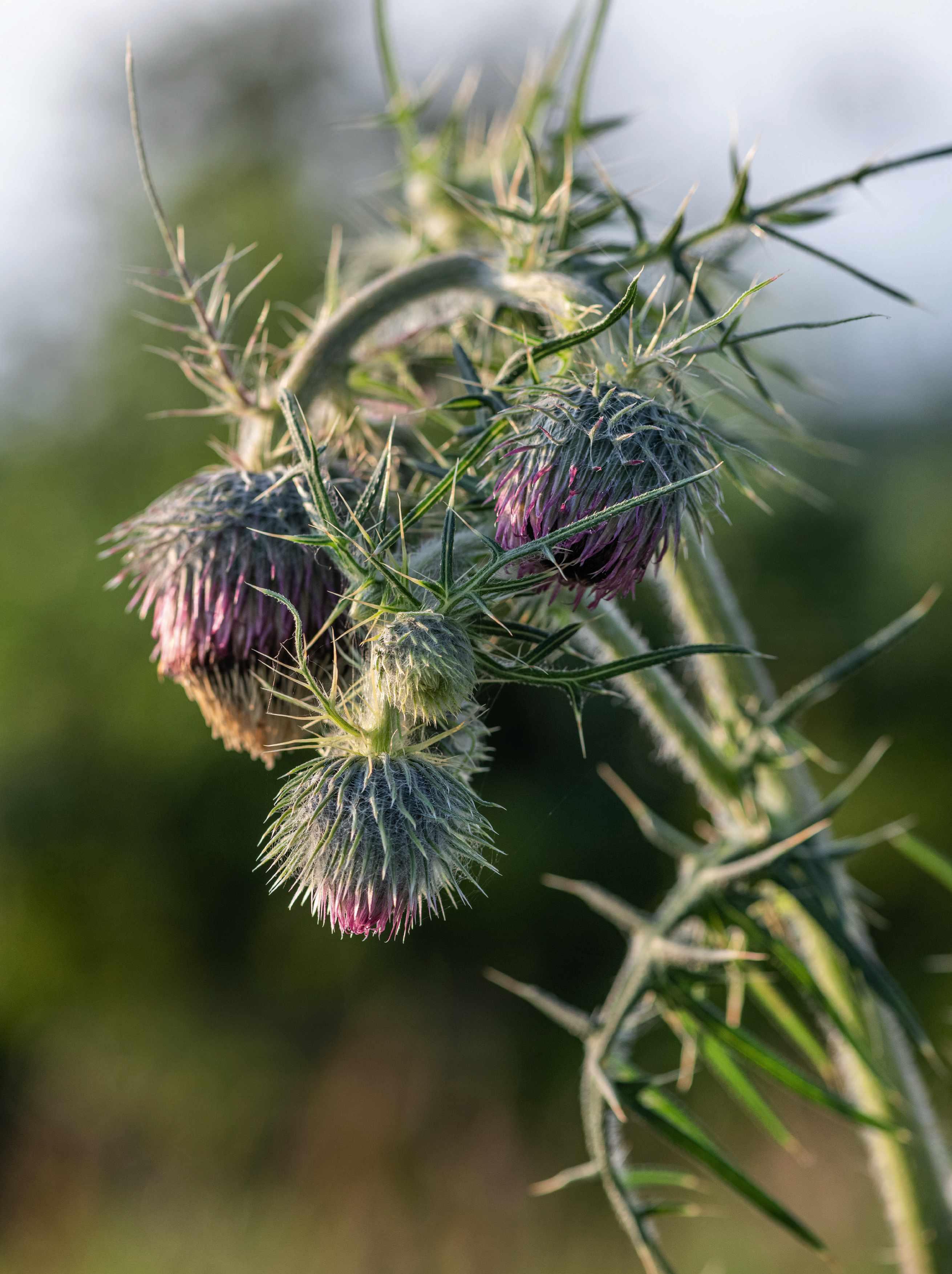
Word spread among her fellow plant nerds, who couldn’t get enough of her pink dandelions and fancy thistles

From a seed collection by August Wu and Bjørnar Olsen in Yunnan, China at 3,300 to 3,800 metres. Produces clumps of distinctively lobed foliage and stunning, seminodding flowers in summer to autumn, which in this particular collection have a much stronger purple colour and blue centre. Although the flowers only last one day, the plant produces plenty and insects adore them. Needs welldrained soil in a sunny position. 90cm x 15cm.
• Environmental responsibility is currently a hot topic in the commercial nursery world, but Lisa has always grown her plants organically and peat free, with minimal use of plastics. “I couldn’t imagine gardening in any other way,” she says.
• Lisa grows her nursery stock in plastic pots, but these stay on site and are constantly reused. Growild is an exclusively mail-order business, and Lisa painstakingly unpots each plant and transfers it to fully compostable cardboard packaging for delivery, but she is now working to improve her carbon footprint even further. “We already sell a lot of seed, but I am trying to expand this part of our business to at least half our sales, because it makes so much more sense to put an envelope of seed in the post than a two-litre plant.”
• She raises most of her plants from seed and is keen to encourage her customers to do the same. “Fear of failure puts a lot of people off. They may have had disappointing results from seed in the past so they think it’s beyond them, but I suspect it is often the seed that’s at fault. A lot of commercially available seed is grown far afield and can be very old by the time it is packaged up for domestic sale.”
• Growild sells all of its seed fresh, taken from the nursery’s own plants, which is why it is only available for a limited time each year. “It means our customers may have to be a bit patient to get hold of something they have set their heart on,” says Lisa, “but it also means they are pretty much guaranteed a great germination rate.”
Clockwise from top left
Allium wallichii deep burgundy black Variable, clump-forming species. This stunning form has burgundy, almost black flowers. Moist, well-drained soil in full sun to part shade. 70cm x 20cm. Geranium sinense Velvety, purple-black flowers July to September. Full sun to part shade in moist, well-drained soil. 60cm x 30cm. RHS H6†
Impatiens pritzelii ‘Hubei Red’ Dramatic, red foliage. Moist, humus-rich, well-drained soil in part to full shade. Hardy to -17°C with a winter mulch. Protect from frost if pot grown. 30cm.
Cirsium botryodes Large, dissected, spiky leaves with white veining, and cotton-haired stems with brown-red flowers from July to September. Full sun in moisture-retentive soil. 1.5m x 60cm.
Saxifraga stolonifera ‘Nezu Jinja’ Huge leaves with an intricate tracery of silver veins. Masses of pinky-white, starry flowers in summer. Moist, well-drained soil in part to full shade. 20cm.
Impatiens taronensis Small flowers in late summer, with purple, mottled stems. Moist, humus-rich, well-drained soil in part to full shade. Hardy to -12°C with a winter mulch. 30cm x 25cm. †Hardiness ratings given where available.
minute I walked into them I felt a strong sense that I had to protect them.”
Nine years on, a lot has changed. The scalped field has gradually reverted to wildflower meadow and the hedges have relaxed beautifully. The air now thrums with bee and insect activity, and 19 more species of bird have been recorded in recent years. Lisa and Andrew have welcomed their soaring wildlife population, from damselflies to swallows, with one significant exception: deer.“They just keep eating my fancy dandelions,” says Lisa. Andrew, who gladly gave up his previous job in arts administration to run the office side of the nursery, is currently working his
way around the perimeter of their land installing deer-proof fences. The collection of rare plants Lisa has built up is just too precious to risk it being turned into a takeaway supper for marauding ruminants.
Nettles, umbels and thistles all thrive naturally in the heavy clay soil here. Other things, including Lisa’s precious collection of rare, Chinese, high-alpine plants, which can’t cope with such rich living, are grown in raised beds, where they appreciate the free-draining conditions.

Lisa will find a way of growing anything that catches her attention. “I think I have a good eye for plants and I’m a big foliage person. I can look at a little woodland
plant and fully lose myself in its detail for five minutes at a time.”
She knows that some traditional gardeners would class many of the plants on her sales list as weeds. “I would just say to them, don’t let whole groups of plants be tarnished by the same brush. They don’t all behave like the notorious ones, and so many are really beautiful, garden-worthy plants.” ■
Address Loganhill Farm, Cumnock, East Ayrshire KA18 3BX. Web growildnursery.co.uk
Mail order only.
Find recent examples of Lisa’s art at mary-mary-quite-contrary.com
What Water meadow garden. Where Buckinghamshire. Size 13m x 36m.
Soil Heavy clay.
Climate Temperate.
Hardiness zone USDA 8.
Garden owner André Schott drew on his childhood in the Netherlands to inspire his water-meadow garden. A snaking timber boardwalk links the different garden areas, winding between rather than over the seven ponds, and invites visitors to venture further into the space.
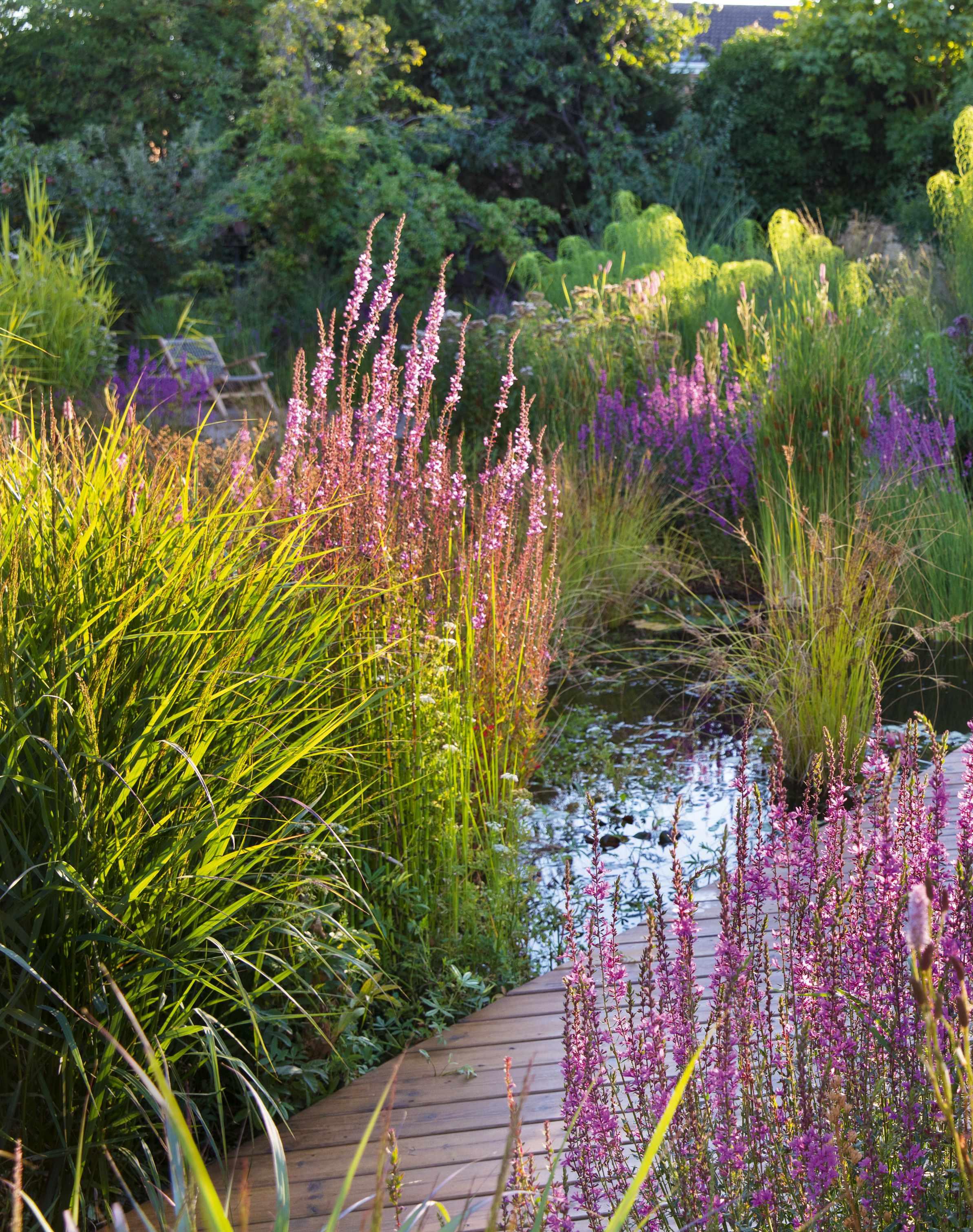
This suburban garden has been utterly transformed to place ponds, plants and wildlife at its heart
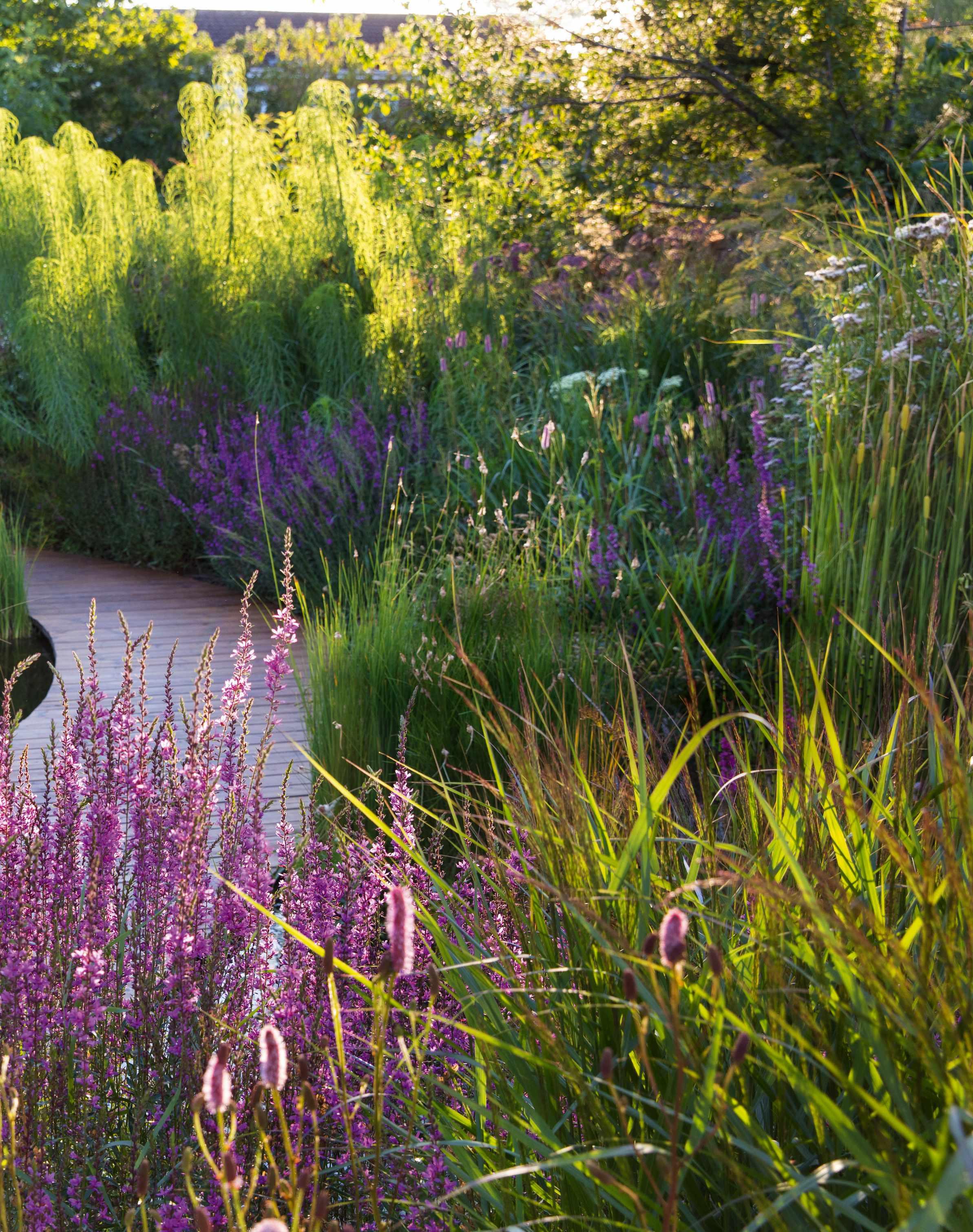 WORDS JANE PERRONE PHOTOGRAPHS SARAH CUTTLE
WORDS JANE PERRONE PHOTOGRAPHS SARAH CUTTLE
A patchwork of ponds and sunken tubs containing a variety of aquatic and marginal plants creates an apparently seamless scene, where planted beds, pond margins and water merge together beautifully. Repeated plants, including

Many of us revamped our gardens during the lockdowns of the Covid pandemic, but few of us can claim to have embarked on projects of quite the scale achieved by André Schott. In just three years, he has transformed the garden behind his semi-detached suburban home into a watery landscape that looks as if it could have been here for decades.
When he moved here from London six years ago, in search of more outdoor space, André already had a clear vision. It drew on a lifelong fascination with water, birthed from his childhood in the Netherlands, where every spare moment was spent exploring the many bodies of water for which his country is renowned. “That’s my favourite part of nature – where the water meets the land,” he says. His dream was to create a water-meadow garden, filled with plants
that thrive in and around wet places. “The idea is to walk through the garden and not really know where one pond ends and another begins.” By placing water at the centre of his scheme, André believes he has approached things differently from the majority of people who add water to their gardens. “Ponds are rarely integral to naturalistic design, where they are part of the border,” he says. “Normally all you get is a single circle of marginal plants – the pond and the garden are two separate things. I wanted to integrate the ponds into the design.”
In November 2019, he asked garden designer and landscape architect Hayley Hughes of Warwickshire-based Plantology to use his ideas to create an overall design for the space and the planting. “André had already made a sketch of three planting communities that he named Low Marsh, High Marsh and Water Meadow,” says Hayley. “He also provided a detailed list of desirable plants and some
The idea is to walk through the garden and not really know where one pond ends and another begins
inspirational imagery of planting he admired. It was a pleasure to work with such an exciting concept.”
André was confident with the aquatic side but less so with the landscaping, and was keen to avoid costly mistakes. “He wanted to ensure that the planting communities met his aesthetic desires, and that they would be stable and reliable in the long run, while working ecologically to achieve a wetland look on dry soil,” explains Hayley.
Everything changed with the pandemic lockdown in 2020. With time on his hands, André went full throttle. He found a builder to dig out huge quantities of soil to make way for water. The ponds and the outline of the paths were completed by the end of the year, and the garden filled with plants the following spring.
The plant palette in the garden is deliberately pared back. André and Hayley drew from the limited number of temperate species

André Schott has to clean some blanketweed from the ponds, but instead of a filtration system, he uses clever planting to keep algae down.
1 Mentha cervina Known as water spearmint, this is a Mediterranean member of the mint family that grows in shallow water, producing whorls of lilac flowers. 40cm. RHS H7†
2 Lythrum virgatum ‘Dropmore Purple’ Purple loosestrife (shown here with Equisetum hyemale) is prized for its ability to grow equally as well in borders as in wet soil at the water’s edge. Reddish-purple flowers in loose flower spikes from summer to autumn. 1.5m. RHS H6.

3 Juncus inflexus Hard rush is a British native plant that forms dense clumps in shallow water. Densely tufted, with blue-green cylindrical stems. 80cm. RHS H7, USDA 4a-9b.
Key plants continue over the page
André extends his gardening below the water, filling the ponds with underwater oxygenating plants such as Potamogeton lucens. A loose hedgerow of native species screens the garden from neighbouring properties and provides a habitat for wildlife.
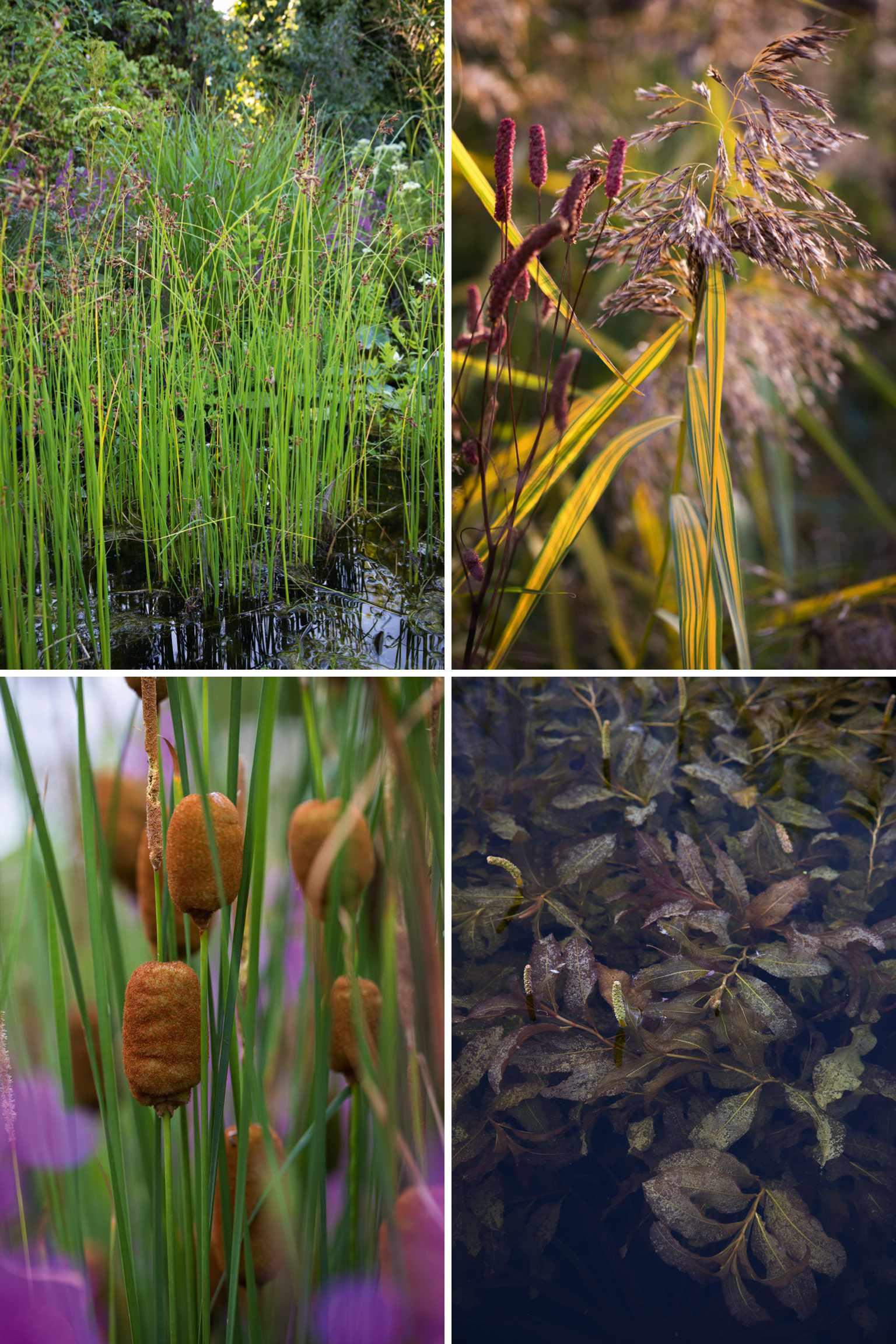
4 Schoenoplectus tabernaemontani Great bulrush is an attractive British native sedge, with small, brown flowers in summer, offering height and texture. 2.5m. USDA 4a-9b.
5 Phragmites australis ‘Variegatus’ This vigorous rush, with green and gold-striped leaves, is a sport of the Norfolk reed, and works as a natural filter at the margins of ponds. Not as invasive as the straight species.
Pictured with Sanguisorba ‘Blackthorn’. 1.2-3m. RHS H7.

6 Typha minima This more compact bulrush is ideal for smaller ponds and it flowers earlier than other Typha species, in early summer. 60cm. RHS H6, USDA 3a-10b.
7 Potamogeton lucens Shining pondweed is an oxygenating aquatic plant, native to the UK and Europe, with large, shiny, olive-coloured leaves. 1m.
†Hardiness ratings given where available.
that could thrive with their roots either in water or on land, such as Physostegia virginiana. The heavy clay soil holds nutrients and moisture well, making it ideal for plants that crave wet feet, such as Lythrum virgatum ‘Dropmore Purple’ – one of the garden’s summer stars. Its intense purple spires stitch together patches of reeds and grasses, including Juncus inflexus and Panicum virgatum ‘Squaw’.
By sinking large tubs into the ground at the margins of the seven ponds, André can incorporate aquatic plants such as reed species into a flowerbed, so plants blur the boundaries between land and water. A loose, mixed hedgerow of mainly native species such as elder, hazel and hawthorn at the boundaries of the garden softens the visual impact of the neighbouring houses, and offers shelter to wildlife.
Adding a mass of plants to the water from day one was part of André’s strategy to evade the bane of every pond-maker’s life:
algae. He wanted to create a low-maintenance pond system, with no filtration, relying instead on the right combination of plants to win the battle against algae. A depth of 80cm in places – the maximum here – helps create enough volume of water so that the ponds can survive both freezing in winter and the stress of a hot summer.
Level shelves have been incorporated within the ponds at different depths, which allows André to position aquatic plant containers to sit at the right depth without being visible from above. André regularly removes blanketweed, but finds that the water is mostly kept clear via a submerged garden of plants, from waterlilies, whose leaves shade the surface, to fully submerged oxygenators such as Potamogeton lucens, P. crispus and Vallisneria americana. The clear water means the beauty of these plants, which are often overlooked, can be appreciated from above as
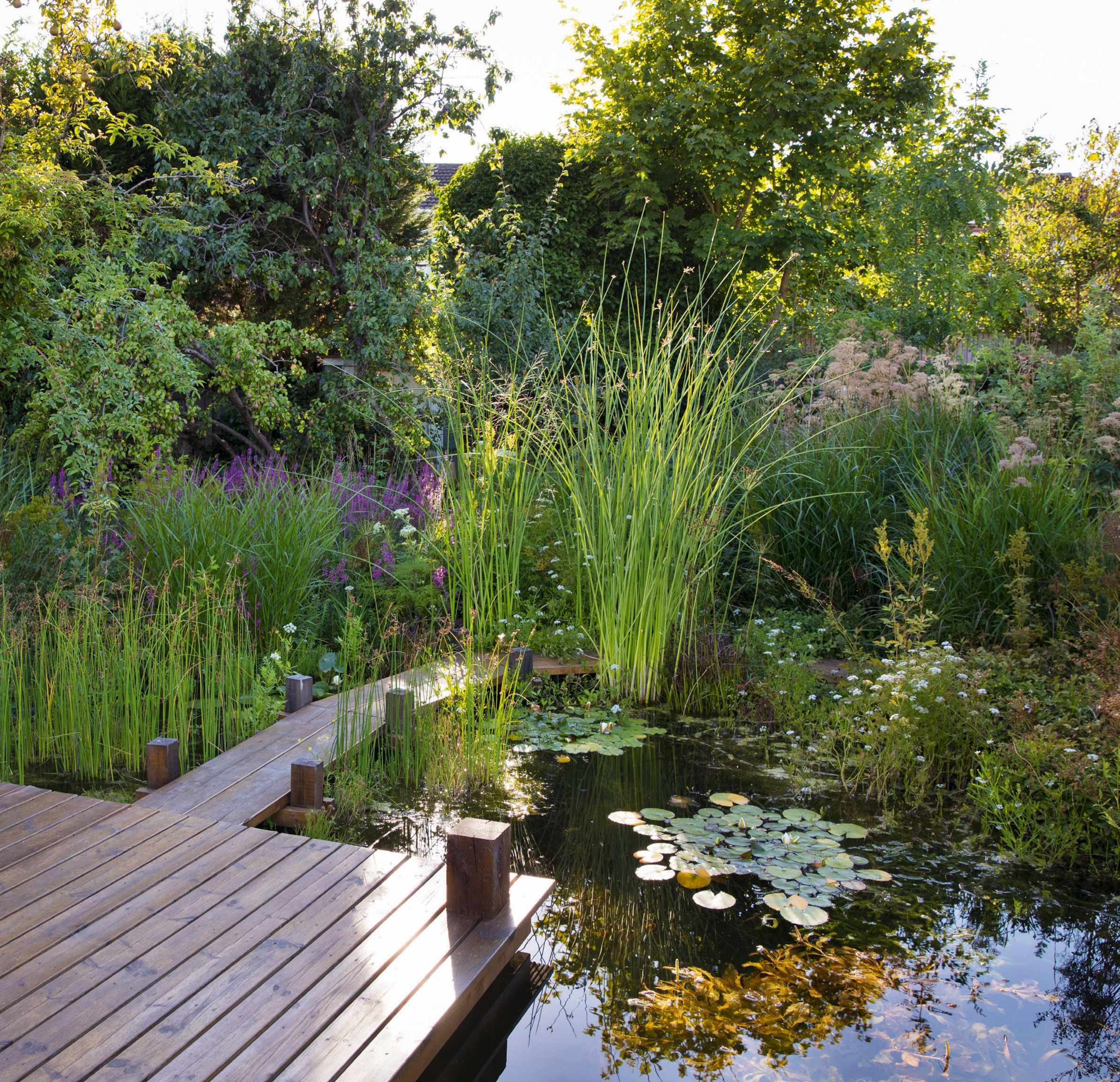
an underwater garden, adding another dimension to the view –down, as well as up and out.
André firmly believes that ponds should be placed front and centre when it comes to naturalistic garden design. “After all, this is where the action is,” he explains. The host of wildlife that visits to enjoy the water, from sparrows to newts, frogs and toads, as well as pond skaters and dragonflies, would surely agree. ■
USEFUL INFORMATION
Follow André on Instagram @water_meadow_gardening
Discover more about Plantology’s work at plantology.co.uk
Find
Phil Sterling is a man on a mission –to convert every motorway embankment, every roadside verge, every unloved patch of grass in our under-resourced urban parks, even every golf course, into a flower-rich haven for wildlife – specifically our threatened populations of moths and butterflies.
Phil fell under the spell of Lepidoptera when he was just five years old. He would go moth-hunting with his father, also an enthusiast. By his teens, he was more expert than his dad, and went on to study zoology at Oxford, progressing to a DPhil on the ecology of the brown-tail moth, and a research fellowship at Balliol College.
It is always moths that have been his first love, perhaps because they are so widely misunderstood. He regrets the common perception of moths as annoying little grey things that eat our clothes. In fact, there are only four species out of 2,500 that could possibly be culprits, and only two of these are jumper-munchers for certain. And far from being drab, moths – especially the day-flying moths, of which there are many – are often exceptionally beautiful. “It’s a bit like Christmas every time you open a moth trap and see how many species there are, all the different colours and patterns: you’re amazed at what you find.”
In 2018, as he reached his late fifties, Phil landed his dream job – working for the national charity Butterfly Conservation, offering practical advice on how to plan and manage the built environment to support wildlife, particularly butterflies and moths. But in his twenties, a scientist who wanted to work with moths had few choices: most of the job options seemed to involve exterminating them. So Phil took a left turn and became the insect expert on a team engaged in restoring grasslands. This gave him the expertise in habitat creation that stood him in such good stead when he joined Dorset County Council (as it was then) as its principal ecological adviser – a role in which he reformed the management of the county’s public realm over 25 years, enriching nature reserves and country parks, transforming denatured urban areas by planting trees and changing featureless grass areas into wildflower meadows rich in wildlife.
It was Phil who designed the wildflower banks on the A354 Weymouth Relief Road (built 2009-11) that wow visitors every year with their glorious displays of blooms – shimmering sheets of yellow in spring (trefoils, hawkbit, cowslips) followed by sumptuous summer purples (including colonies of orchids) dancing with clouds of bees, butterflies and moths. It took him a while to realise that people were stopping their cars in the lay-bys not for any emergencies, but to get
out and photograph the flowers. “It’s a very simple formula,” he says. “The less fertile the soil, the more flowers you get, and the more insects you can support. In a world where biodiversity is in crisis, we need to do things in a different way with our amenity landscapes, making them more permeable to wildlife.”
Standard practice in landscaping schemes is to cover the ground with a deep layer of topsoil, sow a grass mix, then plant shrubs and trees, creating a high-maintenance landscape that favours coarse grasses and needs regular mowing. But if instead a wildflower mix is sown directly on to a mineral substrate – mimicking the conditions of our richest grasslands, which always occur on the poorest and thinnest soils (such as limestone and chalk) – not only do wildflowers thrive, but the need for maintenance decreases dramatically: such grass as does arrive doesn’t grow long, and doesn’t need mowing.
“The native wildflowers we cherish – the vetches and scabiouses and knapweeds – really like being stressed: no nutrients, hardly any water. Compare that with the thistles, docks and hogweeds of this world: if you give these competitor plants rich, fertile soils, they grow big and tall, smothering and shading out all the ones that can tolerate stress. The key is to create the right environmental conditions for the stress tolerators to thrive. It won’t stop all the competitors, but they won’t be able to out-compete the others because there aren’t enough nutrients in the soil.”
Some 25 species were sown on the Weymouth road verges, but many of his successful urban schemes use as few as three – bird’s-foot trefoil, ox-eye daisies and common knapweed. In addition, implementing a cut-and-collect regime for mowing existing verges has reduced grass growth, encouraged more flowers, and saved hundreds of thousands of pounds in maintenance. “You win hearts and minds by showing people results – and good results were very quick to arrive,” says Phil. The tally of plants on the banks now exceeds 140, while over 30 species of butterfly – half the total number of species in Britain– have been recorded. National Highways has now adopted his methodology as a template for road-verge design, but Phil is far from thinking his work is done. He would really like a policy role in which he could influence government thinking. “We now have the evidence that reversing biodiversity loss actually saves money: that’s a message that more people need to hear.” ■
Butterfly Conservation’s Big Butterfly Count runs from 14 July to 6 August: bigbutterflycount.butterfly-conservation.org
Find out more about which plants to grow to encourage butterflies at gardensillustrated.com/butterflyplants
THE LESS FERTILE THE SOIL, THE MORE FLOWERS YOU GET, AND THE MORE INSECTS YOU CAN SUPPORT

An experiment in “letting go and learning to trust nature”, Frank van der Linden’s garden pushes the boundary that once kept nature at bay. In the nursery area where propagated plants are set out, the large, reclaimed flagstones are interplanted with colourful, insect-encouraging perennials.

Dutch designer Frank van der Linden’s garden is a study in seamlessly integrated functionality and naturalism – an approach developed more by accident than design
WORDS MATT COLLINS PHOTOGRAPHS MAAYKE DE RIDDER
Striking a balance between an overly cultivated garden and one that permits nature – wildlife, weeds and all – the freedom to roam is about the most topical challenge in horticulture right now. The principles are in place: chemicals are all but banished, May is becoming unmown, and slugs and snails are being rebranded. The question now is how, rather than why, we should provide for nature in our gardens. Frank van der Linden, a naturalistic garden designer based in the Netherlands, is well versed on this subject, and the move towards a more wildlife-inclusive vision for his own garden near Eindhoven had somewhat serendipitous beginnings.
“Twenty years ago, I started the garden with the aim of establishing a nursery for perennial plants and grasses,” says Frank. “But around 2017, the garden was left to its own devices for a couple of years while I was busy setting up another nursery. When I returned to it, it had become neglected in parts.” Within the structural footprint of hazel and
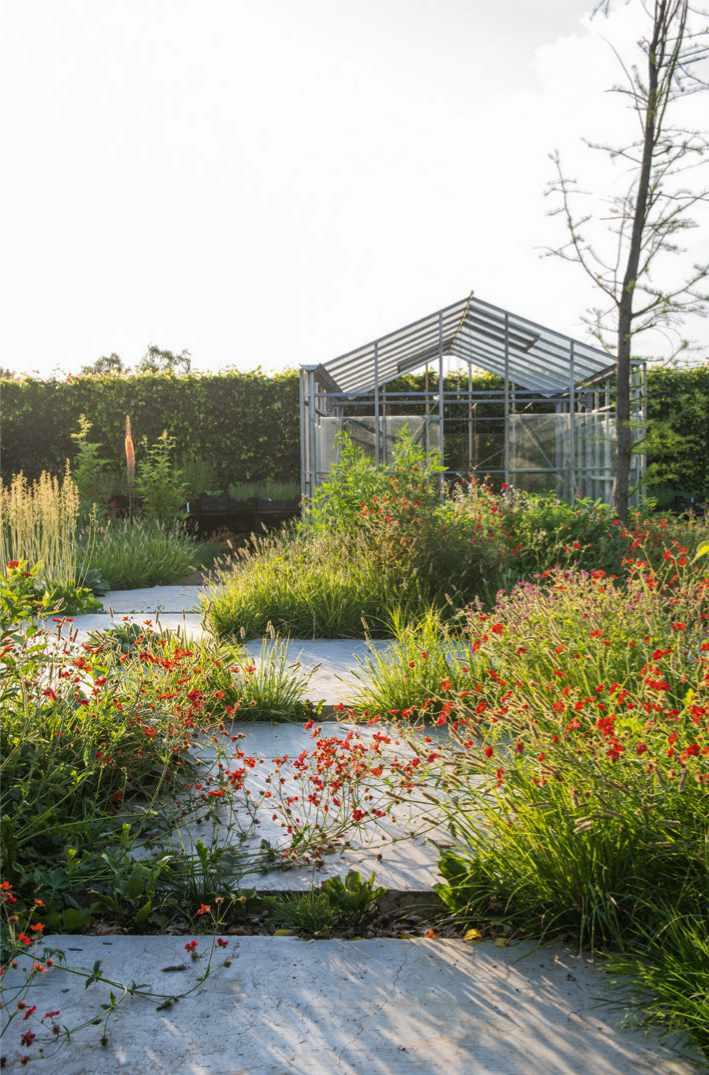
Above Scarlet Geum ‘Mrs J. Bradshaw’ catches the light as it spills over the concrete slabs around the greenhouse, which is used for growing perennials.
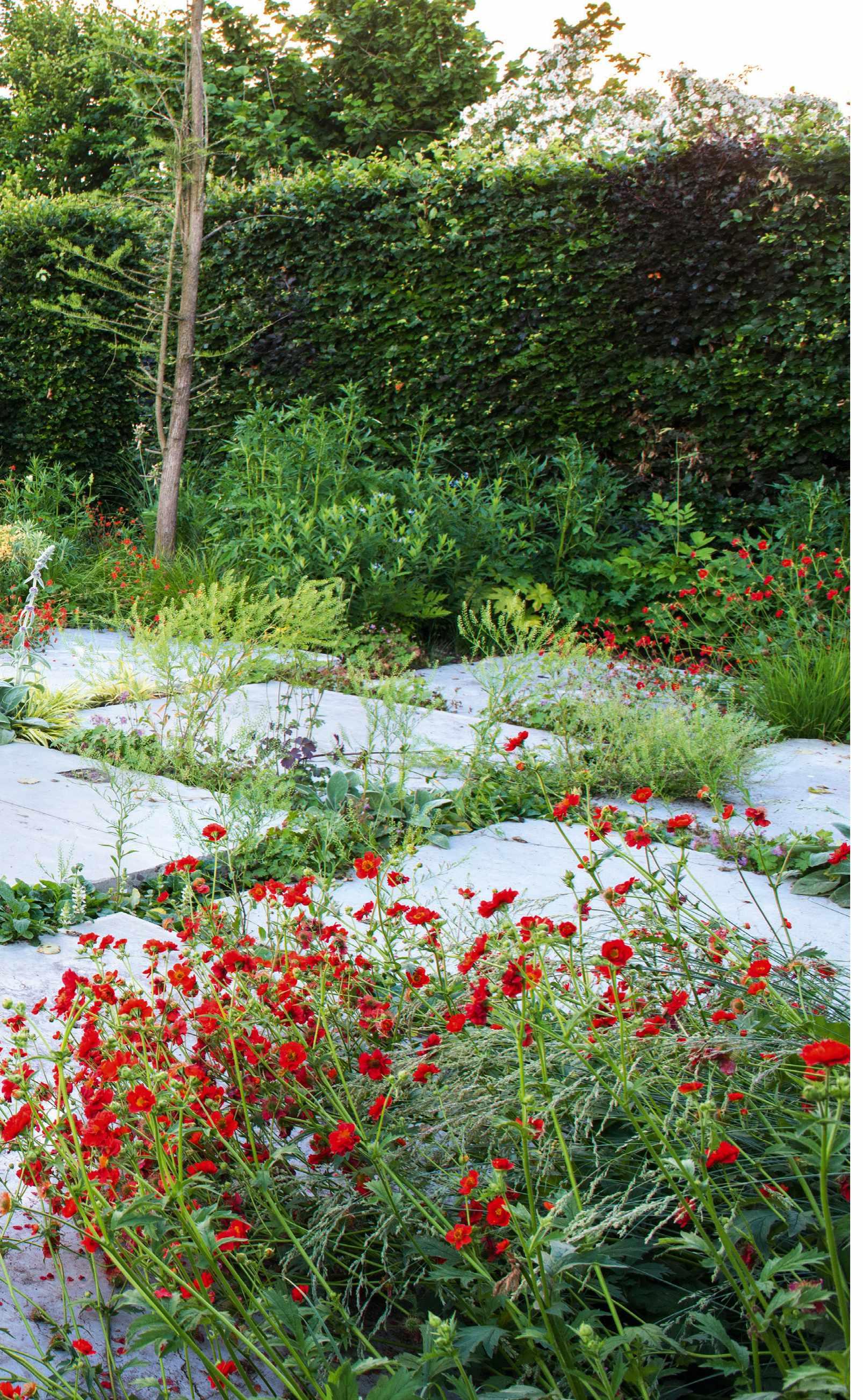
Right Frank van der Linden pictured with a stem of the tall, green-white umbel, Peucedanum verticillare
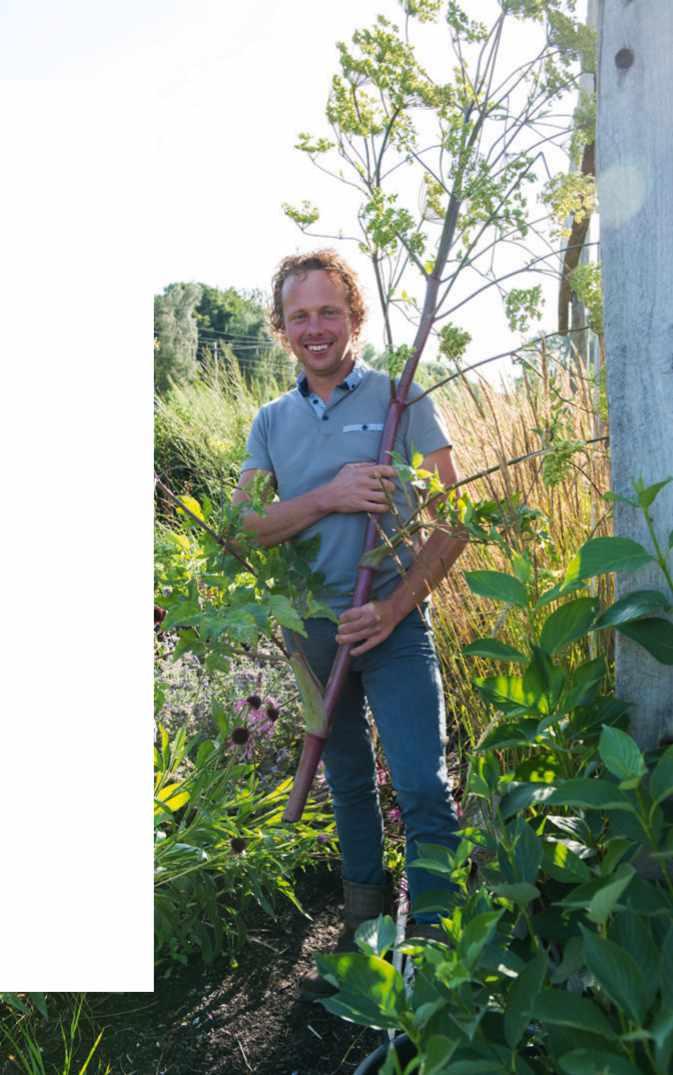
Below Drought tolerant and densely bloomed, Heuchera richardsonii is a perennial from northwest America, which is well suited to both sunny and woodland gardens. Its elegant, cream-white flowers and attractive foliage make it a good groundcover plant

The lushly growing meadow areas provide a peaceful atmosphere for gardener and wildlife alike, as Frank endeavours to create a welcoming space for birds and small mammals.

Frank suggests that gardening with wildlife in mind can be a creative, selective process. “In the garden, I remove weeds with spreading, perennial roots, such as bindweed,” he explains, “but I select the beneficial or ‘functional’ weeds that occur naturally at that particular site, and then sow them as groundcover –plants such as lamium, purslane, Geranium robertianum or ribwort plantain, for example. These develop unique shapes and characteristics that cannot be found in purchased plants, and form a spontaneous layer in the garden.” Into this layer, he will then plant cultivated perennials and ornamental grasses such as deschampsias and Molinia caerulea subsp. arundinacea ‘Windspiel’. “The benefit is that, when I choose my weeds, I don’t have weeds.
If the space is filled and the ground is covered, no other weed seeds will germinate.” Accommodating a range of ‘weed’ species also ensures a longer season of coverage; for example, myosotis for spring, plantain for summer, purslane returning for winter.
“Many of the species I cultivate are biennial, with a long blooming period for bumblebees and other insects.” Some gardeners might struggle with the idea of allowing such plants to proliferate, but for Frank this is part of “letting go and learning to trust nature”.
Frank also advocates spreading a deep layer of mulch on top of the ground. “Soil should be seen as a living organism,” he says.
“I use mulch everywhere to keep the ground closed, and I strongly support the no-dig method.”
There’s a fine line between wildness and control in the garden. Every centimetre of soil is covered with vegetation
beech hedges, weeds had taken over the planted borders, which had become overgrown with nettles. “I noticed that this had led to a significant increase in biodiversity.” Rather than restore order, this inspired a new direction for Frank’s garden and his wider approach to garden design – one that would provide functionality for users while creating living spaces for wild plant species and animals. “My eyes were opened to working with nature and understanding what it wants from – and with – a garden.”
The garden is now rife with “opportunities to play with the boundary between nature and culture”, as Frank puts it. There are sections of meadow interplanted with cultivated perennials such as Calamagrostis x acutiflora ‘Karl Foerster’ and Veronicastrum virginicum ‘Lavendelturm’. Self-seeded herbs drift through the vegetable garden, and fruiting trees and shrubs contribute to a ‘food forest’, containing edible species, such as hawthorn and hazel, whose abundant nuts and fruit are shared with the local wildlife. “There’s a very fine line between wildness and control in the garden. Every centimetre of soil is covered with
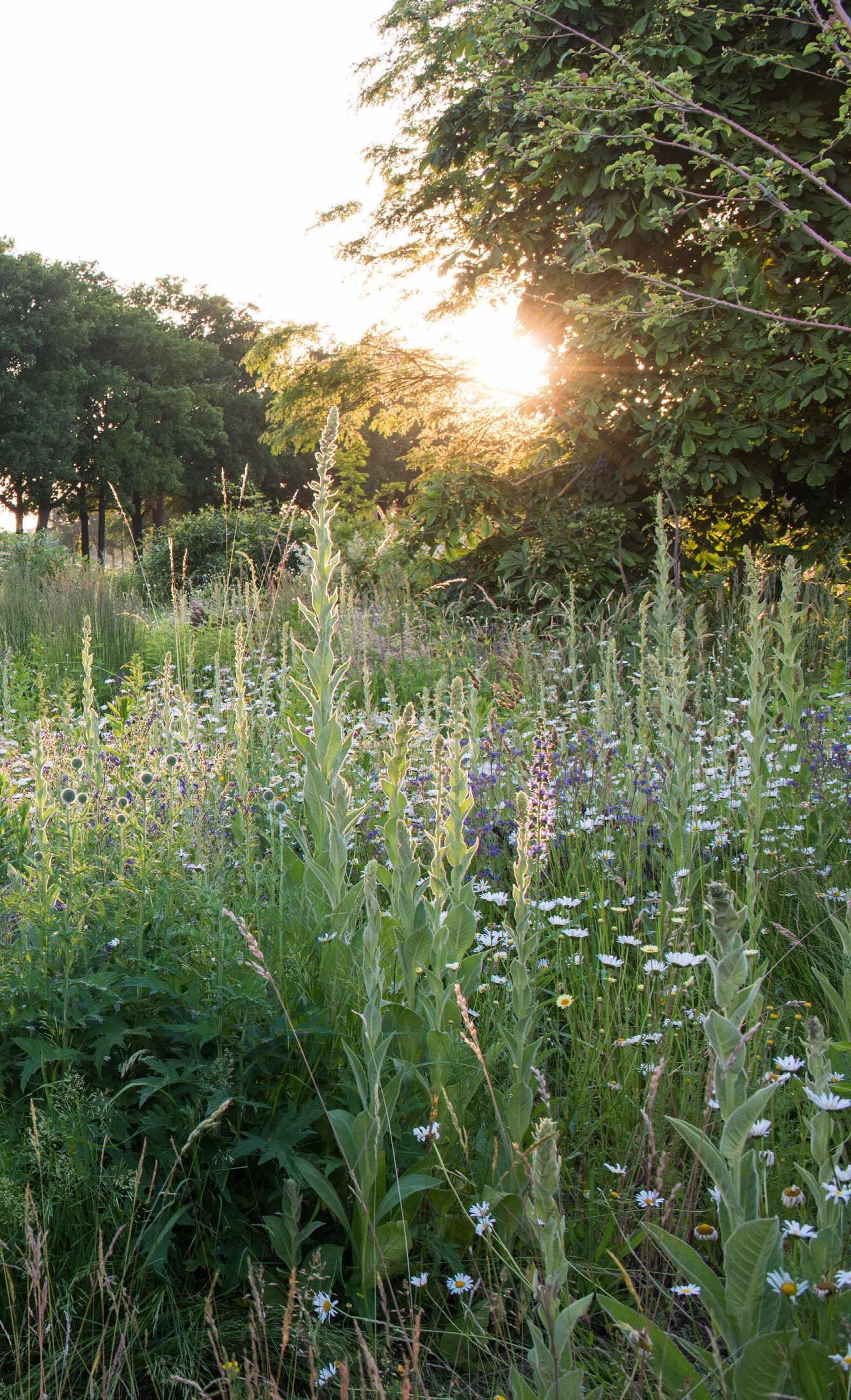
Above In the meadow, handsown local wildflowers such as the rich-blue Echium vulgare are interplanted with cultivated perennials.

Right Common bugloss (Anchusa officinalis) is fantastic for wildlife. Its tall, abundant spikes of deepblue flowers last well throughout summer.
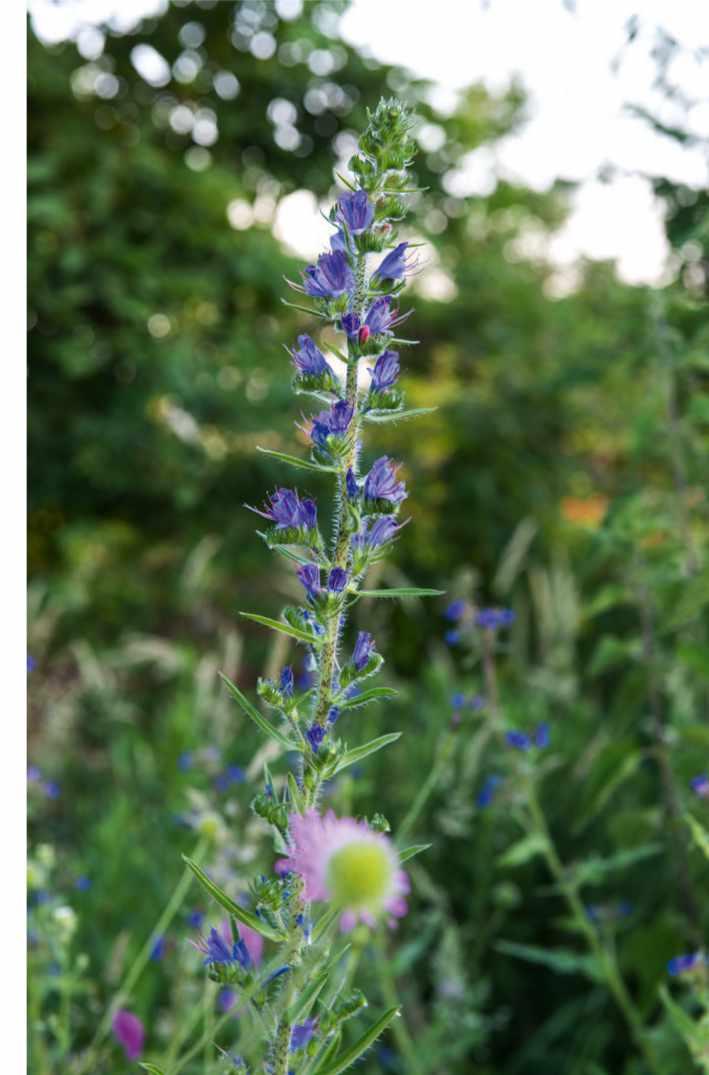
Below Among the grasses, daisies and verbascums of Frank’s meadow float the pincushion blooms of Knautia macedonica, valued for its branching stems bearing vibrant, compound flowers.
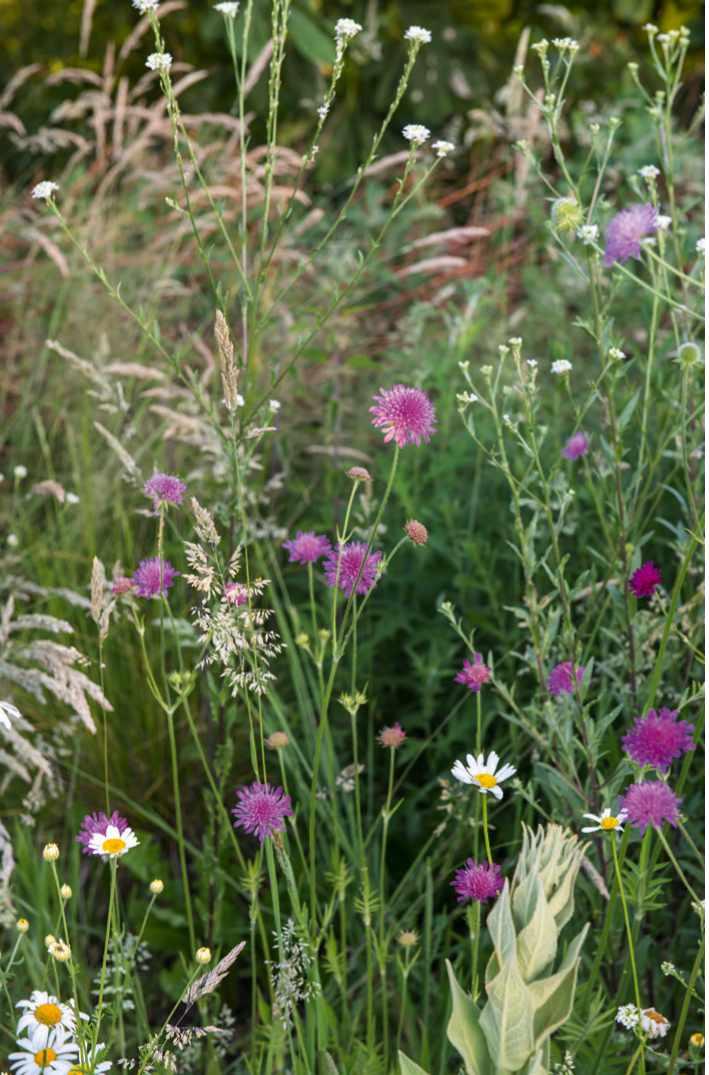
vegetation and paths are mown through the lush growth, ensuring that there is a peaceful atmosphere, and providing a pleasant place for birds and small mammals.”
The area once set aside for propagation now demonstrates a similar ethos. Laid out around Frank’s greenhouse, reclaimed concrete flagstones provide space for propagated material in crates, while the gaps in between have been planted with broad clumps of Geum ‘Mrs J. Bradshaw’, Lythrum salicaria ‘Blush’ and Stachys byzantina ‘Big Ears’, alongside pollinator-friendly Geranium x cantabrigiense ‘Karmina’ and the muted, slender stems of Heuchera richardsonii. As a result, the space relinquishes any sense of rigid formality; it provides for nature yet remains easily traversable as a production area.
Over time, Frank found himself focusing more on the garden than on nursery plant cultivation. The plants he now propagates are predominantly destined for his various garden projects, designed under the name Van Nature. “I aim for the greatest possible diversity, and like to grow native trees and shrubs as well as those chosen for the birds, so
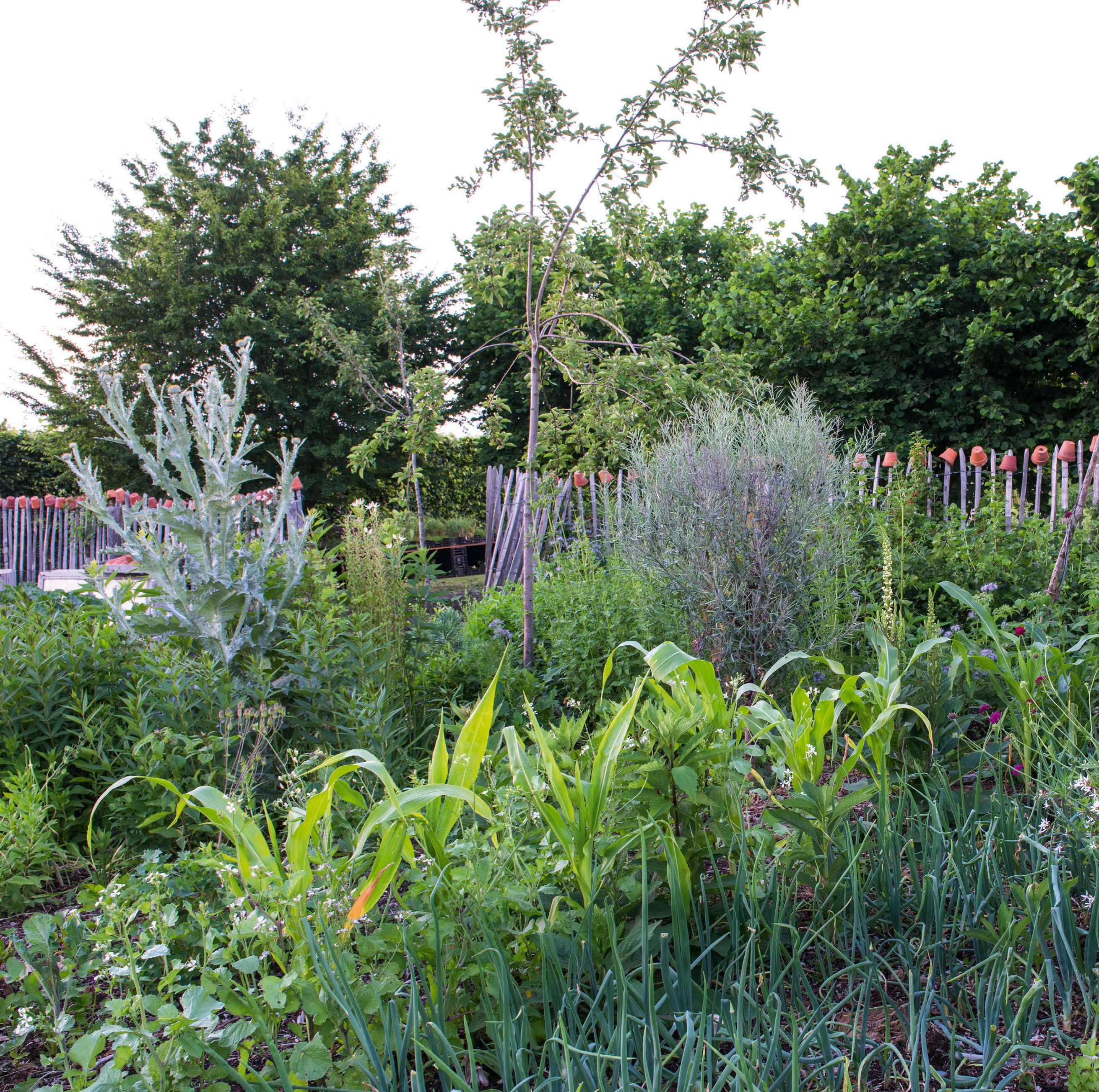
I aim for the greatest possible diversity and like to grow native trees and shrubs as well as those chosen for the birdsAbove In the vegetable garden Frank uses coppiced hazel as a supporting frame for thornless blackberry and the hardy kiwi fruit, Actinidia arguta. Wildflowers are encouraged to seed among the sweetcorn, onions and gooseberries.
a lot of hazel, amelanchiers, euonymus, Crataegus monogyna, Cornus mas.” If clients need convincing as to the benefits of this naturalistic approach, he has a trick up his sleeve. “I plant a shrub such as Euonymus europaeus, and by early June the caterpillars arrive and start eating it. When the client asks for help with the ailing plant, I advise them to watch the birds coming after the caterpillars to feed their young. Eventually, the euonymus starts to grow again, and people begin to see how everything has a purpose beyond being nice to look at.”
In the two decades Frank has been making this garden, the work has been physically demanding. Since shifting towards gardening in sympathy with nature, however, he has been able to enjoy the garden far more. “There is more time to sit and watch the plants, birds, insects, bats, hedgehogs – it’s inspiring. I continue to learn from nature every day.” ■
Above A multi-stemmed, reliably perennial verbascum with metre-high spikes, V. nigrum var. album attracts pollinators into the vegetable garden.

Right Rosa ‘Wedding Day’ rambles over hazel supports at the edge of the productive garden, where split, pale fencing is alternately topped with mini terracotta pots.


Below The quince Cydonia oblonga ‘Vranja’ Nenadovic forms part of Frank’s ‘food forest’. It has many desirable attributes: fruit, abundant flowers and attractive foliage.
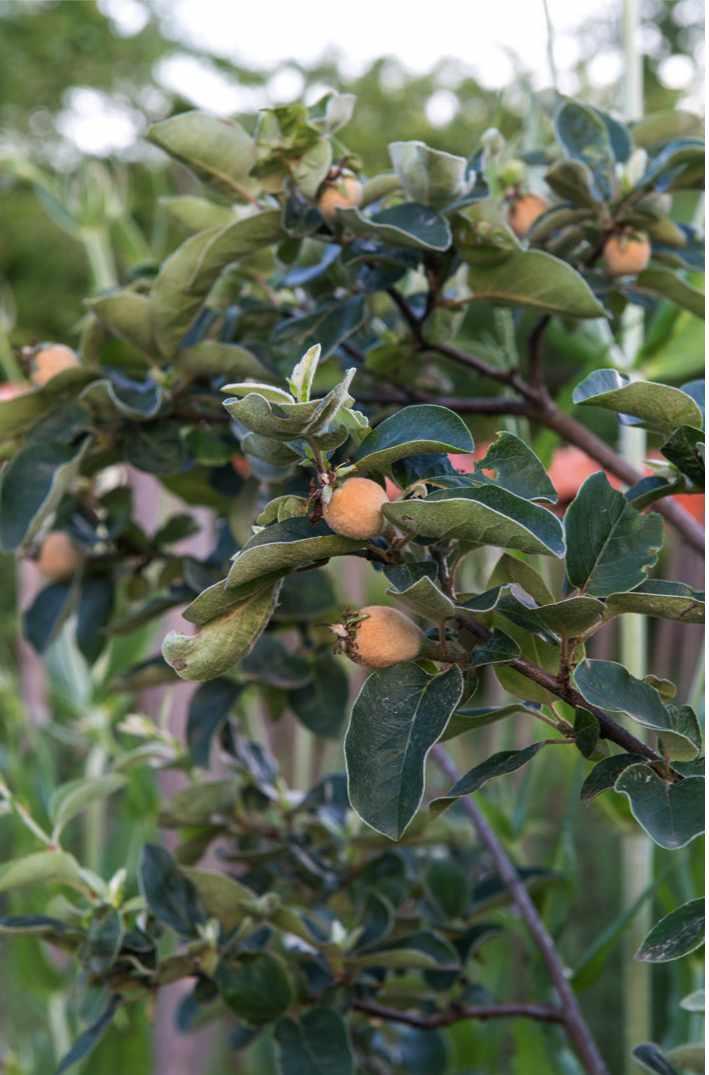
Gardeners have a fraught relationship with wild plants and weeds, but there is a growing movement to appreciate the charms and biodiversity benefits of these native plants and early colonisers. To offer a fresh perspective, we’ve elevated typical uninvited garden guests to be the stars of exquisite cut-flower displays, inspired by art and bound to change your mind
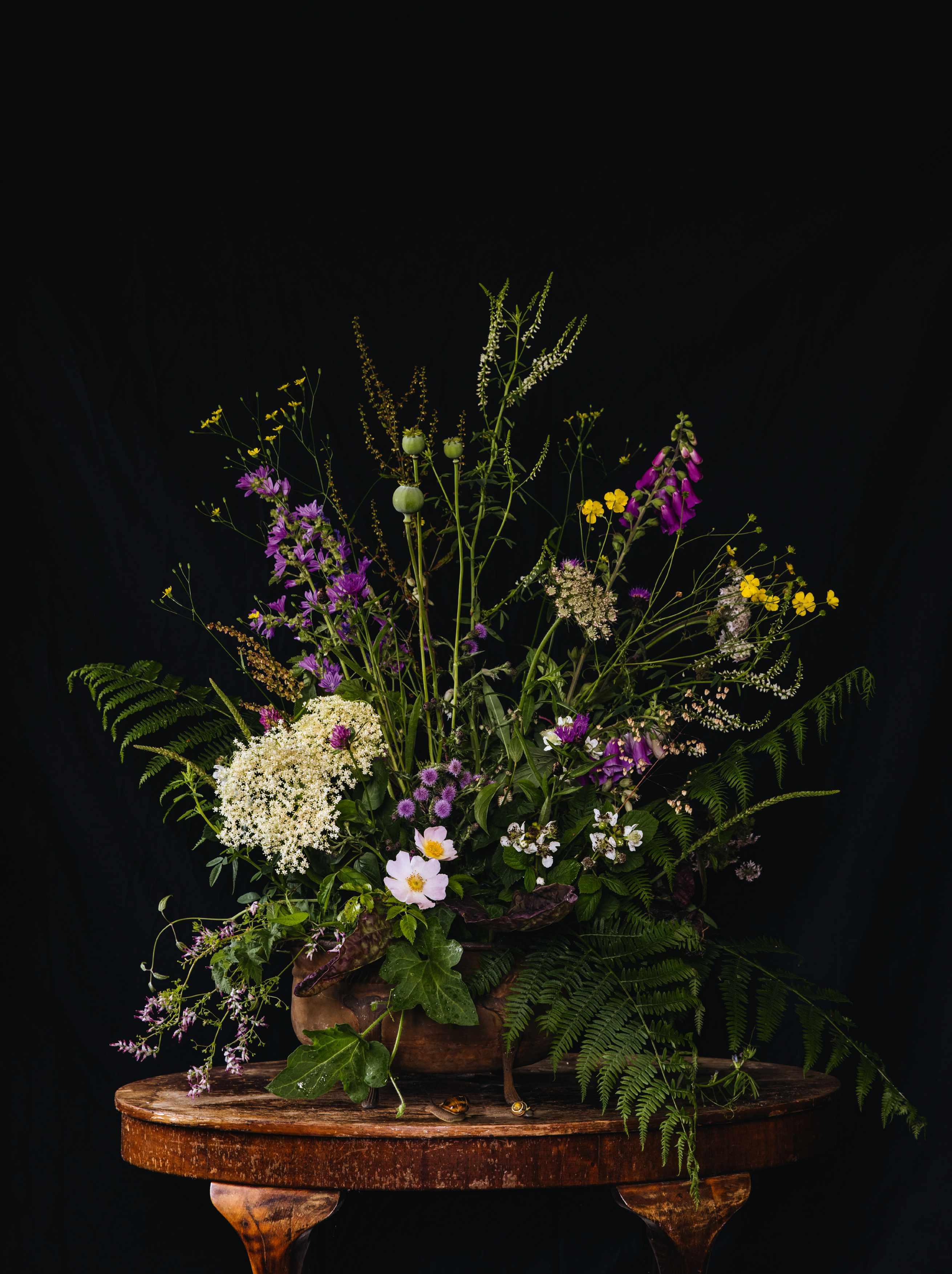 STYLING AND WORDS JACKY MILLS PHOTOGRAPHS ÉVA NÉMETH
STYLING AND WORDS JACKY MILLS PHOTOGRAPHS ÉVA NÉMETH
I’ve always been drawn to the work of the 18th-century Dutch still life painters, dynamically lit to increase the contrast of light and dark – a technique known as chiaroscuro. The inspiration for this arrangement came from Jan van Huysum’s painting Flowers in a Vase, and like his painting, it includes wildlife in the form of snails – a reminder that all life is important along the food chain.
This old metal ornamental vase was perfect for the display with its low, wide curvaceous shape raised on ornate legs. I placed a narrow, elliptical glass vase inside, and added two layers of one-inch gauge chicken wire, secured with pot tape. This helps hold the stems in position, removing the need for floral foam. I then filled both vessels with cool, fresh water.
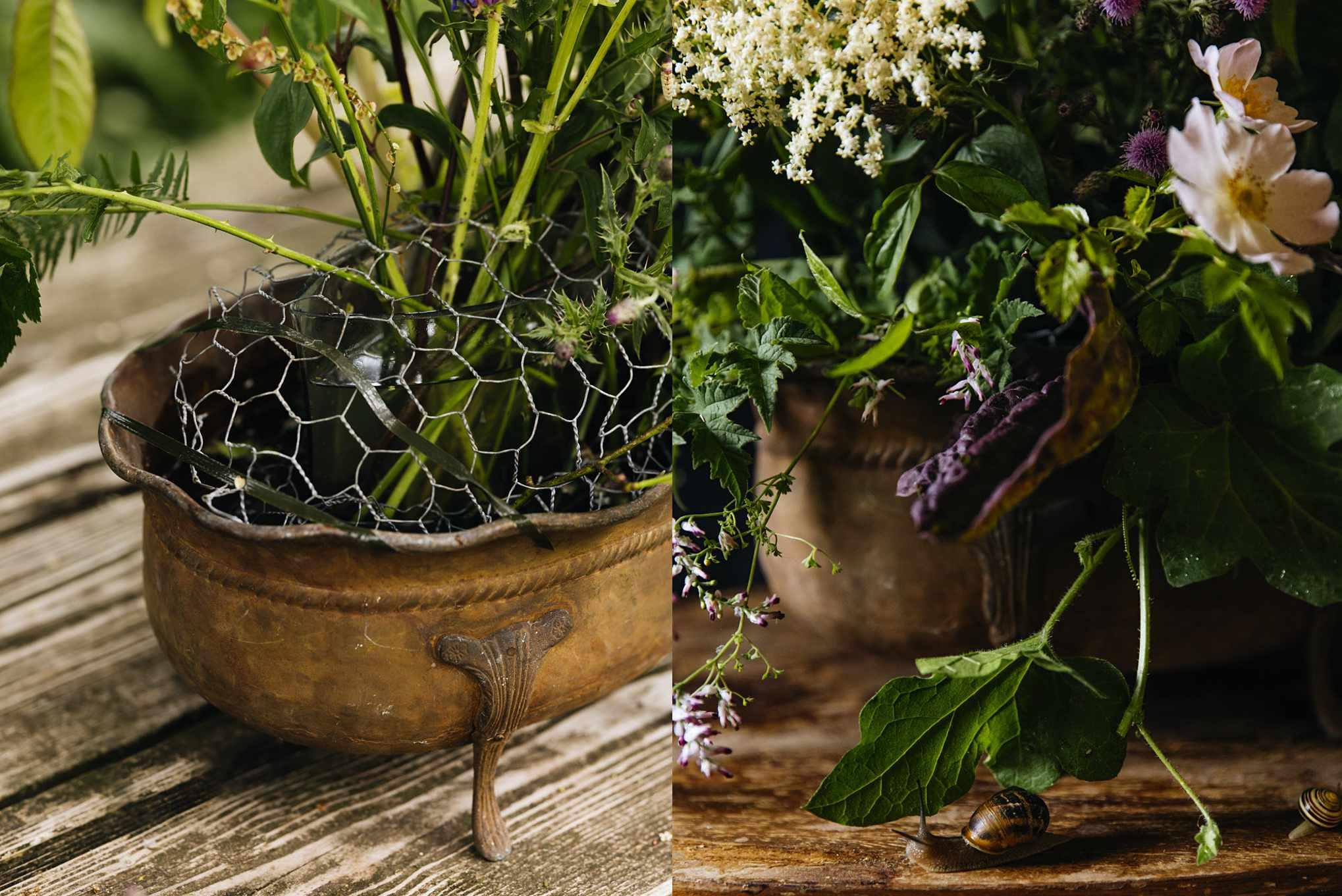
This arrangement includes an array of different species, mostly chosen for their value as food plants for wildlife. Big and bold flowerheads contrast with a host of spiky, soft, rough and smooth leaf shapes. The inclusion of very short stems gives the arrangement depth, while curvaceous stems extending beyond the vase give movement and flow. The flowers and foliage were picked late the previous evening and conditioned in plenty of water overnight. Each stem was recut before placing in the arrangement.
Foliage from leafy plantains, elder and bracken was placed first, starting with a couple of low branches of dogwood to give further support to the taller stems. Umbelliferous flowers of common hogweed, wild carrot, elder and a group of mauve thistles added mass and the dog rose became the focal point. I added uprights in the form of mallow, bramble, poppy seedheads, clover and foxglove, complemented by slim flower spikes of plantain, sorrel and quaking grass, and curvy wisps of white bryony and old man’s beard. The colour scheme involved a harmonious blend of pinks, mauves, creams and whites, with a spattering of yellow from the buttercup on one side, balanced on the other by the slightly finer nipplewort.
Briza maxima – greater quaking grass
Briza media – quaking grass
Bryonia dioica – white bryony
Chamaenerion angustifolium – willowherb
Cirsium palustre – marsh thistle
Clematis vitalba – old man’s beard
Cornus sanguinea – dogwood
Daucus carota – wild carrot
Digitalis purpurea – common foxglove
Fumaria officinalis – common fumitory
Heracleum sphondylium – common hogweed
Lapsana communis – nipplewort
Malva sylvestris – common mallow
Melilotus albus – white melilot
Papaver somniferum – opium poppy seedheads
Plantago lanceolata – ribwort plantain
Plantago major – broad-leaved plantain
P. major ‘Atropurpurea’ – purple-leaved plantain
Pteridium aquilinum – bracken
Ranunculus acris – meadow buttercup
Rosa canina – dog rose
Rubus fruticosus – wild bramble
Rumex acetosa – sorrel
Rumex obtusifolius – broad-leaved dock
Sambucus nigra – elder
Silene dioica – red campion
Silene latifolia subsp. alba – white campion
Silene vulgaris – bladder campion
Trifolium pratense – red clover
I’ve amassed quite a collection of old wooden drawers over the years. I use some as salad containers and others as mini cabinets or plant theatres to showcase cherished pots or vases of flowers around the garden (a potager blend of herbaceous intermingled with vegetables and wildflowers). Our lawn is a thick mossy sward, dotted with an array of ‘weeds’ before it transcends into meadow – all buzzing with insect life. An immaculate lawn can set flower borders off beautifully, but as we experience falling insect numbers, it makes sense to allow part of the lawn to return to a flowery mead. In Britain, we are becoming more familiar with No Mow May and leaving areas of the sward to grow longer, providing more habitats and food for struggling wildlife. Allowing wildflowers to colonise the sward has many environmental benefits: the sponge-like ability of moss and a more diverse root structure to improve drainage will help the lawn cope with flash flooding, and stay greener during hot weather and periods of drought, if not cut too short.
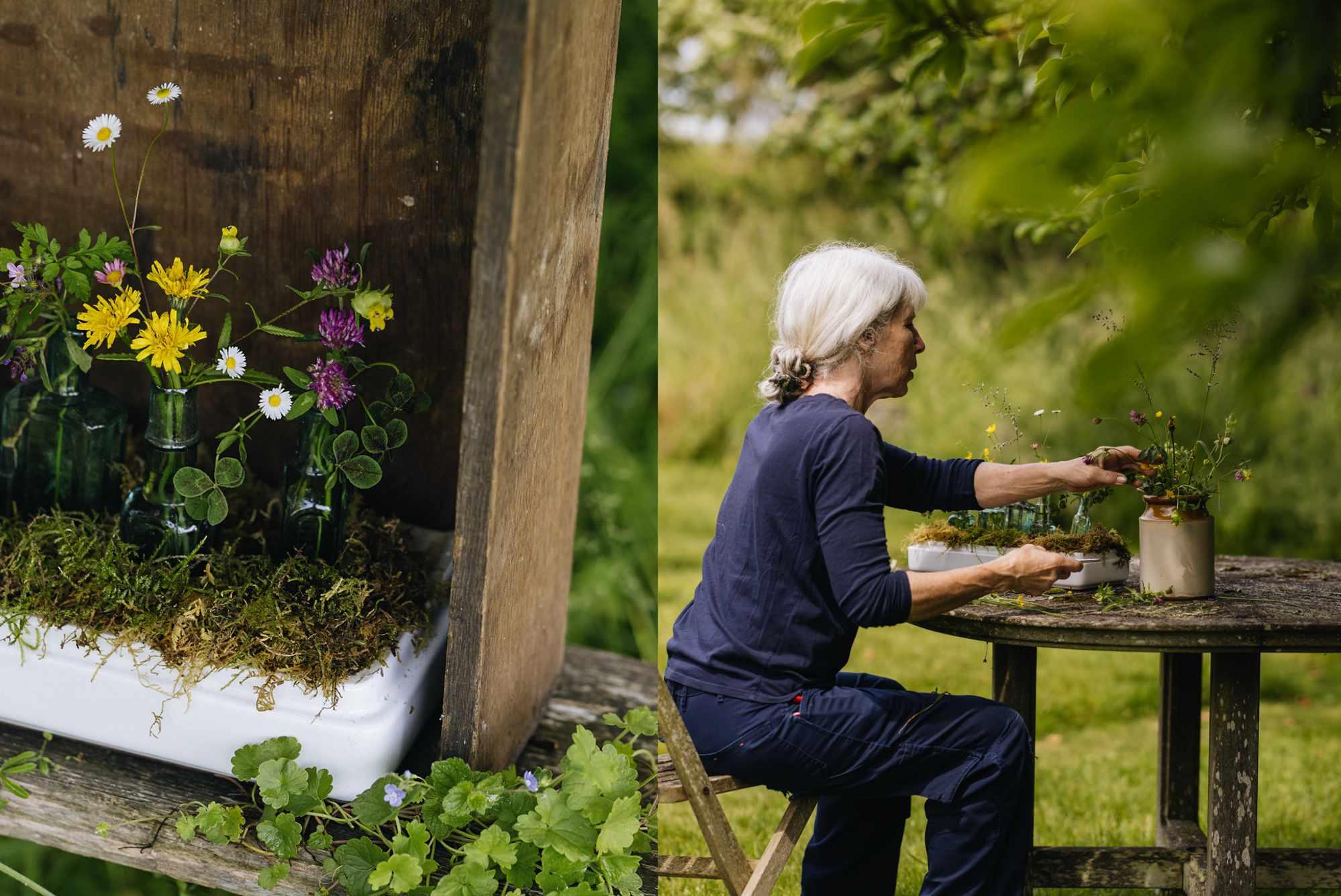
Creating an arrangement in an upturned wooden tray, drawer or wine box focuses attention on the display even more. For this arrangement, I used a collection of old, glass, medicine bottles with a bluey-green tint and lined them up – in true recycling style – in an upturned, ceramic lid of a toilet cistern, which fitted snugly into the base of the wooden drawer. Moss from my garden was tucked around the bottles to give extra stability and disguise the edge of the lid. I wanted to showcase a collection of lawn ‘weeds’, but some are so tiny that I included a few more ornamental versions of the wilder flowers, such as the darker foliage form of Trifolium repens and the longer, more cultivated daisy heads of Mexican fleabane. I was keen to include a stem or two of yellow rattle, a semi-parasitic stalwart of meadows, alongside some of the more common lawn interlopers.
Bellis perennis – common daisy
Erigeron karvinskianus –
Mexican fleabane
Galium aparine – goosegrass
Geranium robertianum –
herb Robert
Glechoma hederacea –
ground ivy
Hypochaeris radicata –
cat’s ear or false dandelion
Prunella vulgaris – selfheal
Rhinanthus minor – yellow rattle
Trifolium pratense – red clover
Trifolium repens – white clover
Trifolium repens ‘Purpurascens
Quadrifolium’ – black-leaved four-leaved clover
Veronica persica – Persian
speedwell
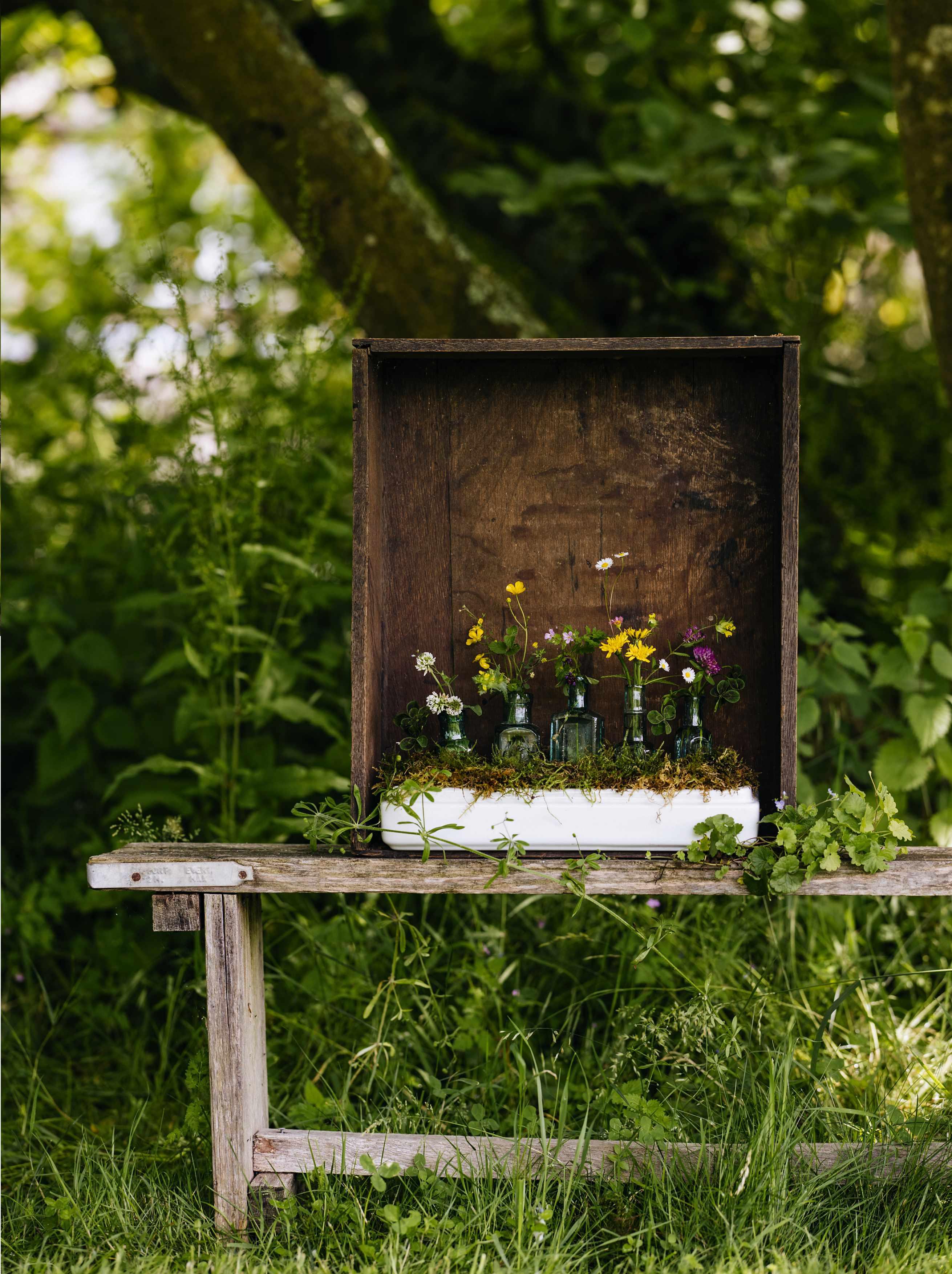

“The notion that a plant is a weed is the most effective barrier for stopping us from looking closely at it”
The Unofficial Countryside by Richard Mabey
Our negative perception of weeds has been exacerbated by years of conditioning that you’re a bad or lazy gardener if you have weeds in your plot. While not advocating that everyone should rush to order a plethora of weed plugs, it would be great if we could all just exercise a little more tolerance of the weeds we do inadvertently grow, learning more about how they could benefit us and wildlife. When I run botanical art workshops, I often use weeds as subjects. Getting people to take time to observe and draw these plants helps them to see just how beautiful and garden worthy they can be and, hopefully, encourages them to re-evaluate their attitudes to weeds and appreciate the wilder things in life.
Simply placing a frame around a vase of flowers helps elevate it to a work of art, even if it holds some of the most despised garden weeds, sitting alongside pretty blue cornflowers, which arable farmers deem as weeds. Ground elder is a notorious thug, spreading quickly through cultivated borders like wildfire, and once entangled in the roots of other plants or bases of walls is difficult to remove without resorting to chemicals. But in June it produces lovely white umbels that are frequented by solitary bees and hoverflies, and it was traditionally used to treat arthritis, rheumatism and gout.
Our hedgerows are home to wild bramble, clematis, hops and honeysuckle. There are many variations in the flower colour of these local brambles. I picked some still in bud for their sculptural quality and used some open flowers of the purest white I could find in the arrangement, to contrast with the verdant green alkanet, spotted with azure-blue flowers. The cornflowers provide a real pop of deeper blue.
After a night conditioning in cool water, the flowers were arranged in a little stoneware vase, embellished with a wrap of green gardening twine around its neck. The frame was draped with ivy, hops and bindweed, and the skeleton of an old, found bird’s nest that I refurbished with mud and moss, to emulate the restorative power of nature. It’s a lovely final touch to the natural feel of this display, but don’t ever be tempted to take a nest from the wild in case birds are still nesting in it. Sometimes it’s simply best to leave nature be.

Aegopodium podagraria –ground elder
Calystegia sepium – hedge bindweed
Centaurea cyanus – cornflower
Geranium robertianum ‘Album’ –
white herb Robert
Hedera helix – common ivy
Humulus lupulus – hops
Pentaglottis sempervirens –
green alkanet
Rubus fruticosus – wild bramble
Weeds vary in size enormously, but they all have several traits in common that make them so successful. They have become a menace because of their adaptability and fecundity. To me, buttercups herald freedom and nostalgic, carefree summer walks through fields, and I have plenty growing in the borders and lawn at home – they make me smile. It’s a shame we don’t tolerate them more in our flower beds, particularly the creeping form, which spreads by runners and seed. It is entirely possible to embrace the weeds and wildflowers in your garden, editing them as you would any other prolific self-seeder, by deadheading early and removing unwanted seedlings and plants before they get out of hand. Understanding how individual weeds grow is key to controlling or cultivating them.
My inspiration for this arrangement came from Lucian Freud’s 1968 painting Buttercups – freshly picked wildflowers simply displayed in an enamel jug, placed in a sink and painted as he saw it. Here, I’ve combined both meadow and creeping forms of buttercup, with the spangled rusty seedheads of sorrel and meandering stems of black medic – a creeping weed found in lawns and pathways, which has yellow flowers that are attractive to bees and butterflies. It recreates the rich, earthy colours that Freud captured so well in his painting, set off by the deep-brown glaze of the coffee pot. Less showy than their Ranunculus asiaticus cousins, buttercups last quite well as a cut flower overall; individual blooms will drop petals daily, but that’s part of their charm. They can bring a waft of shimmering yellow sunshine to many an arrangement.

Plants
Medicago lupulina –
black medic
Ranunculus acris –
meadow buttercup
Ranunculus repens –
creeping buttercup
Rumex acetosa – sorrel
Other yellows to consider
Hypochaeris radicata –
cat’s ear or false dandelion
Lotus corniculatus –
bird’s-foot trefoil
Medicago arabica –
spotted medic
Papaver cambricum –
Welsh poppy
Sinapis arvensis – wild mustard
Taraxacum officinale –
common dandelion
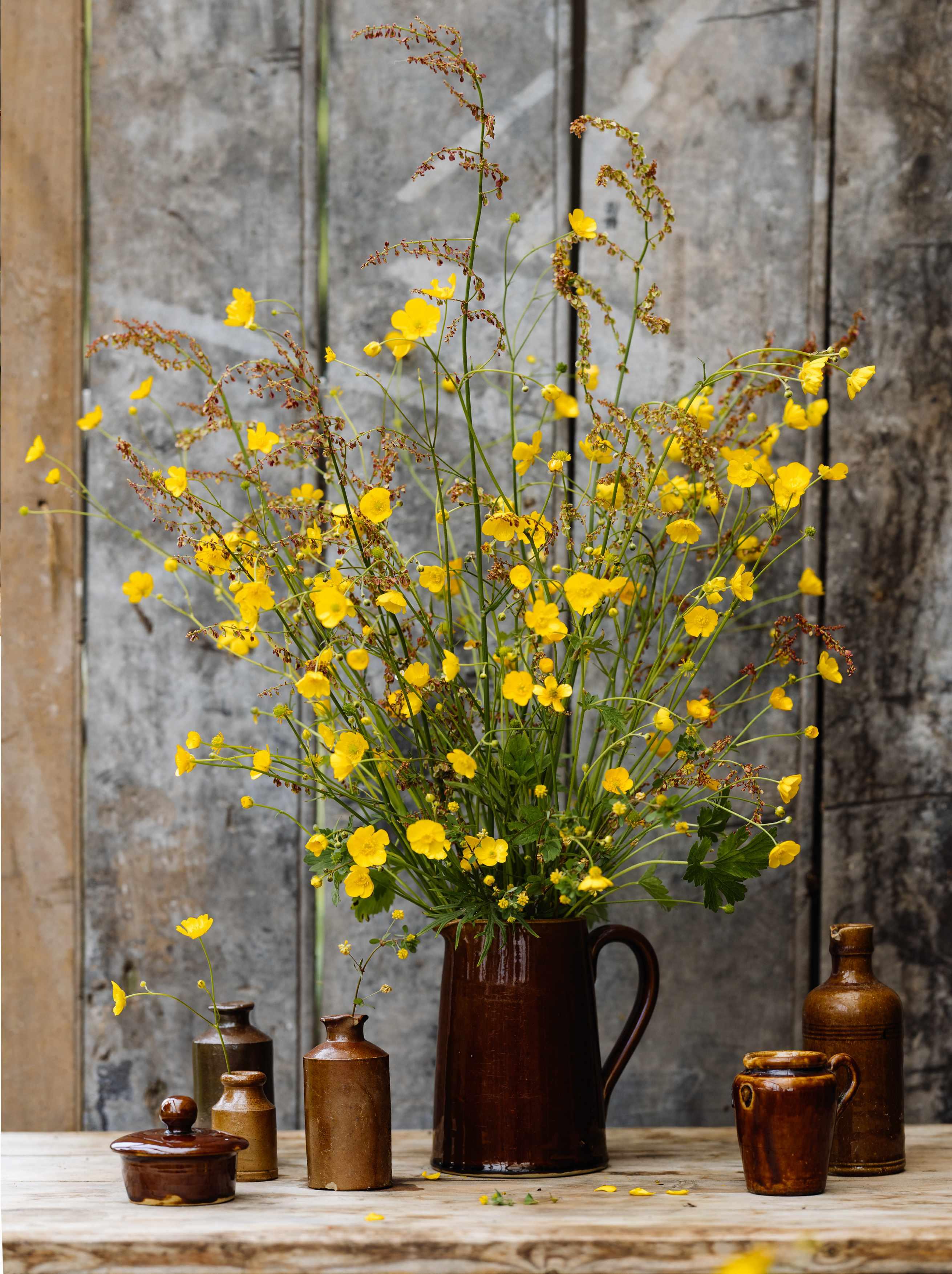
The Walled Garden at Knepp Castle in West Sussex, reimagined to a plan by Tom Stuart-Smith, is transforming how we think about gardening
 WORDS JODIE JONES PHOTOGRAPHS RICHARD BLOOM
WORDS JODIE JONES PHOTOGRAPHS RICHARD BLOOM
What Private walled garden, open for pre-booked guided tours. Where West Sussex. Size Just over an acre. Soil Highly manipulated combination of existing topsoil, sand and crushed aggregates. Climate Temperate. Hardiness zone USDA 9.
Four years ago, Isabella Tree and Charlie Burrell decided to dig up their croquet lawn and rewild their private garden in the same way that they had already rewilded their farm estate. They enlisted the help of designer Tom Stuart-Smith to develop a new style of ecological aesthetic and the result is this Rewilded Garden and the neighbouring Kitchen Garden.
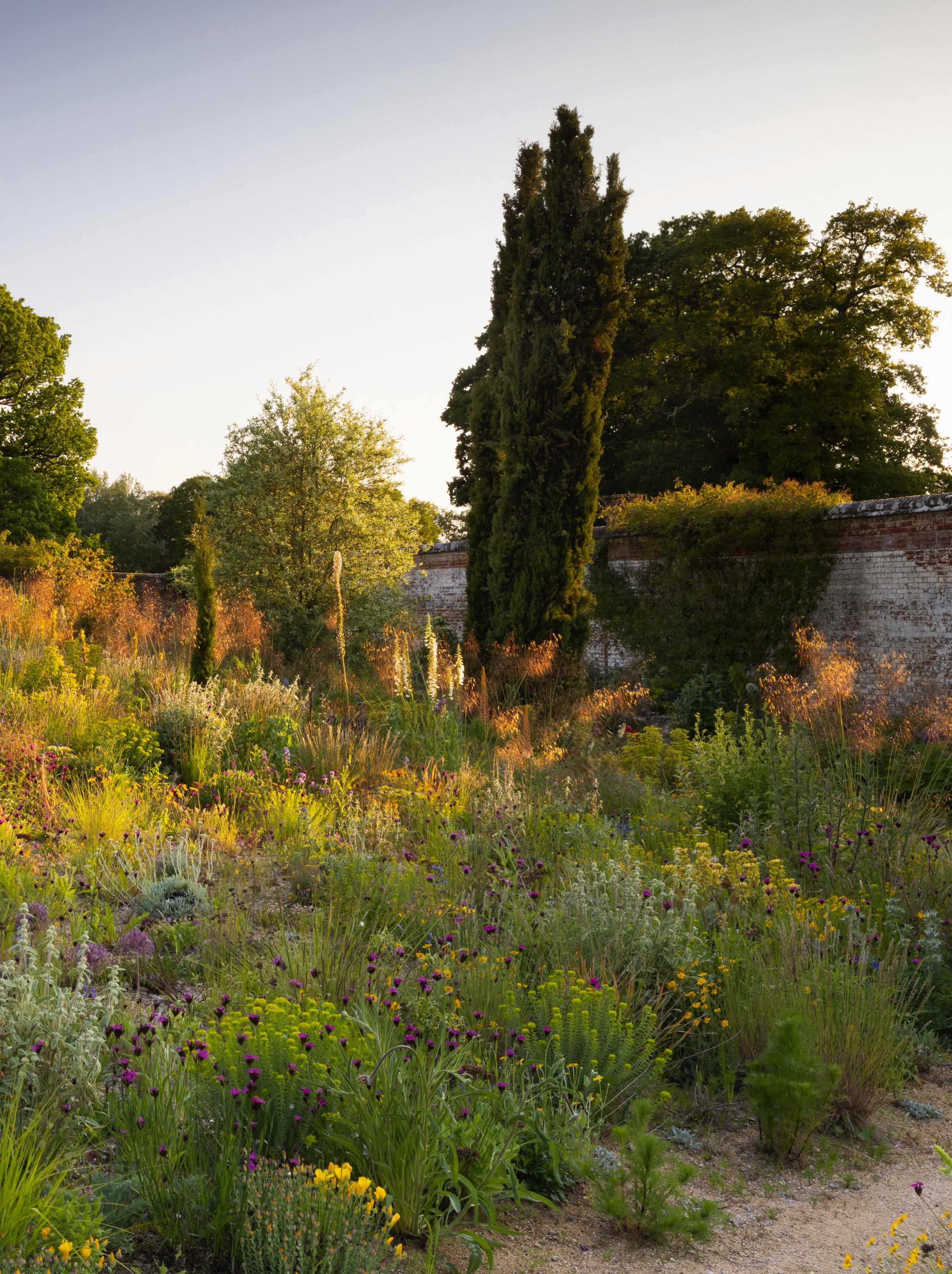
There is a whiff of existential angst blowing through the gardening world, highlighted by the heated debates that rage every time some iteration of a wild garden wins Gold at Chelsea. What plants should we be growing in our rapidly changing climate? And how can we balance the gardener’s urge to create a stimulating and beautiful space with our responsibilities to the planet, and all the creatures that share it with us?
Four years ago, proto-rewilders Isabella Tree and Charlie Burrell set out to find their own solution at Knepp, the 3,500-acre Sussex farm they famously withdrew from conventional land management more than 20 years ago. As the wider estate exploded with a sky-rocketing diversity of plants and wildlife, the couple gradually became aware that their private walled garden, which continued to be managed with traditional formality, was looking increasingly incongruous. So they approached Tom Stuart-Smith with a conundrum – how do you rewild a garden?
Set within 19th-century walls, the Knepp Castle garden had already been through a number of changes over the years, but when Tom and his team were called in they found a plot of just over an acre, divided by a wall, to create an ornamental kitchen

garden with raised beds and grass paths, and a simple swimming pool garden with a large croquet lawn. In comparison with the exuberance of the rewilded land, it was decidedly lacking in diversity.
Out in the wider estate, native plant communities had been allowed to regenerate the former farmland naturally over a period of years, with the help of keystone animal species including Tamworth pigs and Exmoor ponies, which roughed up the ground and munched back emerging scrub. Within the garden walls, a different approach was going to be required, since this ‘rewilded’ space had to be attractive to humans as well as producing congenial habitats for wildlife. Ironically, this called for careful planning, and the keystone species that Tom brought in to help effect the change were big beasts of the horticultural and ecological world – plant ecologists James Hitchmough and Mick Crawley, and organic herb expert Jekka McVicar.
Their collective goal was to increase biodiversity in all its forms – both flora and fauna – but to do this, they first needed to create a much wider range of habitats. In what is now the Rewilded Garden, the existing neat lawn and topsoil were scraped aside and mixed with varying quantities of sand and the crushed concrete and brick remains of an old farm building to produce a range of To continue turn to page 88
Above The existing swimming pool was retained in its original form in recognition of the fact that this is still a private family garden, which should meet the needs of its human occupants as well as a wider diversity of lifeforms.
Right above The tall, feathery grass Stipa gigantea creates an airy translucent frame for a complex multi-layered mix of planting, including Centaurea nigra Allium cristophii and Euphorbia seguieriana, in front of the garden’s old walls. These walls make an important contribution to the diversity of wildlife habitats on offer, with the loose lime mortar and ageing bricks protecting a range of invertebrates and small mammals.
Right Two Cupressus sempervirens ‘Stricta’, alongside a stone sculpture and the well-maintained gardener’s office, help to define this space as a garden, with an evolving community of plants that includes Papaver rhoeas, Iris pallida and Berkheya purpurea
How can we balance the gardener’s urge to create a beautiful space, with our responsibilities to the planet?
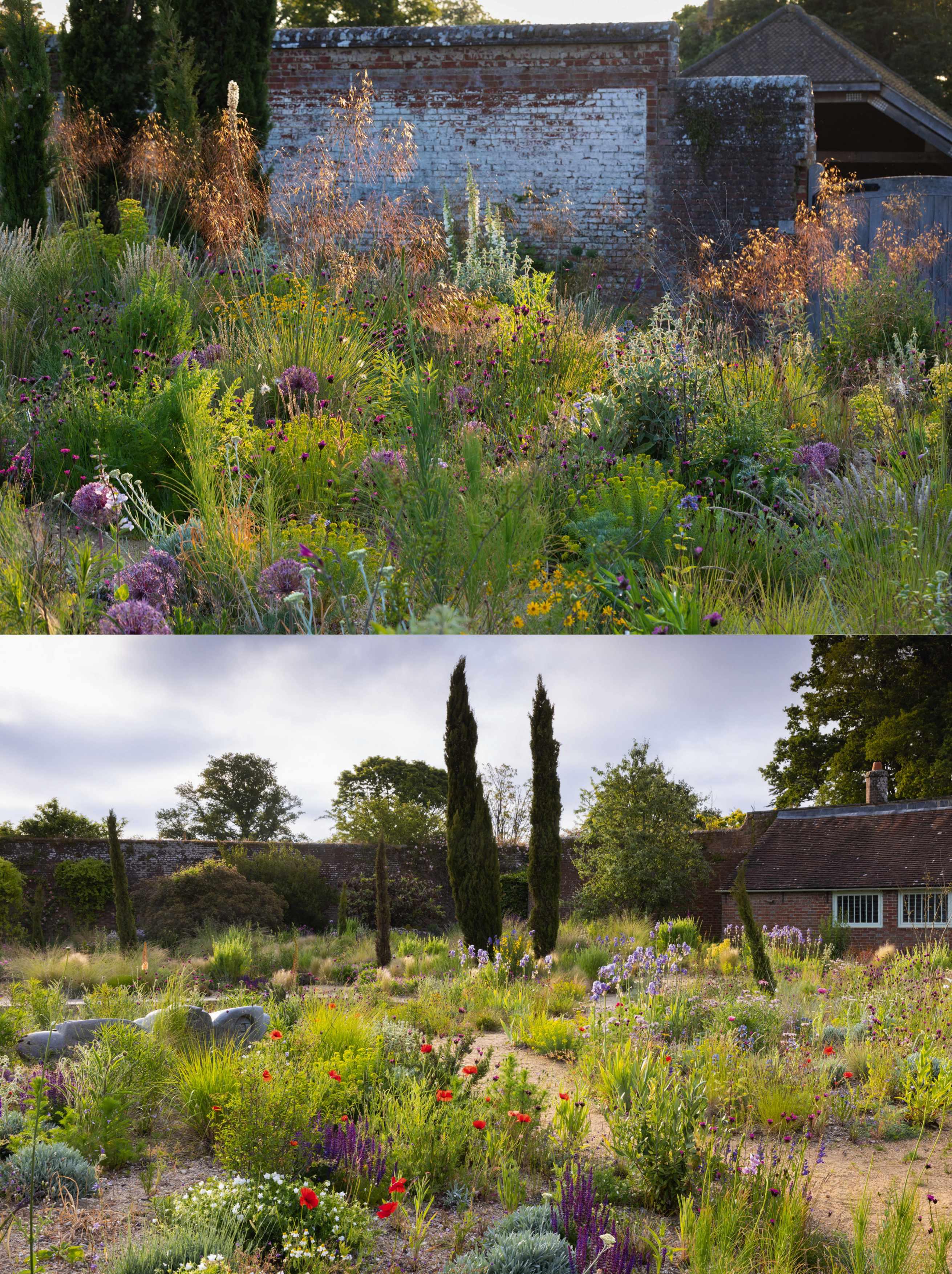
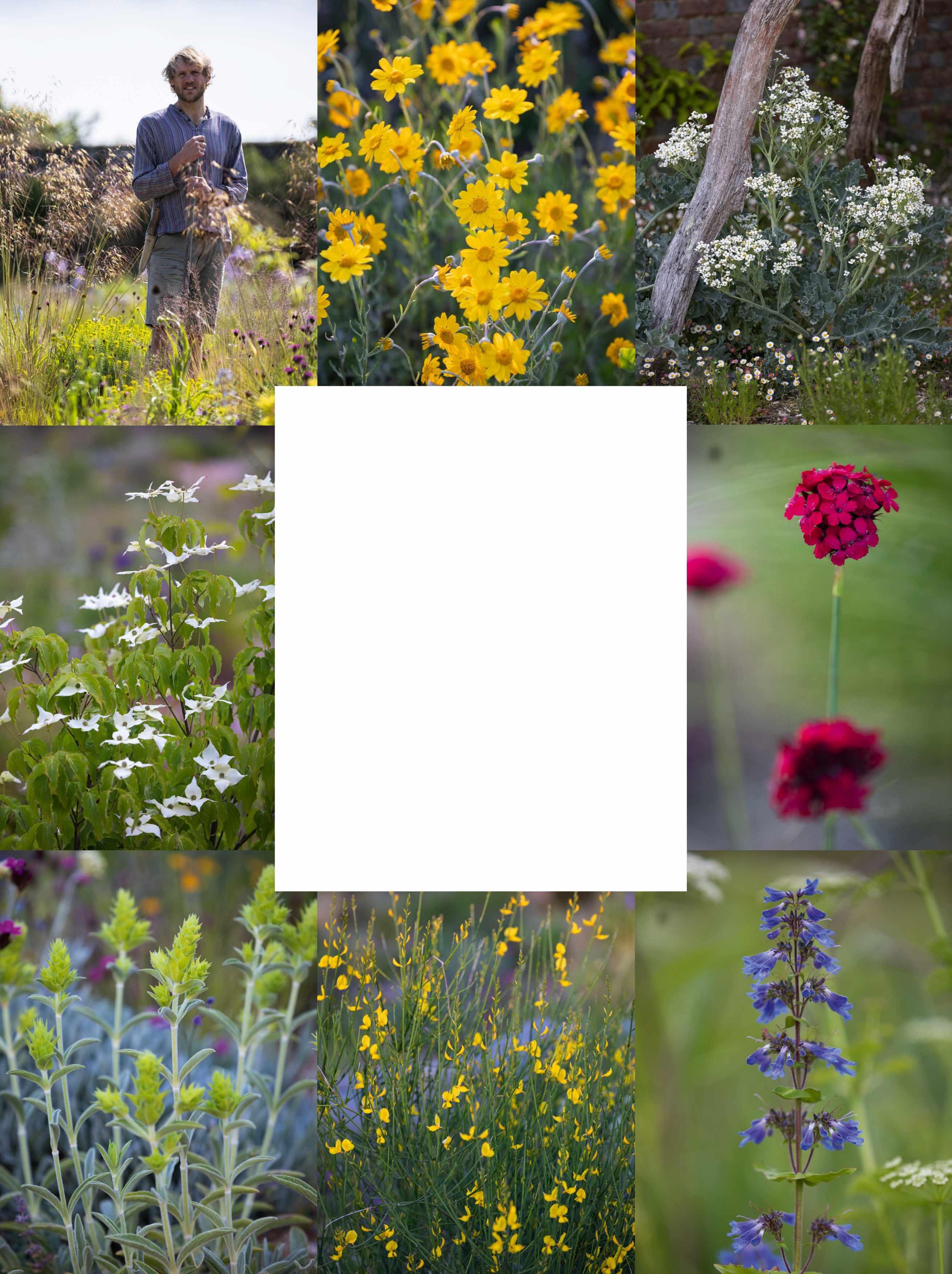
Charlie Harpur was a young landscape architect in Tom Stuart-Smith’s studio when the plans for Knepp were first being discussed, and he was so inspired by the concept that after completing the Kew diploma, he moved sideways to become head gardener and turn the design into a reality.
1 Eriophyllum lanatum The woolly sunflower is covered in nectar-rich yellow daisies from late spring to early summer, and its soft, grey foliage provides useful year-round groundcover. Height and spread: 30cm x 20cm. RHS H4†
2 Crambe maritima At Knepp, native species such as this sea kale are highly valued, and planted together with non-native plants. This drought-tolerant, coastal stalwart has crinkled, glaucous, blue-green foliage and produces racemes of small white flowers in early summer. 75cm x 60cm. RHS H7.
3 Cornus kousa var. chinensis The highly ornamental Chinese dogwood, with its showy bracts and strawberry-like fruits, is a key anchor plant within the more relaxed overall scheme. 8m x 8m. RHS H6, USDA 5a-8b.
4 Dianthus cruentus Along with vivid magenta Dianthus carthusianorum this pretty little alpine pink is scattered lightly throughout the drier sections of the Rewilded Garden. 60cm x 20cm. RHS H5.
5 Sideritis scardica An attractive, aromatic plant with woolly grey foliage and candle-shaped inflorescences. Widely grown in Greece as a medicinal tea, it will also thrive in free-draining conditions in this country. 40cm x 40cm. RHS H5.
6 Spartium junceum Spanish broom is carefully ranged across the driest ridges in the Rewilded Garden, where it forms shrubby clumps, sprinkled with fragrant pea-like flowers all through the summer. 2m x 2m. USDA 8a-10b.
7 Penstemon ovatus Penstemons, with their tubular flowers, are a valuable nectar source. James Hitchmough added seed of eight different forms to his planting plan, including this lovely true-blue form. 80cm x 40cm. USDA 4a-8b.
*Holds an Award of Garden Merit from the Royal Horticultural Society. †Hardiness ratings given where available.
Charlie is the first to acknowledge that the Rewilded Garden at Knepp needs to look as good as possible for as much of the year as possible.
“We’re trying to win hearts and minds here, so we have to make it appealing.
I’m a pretty orderly person myself, and I believe strongly in the value of framing the picture, especially when the overall impression is pretty relaxed.” His approach has been inspired by the ideas of Joan Nassauer, a professor of landscape architecture at the University of Michigan School for Environment and Sustainability, who coined the phrase ‘cues to care’ to sum up her landscape strategy of ‘messy ecosystems, orderly frames’. She argues that we have a cultural need to display care in our landscapes, and therefore using elements that are familiar and attractive can make us more receptive to unfamiliar aspects, which we might otherwise find unacceptable.
Simple strategies include mowing a neat strip around an unmown area, incorporating some familiar garden plants into innovative planting plans, and using sculpted plants and noticeably designed elements. Charlie recalls an early visitor to the Knepp Rewilded Garden who was clearly prepared to be unimpressed.“It turned out he thought we were going to tell him to stop gardening completely and just let it go literally wild. When he saw what the garden actually looked like, and that gardening was still required, he started to come around.”
Tom’s planting plans brought together a wide selection of robust species that offer attractive foraging and habitat opportunities for wildlife, including the feathery, white umbellifer Selinum wallichianum, deep-blue spires of Salvia x sylvestris ‘Blaukönigin’, the yellow daisies of Eriophyllum lanatum, and Euphorbia seguieriana
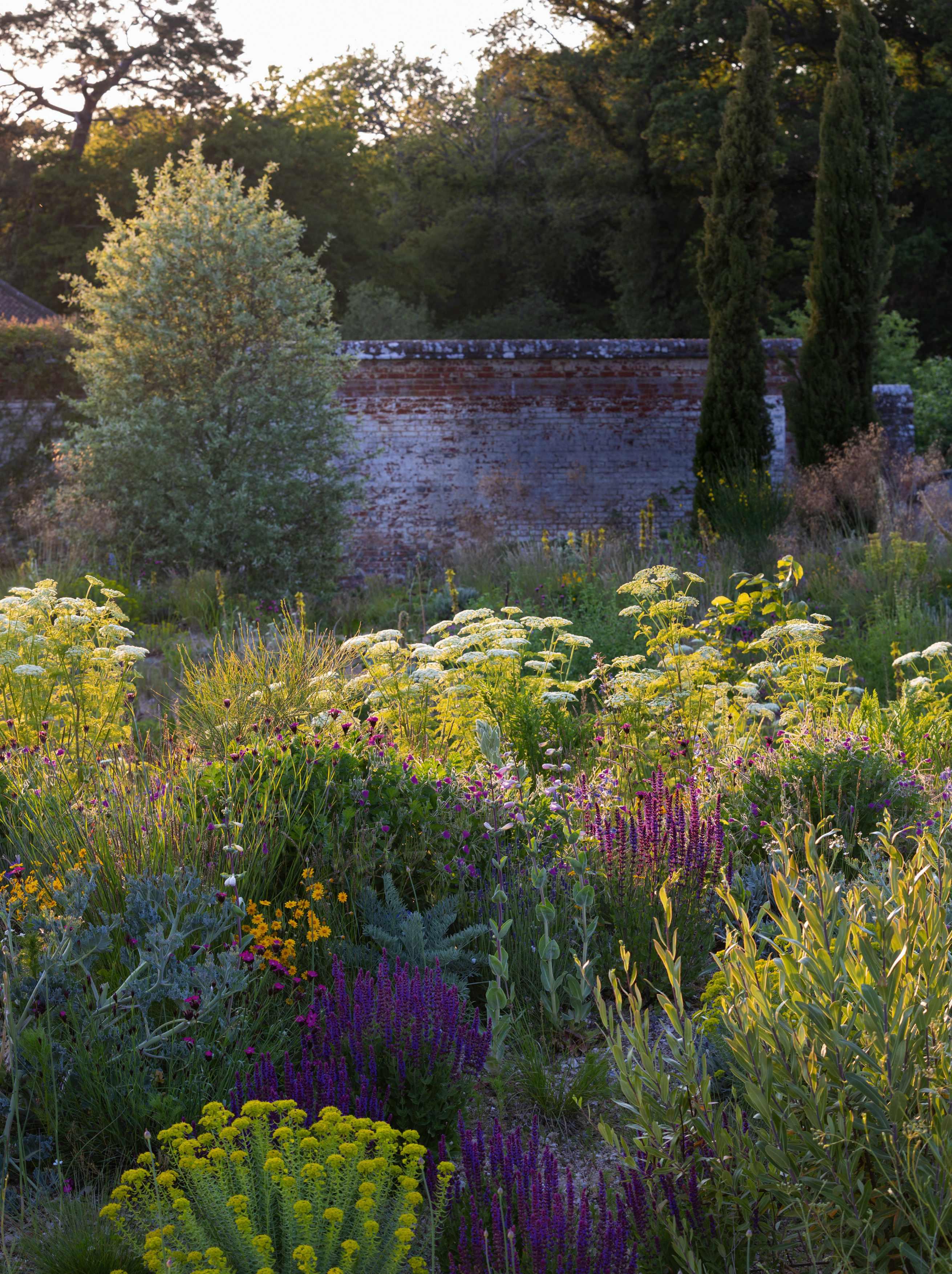
growing media with significantly varied pH, fertility and drainage levels. These were reintroduced to form an undulating series of mounds and troughs over which the surface height varies by up to 3m in places. Where once there was a croquet lawn, the ground is now fit only for the craziest of crazy golf.
There are areas of flat, exposed topsoil, dry peaks, damp troughs and sunny, south-facing slopes, each of which suits different plant communities. For the free-draining, lownutrient ridges, James designed an intricate plant matrix, made more complex with an over-seeded perennial mix, all anchored by a number of carefully positioned dominant species, including pencil cypresses, the grass Stipa gigantea and Spanish broom.
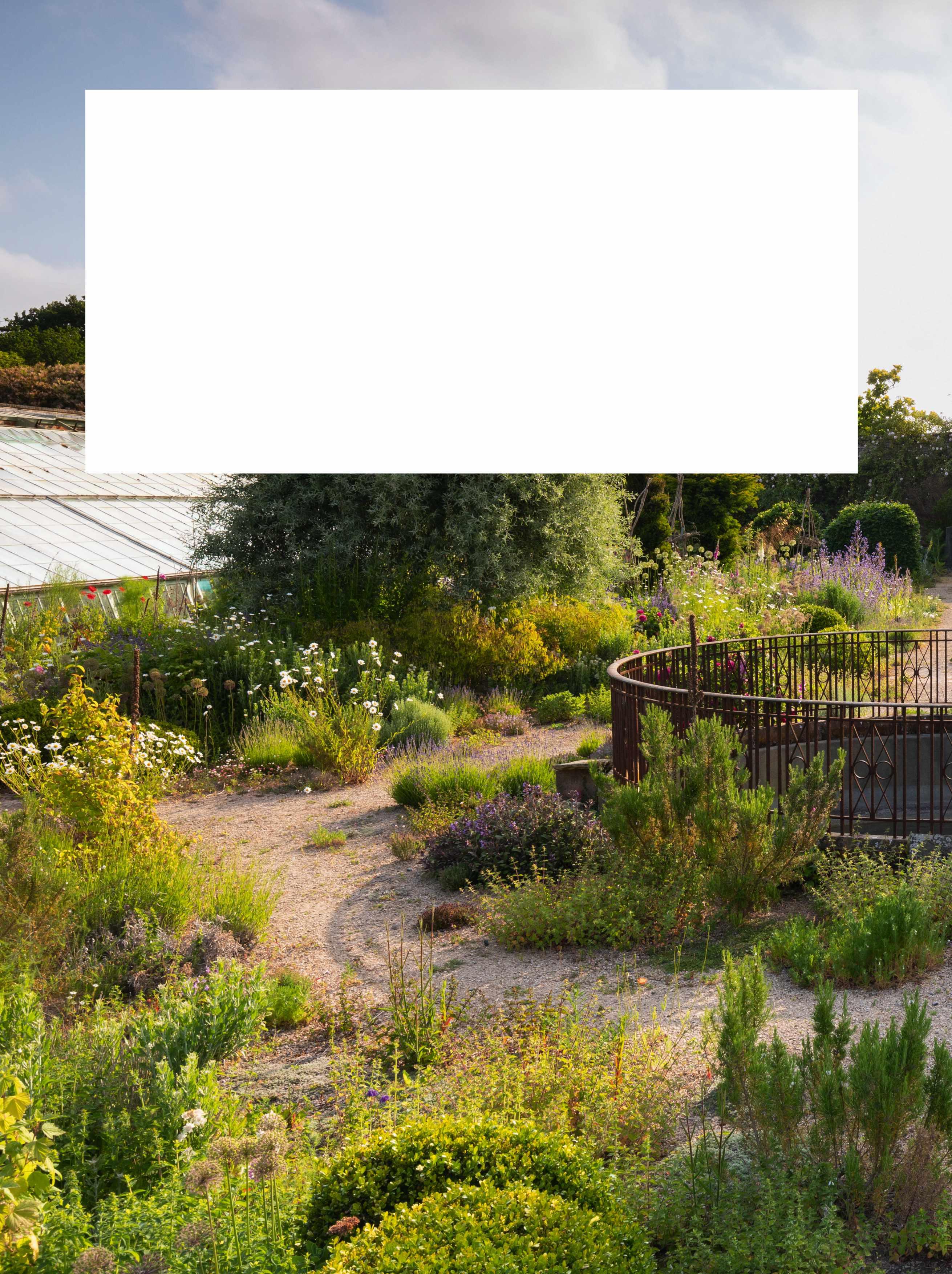
In place of a conventional planting plan, head gardener
Charlie Harpur and a team, including his job-sharing deputies Suzi Turner and Moy Fierheller, were presented with a spreadsheet of plants by quantity, and an instruction from James to simply distribute them evenly across the site. The resultant tapestry – including sea lavender, lady’s bedstraw
and toadflax, as well as Melica ciliata, Berkheya purpurea and Salvia x sylvestris ‘Blaukönigin’ – is startlingly good, with an impact that is far greater than the sum of its parts.
On the more gently undulating ground, Tom crafted an elegant and painterly combination that included Althaea cannabina, Seseli osseum, Poa labillardierei and Achillea ‘Coronation Gold’, all set out in his trademark drifts, with occasional outliers to keep it dynamic. Splashes of carmine Dianthus cruentus sprinkle a little fairy dust on top.
Multi-layered and structurally complex, the plant communities throughout the Rewilded Garden were all intended to develop in unpredictable ways, but they had a particularly challenging start in life. The first plants went into the ground in November 2021, with a second phase in April 2022. Since then, they have endured prolonged spells of drought, an extreme winter freeze and the wettest March for decades, yet there have been surprisingly few losses. A large Euphorbia x pasteurii, which seemed to have been killed off, was left standing for its sculptural impact and wildlife habitat

Changes have been more evolutionary than revolutionary –a loosening of corsets rather than a wardrobe changeThe Kitchen Garden retains its Victorian dipping pool (which is fed by rainwater run-off from the roofs of the castle) and the visible remains of the traditional raised beds, albeit now relaxed into a network of ‘dirty’ paths in which various herbs are encouraged to self-seed.
potential, but even this has recently begun to resprout from the base.
In the Kitchen Garden, the changes have been more evolutionary than revolutionary – a loosening of the corsets rather than an entire wardrobe change. The formal structure is still just about evident because, although the raised beds now blur seamlessly into ‘dirty’ paths, the historic richness of the cultivated soil means that any plant with its roots within a former bed grows twice the size of the same species in nearby compacted gravel. There is a riot of nepeta and roses, artichokes and alliums, with thymes and fennel already seeding into the gravel paths, but there are also recognisable vegetable beds, managed according to no-dig principles, but watered as required to maintain productivity. “These are gardens for people and produce as well as wildlife,” says Charlie.
There is little maintenance in the traditional sense. Instead, the team watch out for any emerging monocultures and gently rein them back in. “We are constantly considering the limits of acceptable change,” says Charlie. “There are no sterile hybrids. Everything has the potential to succeed. The extent to which one species is allowed to spread is an ongoing conversation.” There has also been debate about the diversity of plant ethnicities. On the charged issue of native versus non-native, Charlie attempts to steer a middle course. Hairy
bittercress, rosebay willowherb and other plants generally classified as weeds offer valuable habitat opportunities, so are tolerated but managed. Some standard ornamentals, such as the promiscuously self-seeding Smyrnium perfoliatum, are excluded for fear that they will jump the fence and disturb the delicate ecological balance of the wider estate. As part of the Knepp missionary zeal to spread the rewilding word, Charlie is creating a 188-square metre model garden that will showcase the most applicable and accessible plant combinations for a domestic garden, and conducts regular ‘safaris’ within the Rewilded Garden to explain what they are doing and why they’re doing it. “We are gardening hearts and minds as well,” he says. “This is all an experiment, so we are absolutely not telling anyone what to do, but we do want to encourage everyone to reconsider the limits of what might be possible within their own gardens.” ■
USEFUL INFORMATION
Address Knepp Castle Estate, West Grinstead, Horsham, West Sussex RH13 8LJ. Tel 01403 741235. Web knepp.co.uk
Discover Knepp for yourself – join our exclusive Gardens Illustrated reader day at Knepp Castle Walled Garden with Charlie Harpur and Tom Stuart-Smith. See page 92 for details.
Above The formal hedges, walltrained figs and mop-headed acacias that frame the path leading from the Rewilded Garden into the Kitchen Garden have relaxed into newly shaggy incarnations, complemented by huge spikes of Verbascum bombyciferum rising from the gravel.

Right above The once-neat pieces of yew topiary by the glasshouse in the Kitchen Garden were ‘goatpruned’ into eccentrically random forms by Tom, and the gravel paths have been allowed to go ‘dirty’ with encroaching self-seeded plants, blurring the boundaries of the beds. A tripod Bee Kind wild bee hive stands in the corner.
Right The Kitchen Garden presents a more accessible route to garden rewilding, as the soil is being slowly manipulated rather than radically reorganised, and many ornamental elements, such as Allium ‘Mont Blanc’ and Nepeta x faasenii, have been retained within the gently shifting plant community.

This is all an experiment. We want to encourage everyone to reconsider what might be possible
Join

The Walled Garden at Knepp Castle is a horticultural experiment, inspired by what owners Charlie Burrell and Isabella Tree learned from rewilding in the wider landscape of the Knepp Estate. The project was masterminded by experts including Tom Stuart-Smith, James Hitchmough and Jekka McVicar, and the aim is to maximise biodiversity, while at the same time being as sustainable as possible (see page 82 to learn more).
Our exclusive reader day is a unique opportunity to visit this extraordinary garden in the company of its designer and head gardener. In the morning, we will learn all about the garden transformation and the Knepp ethos, and get a first look at the Walled Garden.
Our group will be guided through Knepp’s gardens, meadows and orchards by an ecologist, looking at emerging habitats and wildlife in the garden, and identifying important species both above and below ground. There is also the option to visit the market garden, which supplies the new café and farm shop on site.
In the afternoon, we will be joined by Tom Stuart-Smith for a guided tour of the Rewilded Garden and the Kitchen Garden, and the day will end with a Q&A session with Tom and Charlie.
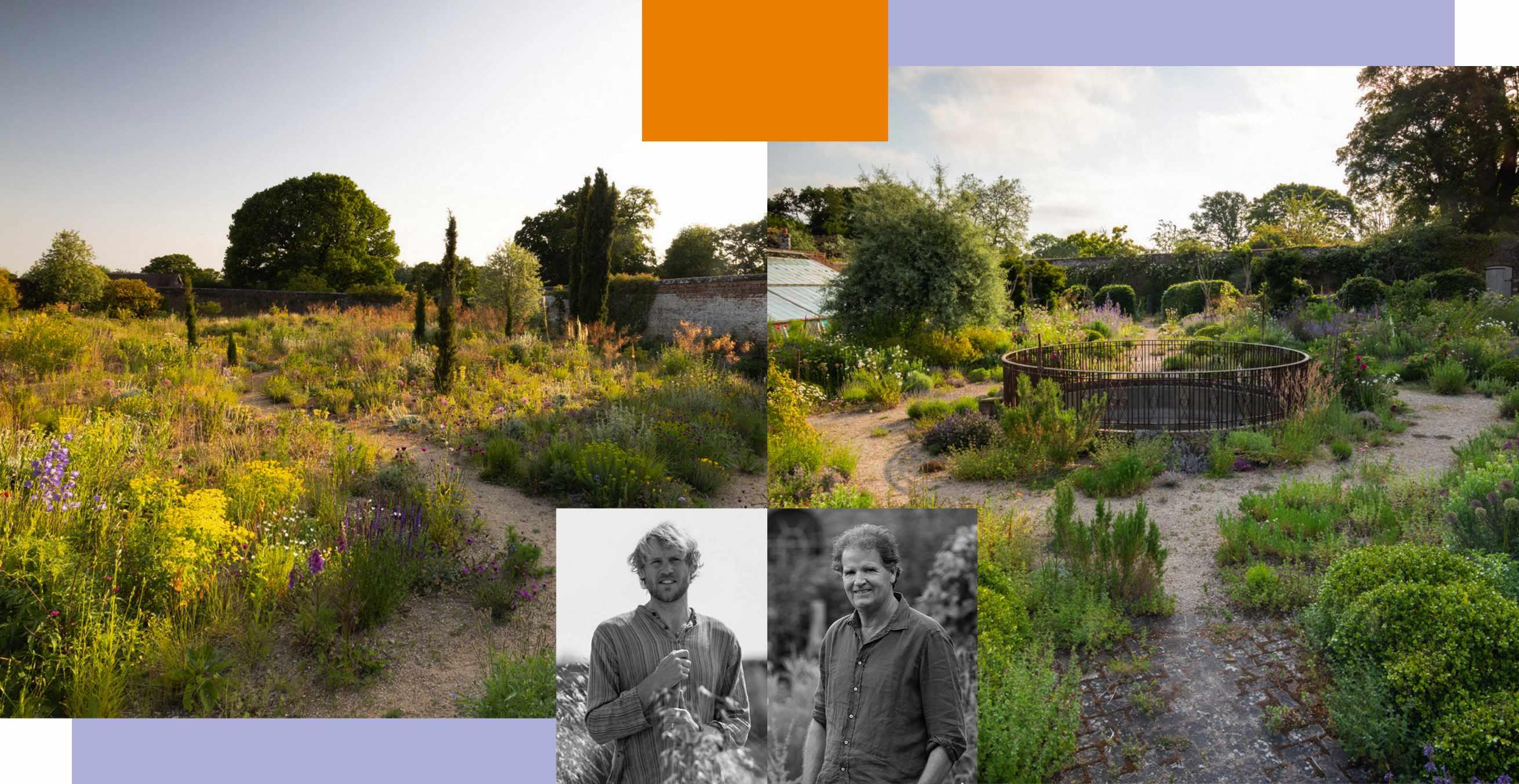
Price: £160 per person, including lunch and refreshments
Programme
10am Arrival; coffee and tea
10.30am Welcome and introduction to Knepp
11.15am Tour of gardens, orchards and meadows with the Knepp ecologist
12pm Time to explore, and visit the market garden
1pm Lunch
2pm Guided tour of the Walled Garden
3pm Refreshments
3.15pm Q&A with Tom and Charlie
4pm Depart
A small pocket park that sits in the intersection of several lanes of traffic in Boston, Massachusetts, has won the Award of Excellence in the Built – Small Design category at this year’s World Landscape Architecture Awards for an entry entitled ‘This was Once a Pond’. Designed by ASK+ with Baltimore-based Unknown Studio, the North Meadow project on The Rose Kennedy Greenway is both a response to the local community’s desire for a calm, biodiverse, green space in the heart of the city, and a reflection of the site’s history. At one time, it was open water and mudflat within the Charles River estuary, and the design

abstracts the historic water’s edge into a place of tranquillity, with a boomerang-shaped boardwalk leading through soft planting. The interior of the park is bounded by a sawtooth wall, made from granite reclaimed from 19th-century seawalls that were unearthed during a major construction project to tunnel an interstate highway. Planters contain hardy native trees, including Nyssa sylvatica Sassafras albidum and Quercus bicolor, and an understorey of shrubs, grasses, perennials and native meadow plants, all of which were chosen with tough urban conditions in mind. askdesignbuild.com; unknownstudio.la


The gardens in this tree-lined neighbourhood in suburban Los Gatos, California, are neat parcels of rectangular lawn – which are not, of course, suited to the dry climate. The owners of this ‘L-eichler’ (as in a ‘like an Eichler’) house – a mid-century modern home with an atrium in the centre – had a different look in mind when they approached landscape studio Terremoto. They wanted to rip out the tired hedges, rotting deck, old-fashioned fencing and lawn at the front and back to create spaces that were packed with plants for pollinators, where their two young daughters could roam. Aside from that, spaces for cooking and entertaining were a key requirement.“That was a really big part of the brief,” explains landscape architect Sarah Samynathan, who worked on the project with her colleague Alain Peauroi.“The clients were in the tech and health worlds when we started work on the garden in 2019, but they’ve just opened a wine bar and restaurant in San Jose.”

“When you’re confronted with the strong lines of mid-century architecture, you can either go with the mid-century modern style of landscape architecture – which is not much – or you can juxtapose it with an intense softness,” says Sarah. She presented the clients with two options, driven by materials. The first was a wood-based design and the second used reclaimed granite slabs. The two options also came with two different planting palettes.“The first option was paired with meadow planting and the second with structural planting, with lots of succulents and cacti.”
The materials ended up as a blend of both.“The areas that you move through have granite pavers and the areas you linger on are wood. All of the structures, including the angled deck in the atrium and the pergola, have a bit of an edge to them.”And the agreed planting was soft meadow.
“Most people with children think they need a lawn. The clients understood that not having a lawn still allows for curiosity, exploration and creativity. When I visited, the girls were cutting the flowers off with scissors and drawing them. It was really good to see them enjoying, and connecting with, the garden in that way.”
Turn the page for Terremoto’s
In a California suburb where neat squares of lawn are the norm, landscape studio Terremoto has created something different
WORDS VERONICA PEERLESS PHOTOGRAPHS CAITLIN ATKINSONLeft The clients eschewed lawns in the front and back gardens in favour of meadowy spaces where their young daughters could immerse themselves in nature. In the front garden (left), a staggered path of reclaimed granite slabs weaves through the tall, meadow-style planting, towards the front door and the atrium. It is flanked by two pin oaks (Quercus palustris).
1 Outdoor kitchen
2 Pergola
3 Reclaimed granite path
4 Firepit
5 Meadow planting
6 Deck
7 Atrium

The fences around the sides and back of the garden are cedar, to match the cladding of the outdoor kitchen, the pergola and the decking. “In one corner, there is an ugly utility pole,” explains Sarah. “No matter what we did, this pole was going to be there. We couldn’t hide it, so we decided to do something different and accentuate it. The fence is pretty simple everywhere else so it’s nice to have this more graphic moment. It ties in with the idea of bringing angles to the structures in the garden.”
The firepit is the second ‘destination’ in the back garden, opposite the pergola and outdoor kitchen. It is a little tucked away, accessed via a meandering path. It is concrete and was made by the contractor. The exterior was sandblasted to soften its look. “The clients wanted something really simple,” explains Sarah. “We went with the circular shape because with flexible furniture such as chairs, it’s easier to manoeuvre yourself closer or further from the fire.”
The path in the front garden leads in to the shady atrium, flanked by windows on two sides, and the front door. The atrium houses an angled cedar deck: “It’s not a space for hanging out in, but you could take a call or have a drink there,” says Sarah. A hole in the deck has been cut for a single Acer palmatum ‘Sango-kaku’. Sarah raised the decking to windowsill height to improve circulation and frame the lush fern planting. The view from the house is of vibrant green planting.
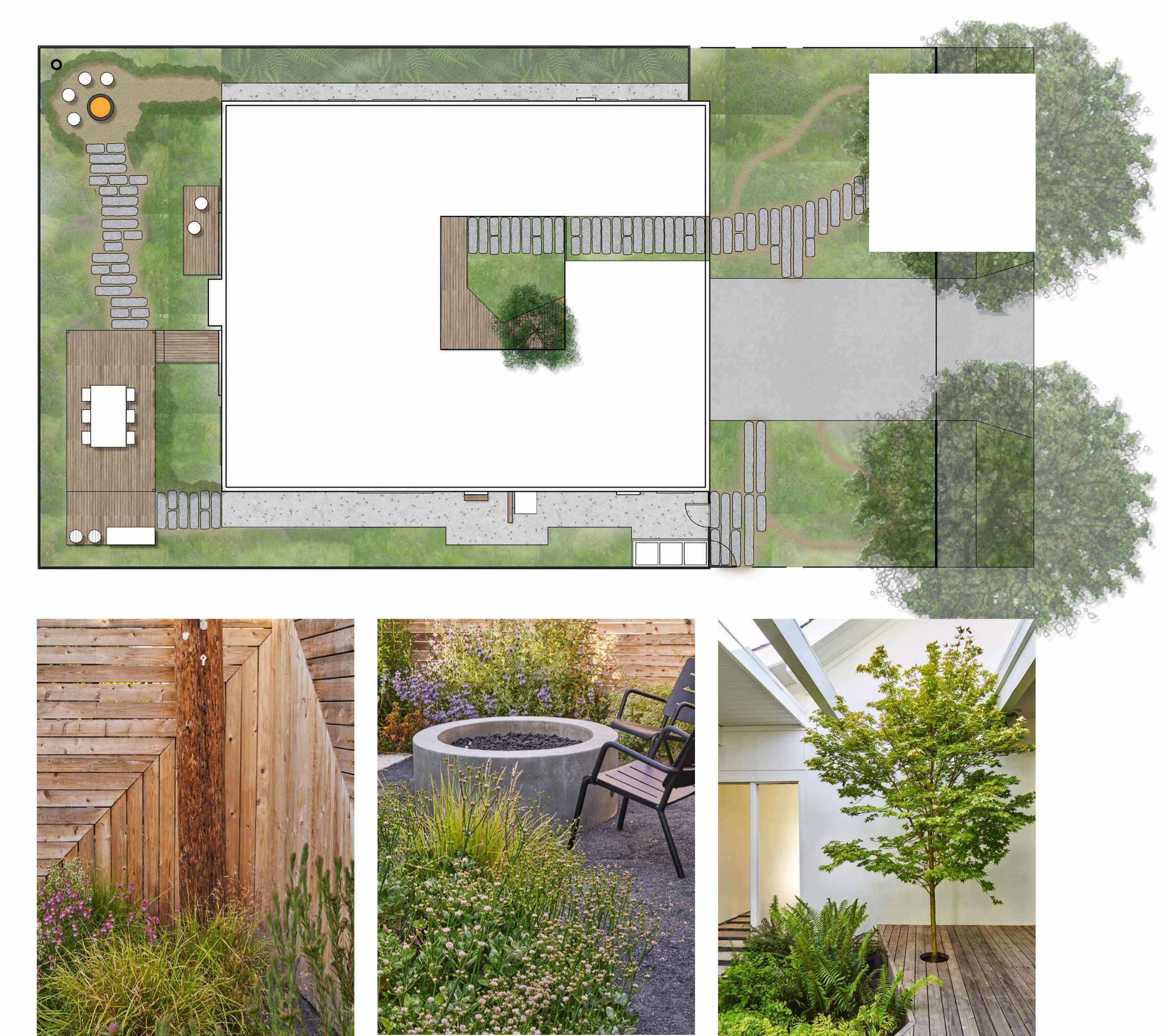
The goal for the clients’ daughters to be able to roam in the garden ended up driving the entire design. “It didn’t make sense to make it difficult to get to the dining deck or the outdoor kitchen, so the paths are more linear. But we’ve left organic openings among the planting,” explains Sarah.
To this end, the paths of granite pavers are staggered. “By shifting the paths a little bit, you give the plants room to grow into them so that you can weave around them. If all the walkways were orthogonal, you would be able to see everything from every point, and in a small garden, it’s important to avoid that. The plants in the meadow started out really small. I wasn’t sure it would actually
grow in the way it did, but some of those plants are now as tall as me. As you’re walking through it, you are moving the bog sages out of the way; it’s overgrown. It gives the experience of discovery – of meandering and finding things,” she says.
“We used black basalt fines between the pavers and as the mulch material across the planting as well, so it all blends together. We left little voids in the planting as trails so that the girls could wander through the plants. There is no definitive edge to the paths, which encourages exploration.”
A garden doesn’t just have to be for kicking a ball around, Sarah adds. “Kids use their imagination – they’re creative in how they play and they work with what they’re given. Having little trails through the tall plants encourages that same playful energy.”
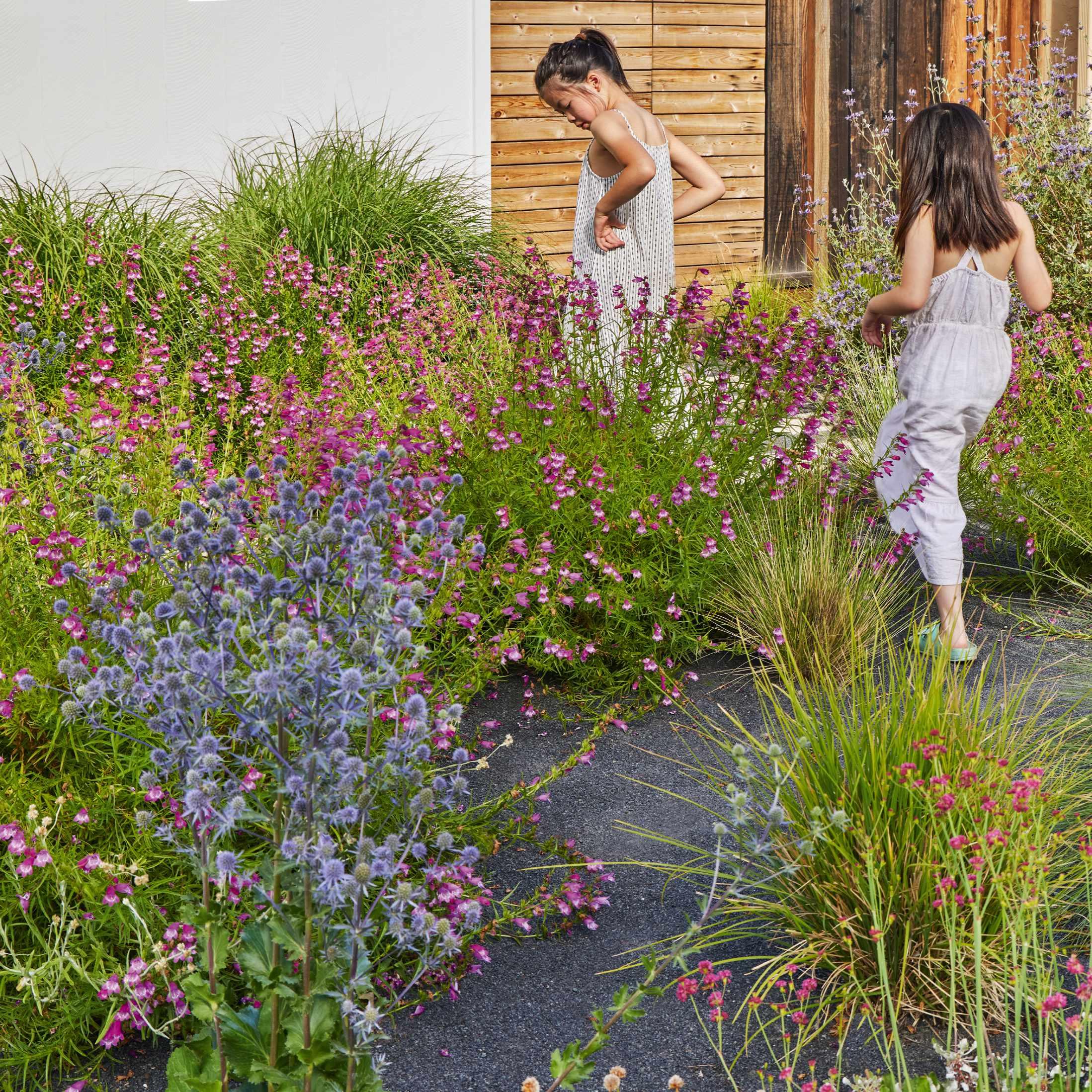
The outdoor kitchen is home to a barbecue, a fridge, a burner and a sink. “The clients needed to be able to use a wok – we measured it to get the sizing right – and wanted the burner to be sunken so that it is out of the wind,” explains Sarah. The contractor made the kitchen by constructing a fibreglass box with cutouts for each of the appliances, and clad the whole thing with cedar (the grill has an insulated jacket as cedar is, of course, a combustible material). The access doors beneath the grill and the sink have magnetic pushes so that there is no hardware on the outside, giving a sleeker look. The cedar is topped with a simple, grey, engineered-stone countertop. “We do a lot of
outdoor kitchens, but we still struggle with them,” admits Sarah. “They are always super shiny. But this kitchen is actually one of my favourite elements in the garden.”
The hard lines of the pergola echo the structure of the house and its roofline. The steel frame is painted black, and the cladding is cedar, which is also used widely around the garden.“We went through various iterations in terms of the cladding on the far side, to enclose it a bit more,” says Sarah.“In the end it didn’t make sense to do that, partly due to cost. It would also have felt more like a room, rather than being part of the garden.” Integrated lighting means that the family can use the area after dark.

“We offered the clients two planting options for the meadow,” says Sarah.“One was a classic ‘Terremoto’ textural meadow, which is mostly grasses with a few floral elements. The other was a colourful, floral garden with soft perennials and grasses, which is what the clients chose.”
The planting includes Achillea millefolium, Monarda ‘Purple Rooster’, Monardella villosa and Salvia clevelandii, woven together with grasses such as Miscanthus sinensis ‘Adagio’, Festuca mairei and Sesleria autumnalis.“The stars are the bright-pink Penstemon x mexicali ‘Red Rocks’ and the light-blue Salvia uliginosa. Pollinators love it and it adds a dynamic element to the planting – it moves in

the breeze. I threw in Eryngium planum ‘Blue Glitter’, not thinking much about it, but I love the texture and the dusty blue colour. In the back yard around the pergola, we added some Australian plants, such as Leucadendron ‘Jubilee Crown’ and Grevillea ‘Moonlight’, to add height and soften the fence.”The colour palette is mostly pink, purple, blue and white, with pops of orange and red from Diplacus aurantiacus.“A colleague calls this colour scheme ‘California romantic’. It’s what makes this project really special.”
At the front, the sharp seedpods of two existing sweetgum trees were popping car tyres, so were replaced with Quercus palustris ■
USEFUL INFORMATION
Find out more about Terremoto’s work at terremoto.la
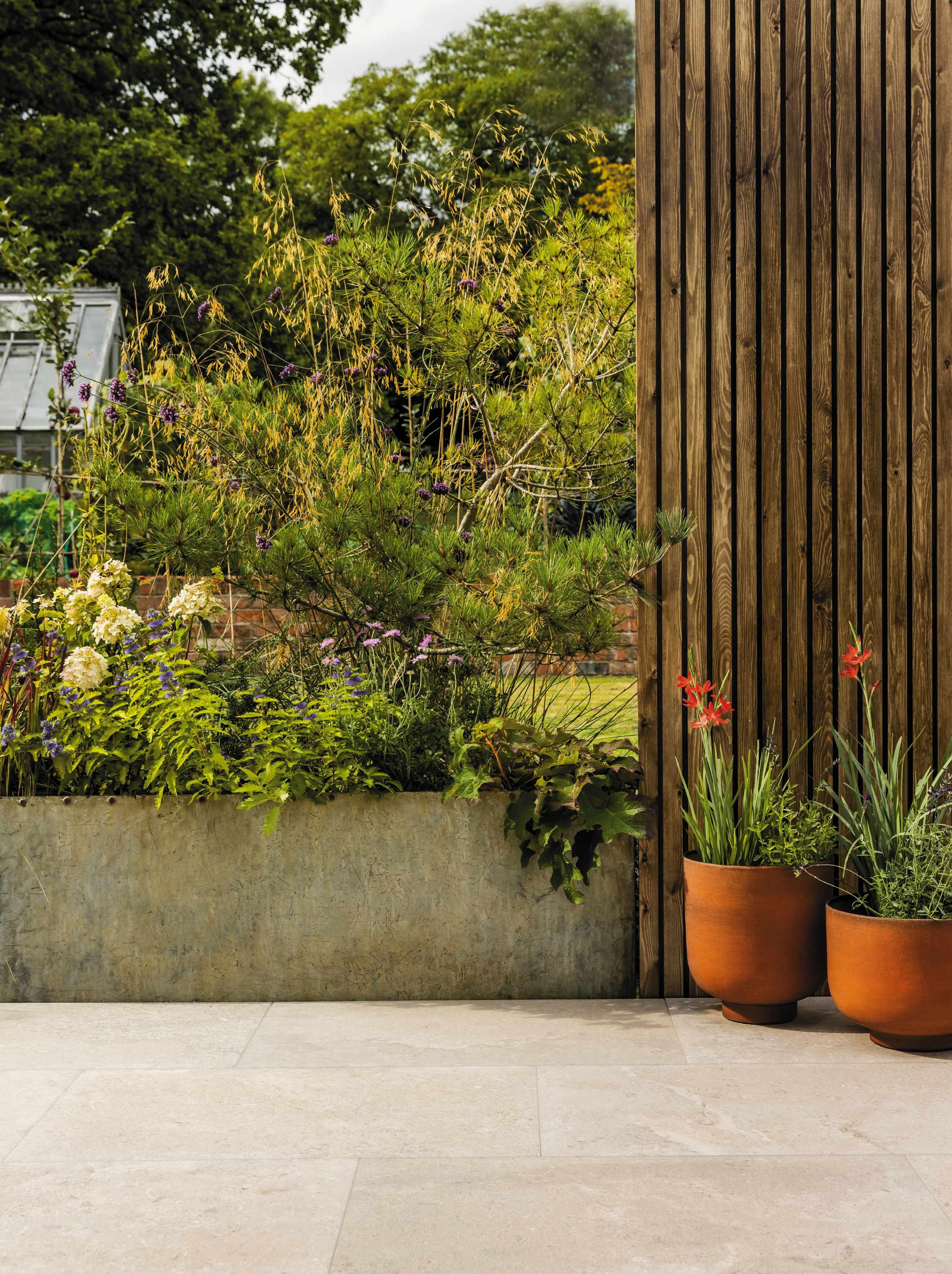
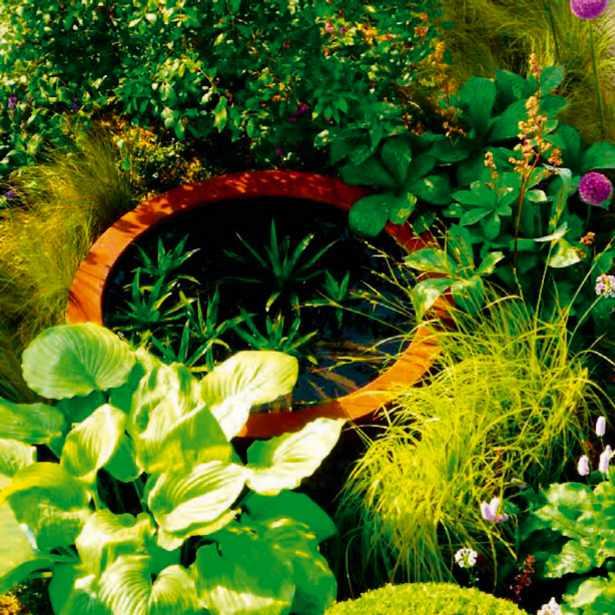
COMPILED BY NIKI GOSS
FIBREGLASS
Container Pond Kit, gloss granite finish, 80cm, £330, Waterside Nursery, 07931 557082, watersidenursery.co.uk
SIMPLE SET UP
Pond-In-A-Trough Zinc Planter, black, £119.99, Primrose, primrose.co.uk

URBAN SLEEK
Camellia Water Bowl, concrete grey £996, Urbis, urbisdesign.co.uk
RAIN AWAY
60cm Dipping Tank, £350, The Dipping Tank Company, 01223 502426, thedippingtankcompany.co.uk
CLASSICAL
Corinthian Graphite Style Instant Plant Pond Bowl, £59.99, Marshalls Garden, 01480 774555, marshallsgarden.com
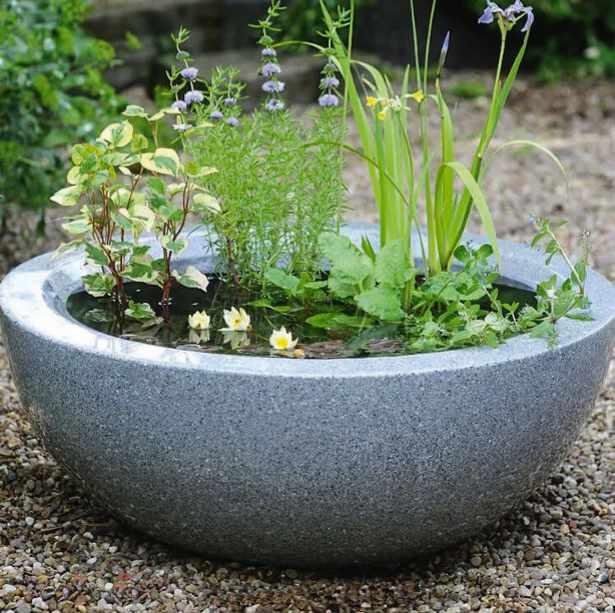
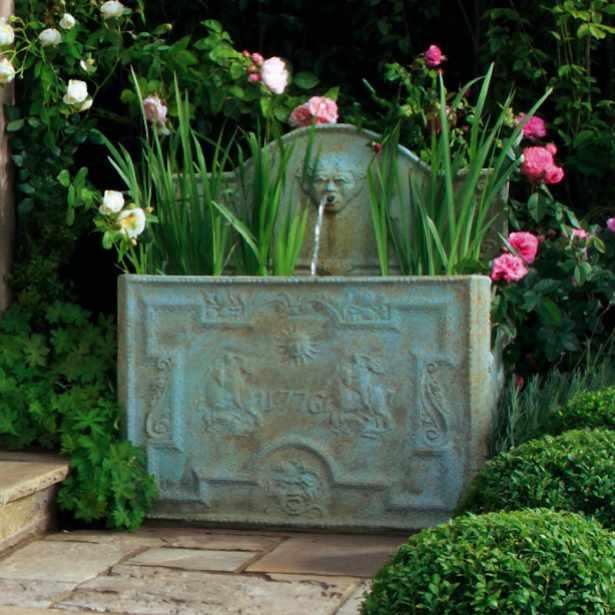
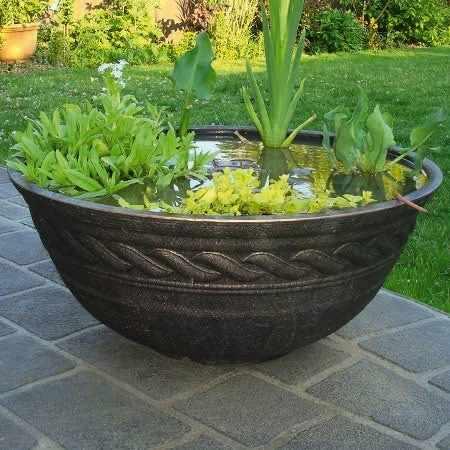
TRANQUIL
Adezz Corten Steel Pond, from £1,370, Urban Grow, 01423 618040, urbangrow.co.uk
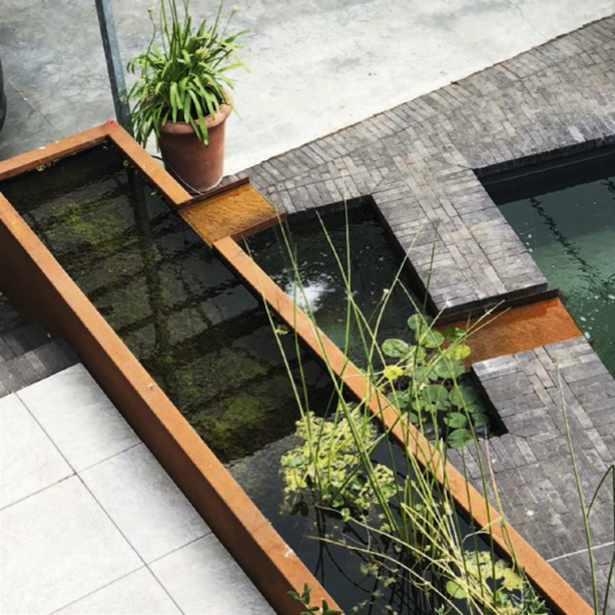

Discover a wider range of container ponds by scanning this QR code with your phone camera, or visit gardensillustrated. com/ponds

DURABLE
Corten Steel Circular Pond, from £595, Parker & Coop, 01932 850140, parkerandcoop.com
ANTIQUE STYLE
George & Dragon Water Tank, from £587, The Worm That Turned, 0345 605 2505, worm.co.uk
MOVEMENT
Granite Babbling Bowl, £625, Water Features, 0161 375 1235, waterfeatures2go.co.uk

Are you looking to change career, gain accreditation or simply learn more about your passion? Choose the best option for you from this selection of full-time, part-time and short courses.
The English Gardening School stands as a long time leader in horticultural education. With a legacy spanning 40 years this institution continues to inspire and educate those in the pursuit of gardening and design excellence. Graduates include many leading gardening personalities, garden designers and gardeners.
Our diploma courses based at The Chelsea Physic Garden teach students the fundamentals of horticulture through handson training and theoretical knowledge, guided by tutors at the foremost of their profession. Practical days studying in well known gardens
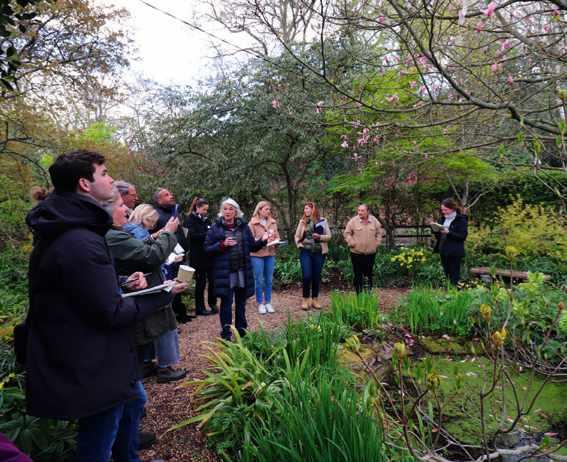
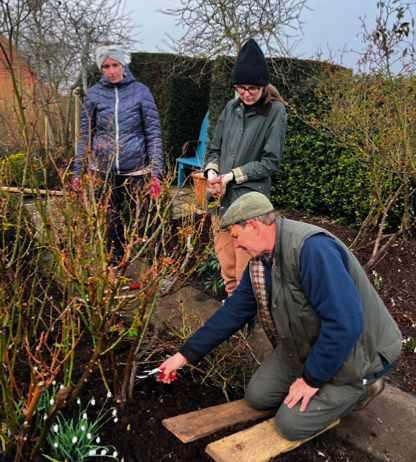
including our founder Rosemary Alexander’s allows students to apply their knowledge and gain gardening confidence.
Short courses and workshops are for people looking to refine their skills and target specific areas. Distance learning courses allow students to study at home in the own time.
If you are an aspiring gardener looking to embark on a new journey or an experienced enthusiast seeking to refine your skills, a course at The English Gardening School will deepen your plant knowledge and give you confidence in this complex profession.
‘The course has been fantastic. You have opened my eyes to a whole new world. I have learned so much and you have truly inspired me’
‘I can design a garden! What good fun and great company from day one, a real joy’

‘The sense of accomplishment from where we all started and what the class achieved together was very rewarding’
‘I feel incredibly lucky to have picked The English Gardening School as my proper introduction into gardening. I couldn’t have chosen a better course’
www.englishgardeningschool.co.uk
info@englishgardeningschool.co.uk @theenglishgardeningschool 01730 818373

Learning with Experts’ students love being able to learn directly from world-class horticulturists and garden designers on-demand and from wherever they are in the world. With more than 40 gardening courses to choose from, there’s a gardening course for every gardener from beginners to professionals.
Here’s just a few of the Learning with Experts tutors you could learn new gardening skills from:
World-famous garden designer and plantsman, Piet Oudolf is famous for his planting design for New York’s High Line and leading the New Perennial design movement. Piet’s courses cover his planting philosophy and how to design a garden to work in all seasons – look out for the Piet Oudolf Gardens collection of courses.
Expert horticulturist and frequent
collaborator with Piet Oudolf, Noel has written over 25 books on horticulture and planting design. Noel teaches RHS Level 2: Principles of Plant Growth and Development, as well as co-tutoring Piet Oudolf courses, and teaches Propagation and Perennial Planting Design.
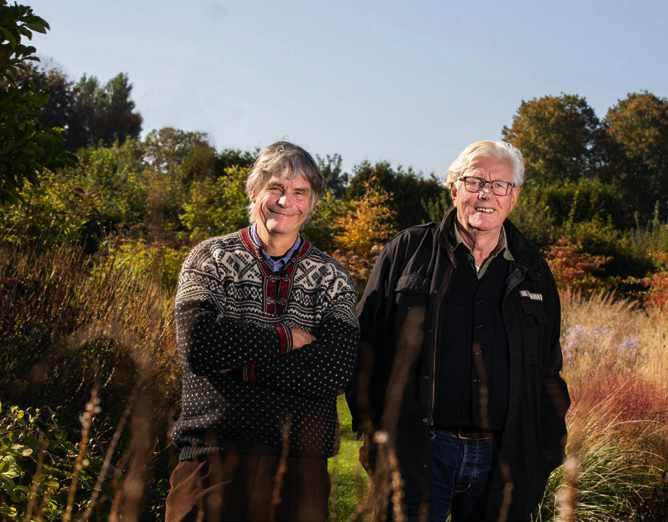
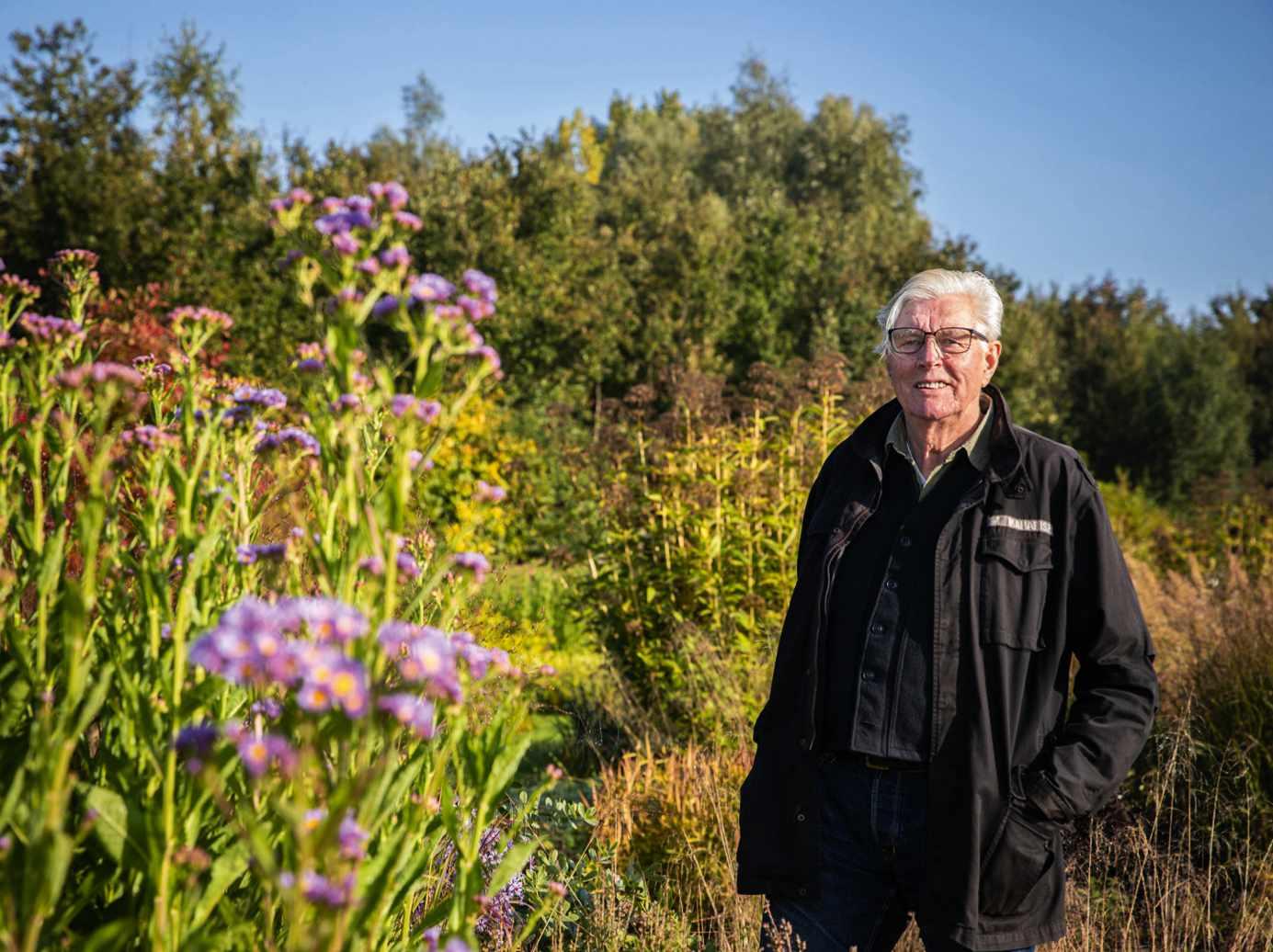
Chris Beardshaw won Gold at RHS Chelsea in 2022 and 2023, and teaches the Container Gardening course – perfect for gardeners just getting started or with smaller spaces, with projects ranging from choosing the right container to designing complex container gardens.
Sally is gardener and writer, with a focus on sustainable gardening. She started growing “just a few beans”, before becoming completely self-sufficient for vegetables, fruit and herbs as well as gardening professionally. Sally teaches the Self-Sufficient Veg Gardening course.
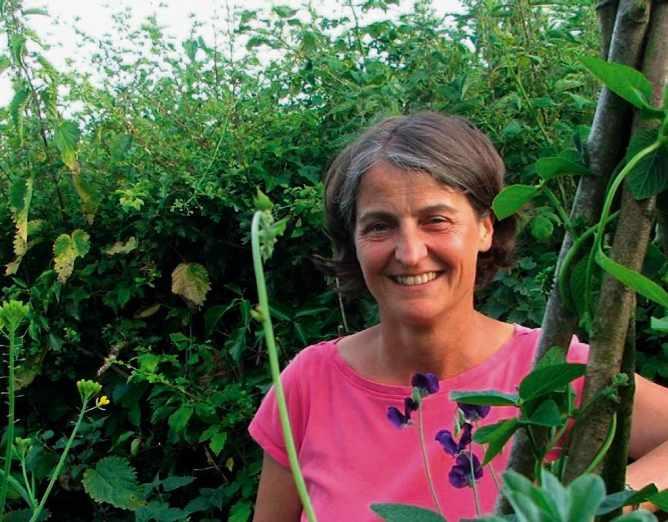
With more than 30 years experience in the horticultural world, over 70 RHS Chelsea Gold medals and many appearances on BBC Gardeners’ Question Time, Andy has seen most horticultural challenges in his career. Andy teaches five courses including Gardening for Wildlife, Trees, and Shrubs.


Sign up for a Learning with Experts course and use code GARDEN23 at the checkout for 20% off your next online gardening course (scan the code below).*

*Terms apply, cannot be used in conjunction with other offers and promotional codes. Not valid for use on the RHS Level 2 courses. Use by 31 July 2023.
learningwithexperts.com

Widely regarded as one of the world’s leading garden design colleges, the London College of Garden Design has a wide range of courses for those aiming to start a career in garden design and continuing professional development for experienced designers.
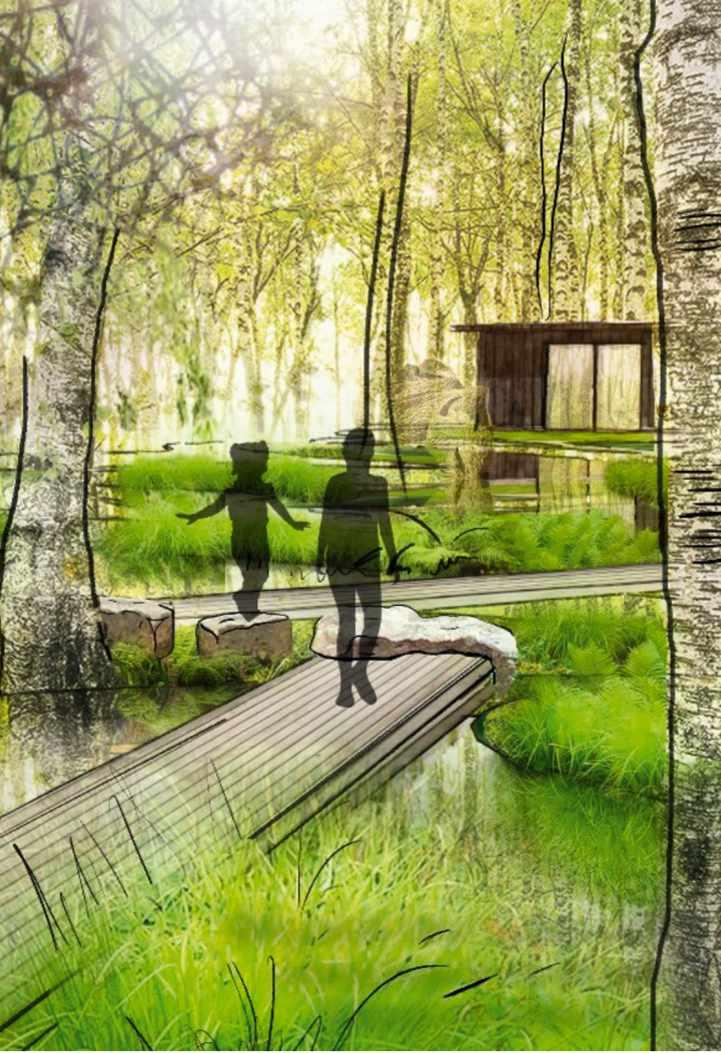

Our one-year Garden Design Diploma led by Andrew Wilson welcomes students both in-person at the Royal Botanic Gardens, Kew, and in real-time online classrooms. We offer an exciting and often demanding environment that teaches not just the fundamentals of design but also develops skills in planting and construction design and running your own successful garden design studio.
Every class is taught by expert tutors who are all practising professionals and we ensure that our students get the opportunity to take part in inspirational visits and free graduate seminars. And if you are in Australia or New Zealand you can join this course with our partner college in Melbourne.
Our students have won the majority of Society of Garden Designers Student Awards since they began and regularly graduate to work for some of the world’s leading designers and win major awards
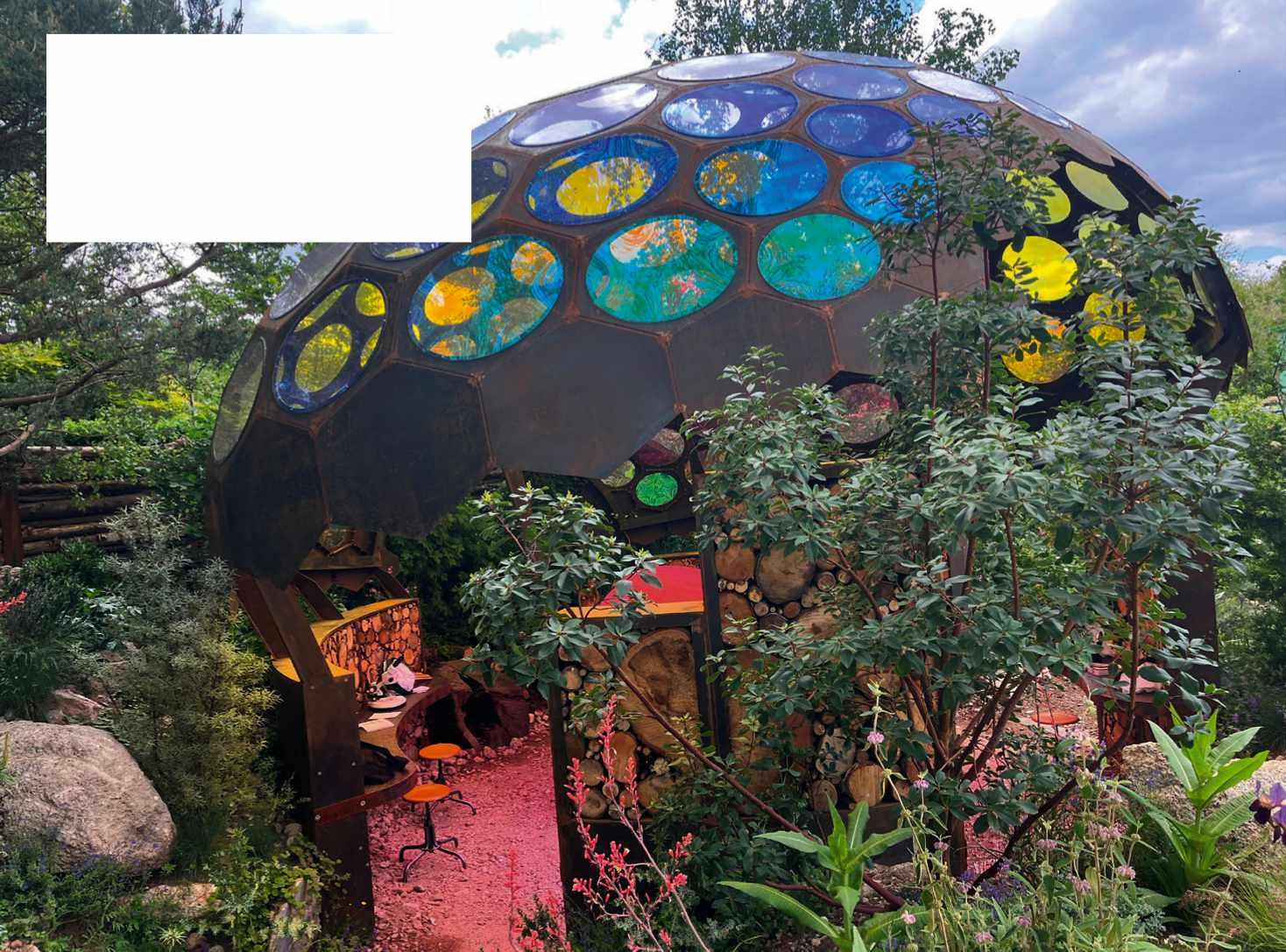
for themselves. Our free graduate programme gives you extra training opportunities and the chance to design gardens in prestigious locations.
CONTINUING PROFESSIONAL DEVELOPMENT
There are a wide range of opportunities to develop your career through our other extended courses. Our six-month intensive Planting Design Diploma is led by Nina Baxter with the involvement of some of the world’s leading planting specialists. We also offer a certificate programme in Construction Design to help you enhance your career prospects. These are also available online in real-time classrooms or in blended learning formats. To find out more download a prospectus from our website.
CLASSROOM BASED COURSES
We also offer courses in conjunction with the Royal Horticultural Society at RHS Garden Wisley and at Denmans Garden in Sussex. All these courses aim to be suitable for both professionals and the garden enthusiast. In 2023 they will include subjects such as designing for wildlife, for well-being and seasonal planting design. info@lcgd.org.uk
01483 762955 | lcgd.org.uk
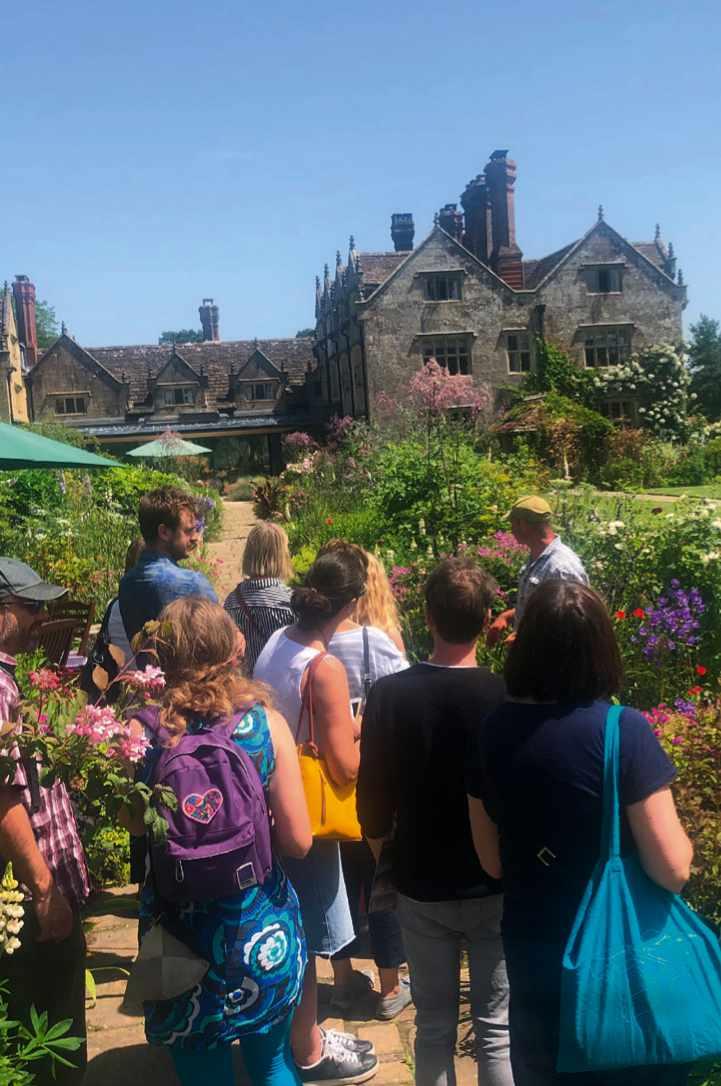
Garden Masterclass is Annie Guilfoyle and Noel Kingsbury and we offer a unique education portal for garden and landscape people.

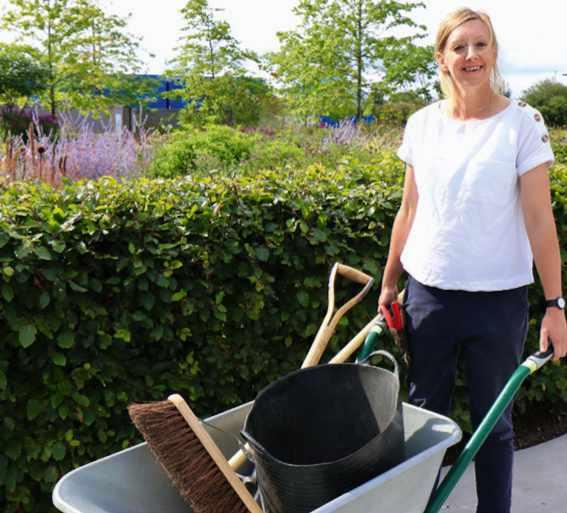
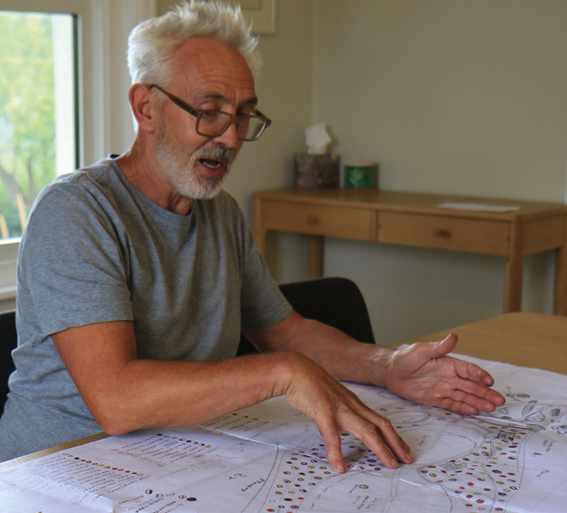
We seek out experts and innovators, whether well-known or waiting to be discovered. We organise live one-day workshops in gardens up and down the British Isles.

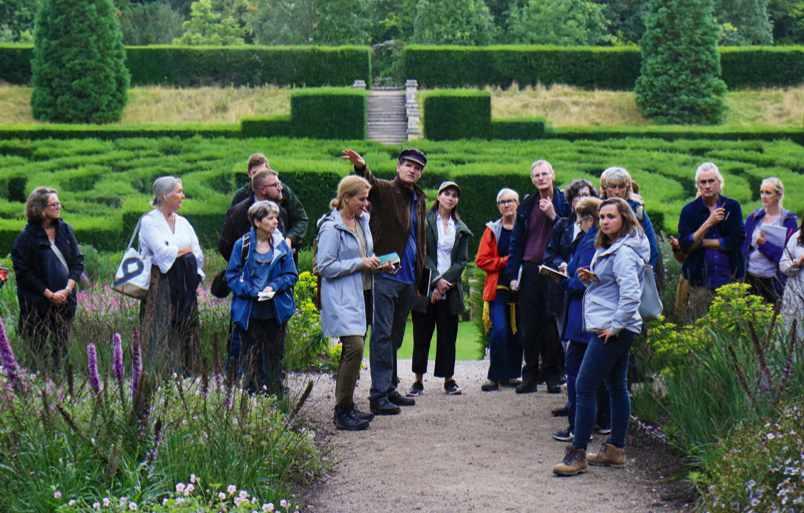
We offer a student membership to those in full time study and on training programmes.
We produce educational webinars, recordings are available from our website.
We commission films about exceptional gardens and their creators.

Our membership scheme gives access to exclusive live and web-based events, discounts on webinars and recordings and access to an extensive online library.
Some of what we do is free! Thursday Garden Chat is our weekly public service broadcast at 18.00 London time. All are recorded for YouTube and website viewing
Live events this summer include the following tutors: Annie Guilfoyle; Carolien Barkman; Jo McKerr; Marina Christopher; Luc Engelhard; Claire Greenslade; Dan Pearson; Troy Scott-Smith; John Little; Richard Scott; Tom Stuart-Smith; James Hitchmough; Michael Walker; Katy Merrington; Nigel Dunnett; John Grimshaw; Lizzie Bamforth; Steve Porter; Jimi Blake; Andy Sturgeon; Marco Scano; Sarah Eberle
All dates and information are correct at time of going to press. Please check our website for all up to date information and events or contact us by email: gardenmasterclass.org | gardenmasterclass@gmail.com
SUPPORTED BY
10% OFF
ALL TIMBER WINDOWS & DOORS IN JULY

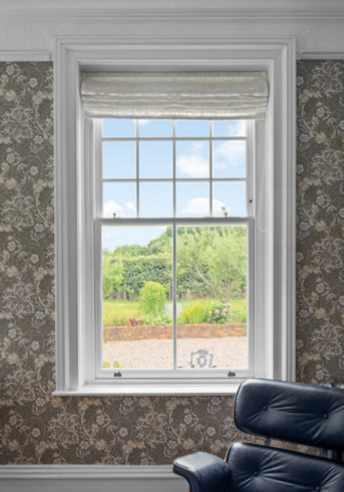


Naturally beautiful, our award-winning timber windows and doors are the logical choice. Constructed from engineered timber slow grown in cold climates, their strength, stability and beauty are guaranteed.
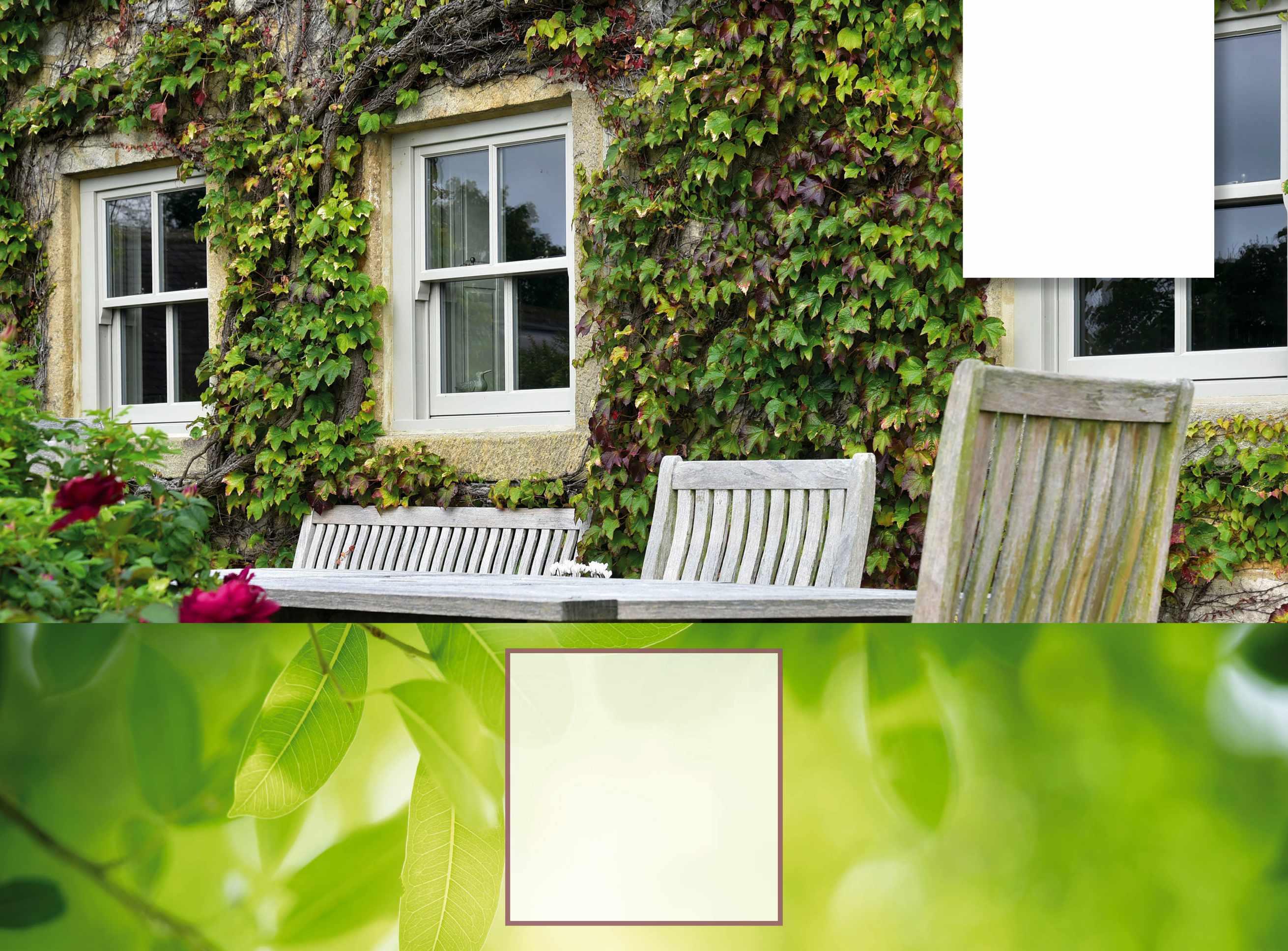
Whether your home is a country cottage, a Victorian semi, a modern townhouse or a converted barn, we have a range of traditional and contemporary timber windows and doors that will complement it perfectly.
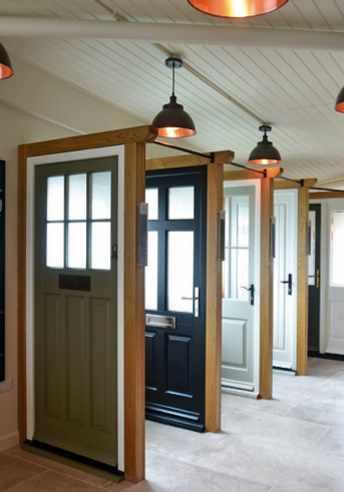
Our collection has been carefully and sensitively tailored to complement the English home. Unlike timber windows of old, our products will not twist, will not rot and require very little maintenance. High levels of insulation and security ensure there is no need to sacrifice beauty for comfort.

With a10% discount off all windows & doors in our Summer Sale, explore the range in 50 showrooms nationwide.
T: 0800 030 2000
timberwindows.com/gi
Horticulturist and garden writer Alys Fowler chooses ten of her favourite books on the theme of wilding, which takes us on a wide-ranging journey from the pioneering plantings of the Victorian wild gardener William Robinson to heartfelt poetry. Discover the nature-focused tomes you need on your bookshelf


Timber Press, £25
ISBN 978-0881929553
In what has come to be regarded as the original bible on naturalistic planting, published in 1870, groundbreaking landscape gardener Robinson argued for hardy plants to be grouped to mimic wild plantings, going against conventional wisdom of the day, which advocated the use of mass bedding plants. His addition of native plants to his schemes was seen as pretty radical at the time, as was his loose planting style. It’s startling to think that the perennial meadow style that we so associate with modernist designers such as Piet Oudolf actually has its roots in Robinson’s use of large drifts of hardy perennials, which, he suggested, could be naturalised into meadows, woodlands, watersides and mixed herbaceous borders (another of his ideas).
Not a man to shy away from strong opinions, Robinson’s writing tends to be a little verbose, but there’s plenty still to learn from this book, which has never been out of print. I particularly like this edition for Rick Darke’s thoughtful interpretation of Robinson’s style for today’s gardens, including many beautiful photographs of gardens inspired by it.
Frances Lincoln, £20
ISBN 978-0711234628
You could choose any number of books by either of these authors for inspiration, but this easy-to-use guide gives you their combined wisdom and wit along with a catalogue of enticing perennials, any combination of which would make for a seamless naturalistic garden. Establishing plants that can be maintained without undue manipulation is truly at the heart of creating wilder gardens.
What I admire most here is the authors’ experience of maintenance and their deep understanding of how plants evolve throughout their life cycle: will they stick around on heavy clay, how will they weather the winter, and how will they age? For each plant description, you get enough information to decide whether it will work for you. There are plenty of dreamy photographs to inspire you, and whimsical descriptions of plant characteristics, such as likening those plants that live briefly before self-seeding to soap bubbles – and who doesn’t want some of those in their garden?
by Pam LewisFrances Lincoln, 2005
ISBN 978-0711224803
It is easy to think that wilding is a recent trend, but there have been plenty of people banging this drum for some time. Sticky Wicket, which was written more than 15 years ago, stands out in my mind as one of those books that really started to turn the tide, and bring wilding into public consciousness. Written by Pam Lewis about her own garden in Dorset, the photography is stunning, and the ethos and writing deeply inspiring, showing that wildlife can truly be at the heart of good design through all the seasons.
I particularly like the way Lewis gently guides the reader through the process of pulling an entire design together, thinking across both seasons and multiple habitats. I return to it often, like an old friend, and it never fails to prompt me to put the more-than-human at the heart of my design choices. Though now out of print, it is worth seeking out a copy, and Making a Wildflower Meadow – a brilliant and detailed account of how Lewis made her many meadows – is an excellent companion read.
by Thomas Rainer and Claudia WestTimber Press, £25
ISBN 978-1604695533
Although the focus of this book is America, the message is universal. Written by a landscape architect (Rainer) and a grower (West), it is all about designing plant communities that provide ecological benefits.

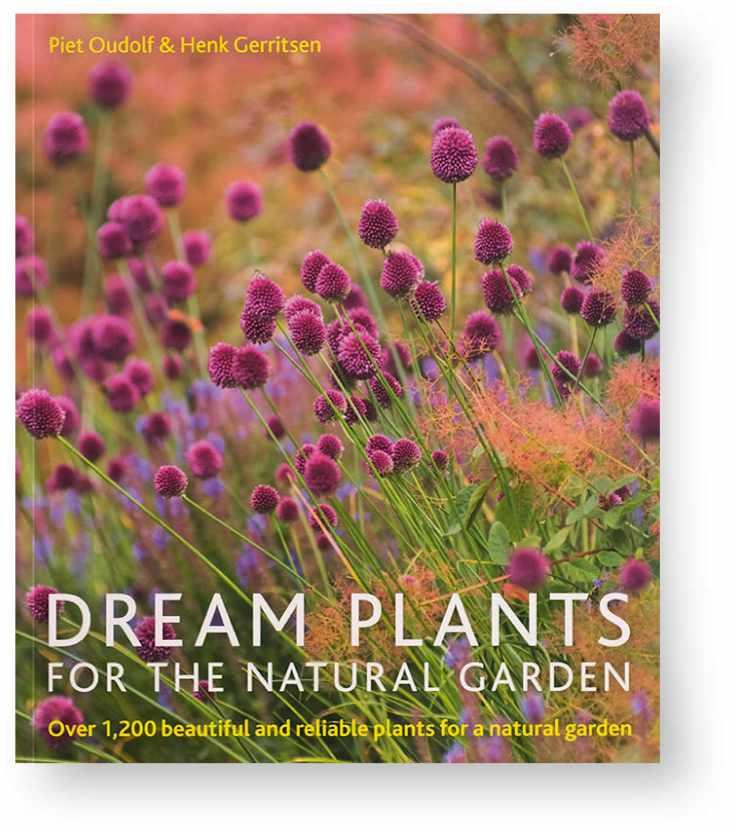
The book’s greatest strength lies in the understanding that such plant communities cannot replicate the dynamics of the natural ecosystem, which tends to find a balance over time and through natural selection. There’s a recognition that competition, succession and disturbance play a part in forming stable plant compositions, and that hybrid plant communities will always need managing. This is very much an indictment of endlessly replacing plants in failed designs and an examination of how we might approach things differently. Ultimately, it’s about moving away from plants as ornamental backdrops to buildings, and towards plant communities that support wild, genetic diversity and aid water management. There’s much to garner here as to how to achieve that.
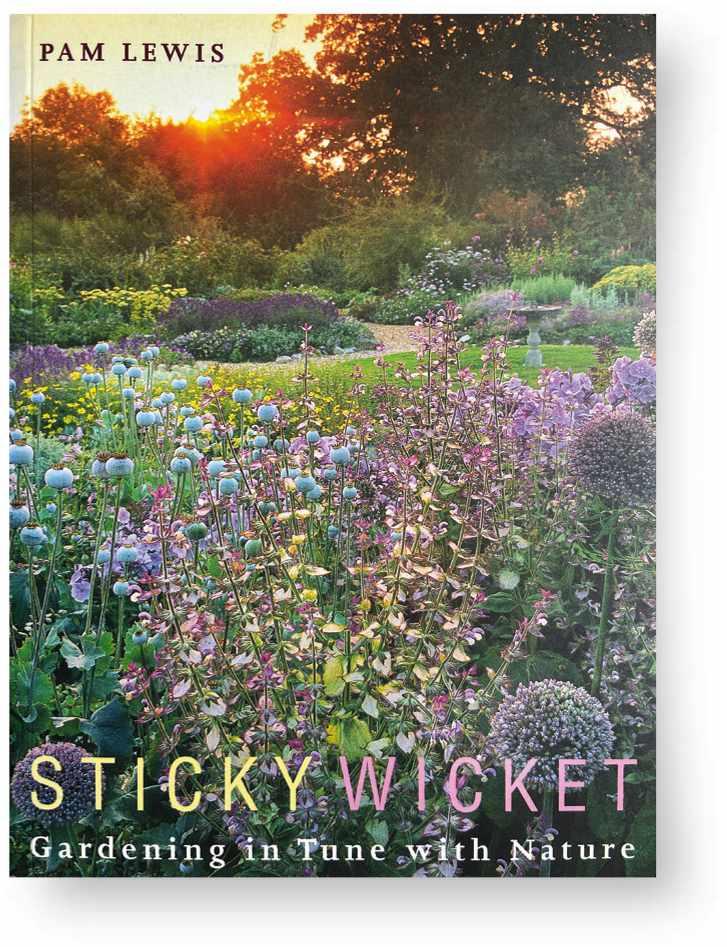
Establishing plants that can be maintained without undue manipulation is truly at the heart of creating wilder gardensPLANTS FOR THE NATURAL GARDEN STICKY WICKET: GARDENING IN TUNE WITH NATURE PLANTING IN A POST-WILD WORLD: DESIGNING PLANT COMMUNITIES FOR RESILIENT LANDSCAPES
A generation ago, a woman named Sylvia made a promise. As a doctor’s secretary, she’d watched stroke destroy the lives of so many people. She was determined to make sure we could all live in a world where we’re far less likely to lose our lives to stroke. She kept her promise, and a gift to the Stroke Association was included in her Will. Sylvia’s gift helped fund the work that made sure many more of us survive stroke now than did in her lifetime.

Sylvia changed the story for us all. Now it’s our turn to change the story for those who’ll come after us.
Stroke still shatters lives and tears families apart. And for so many survivors the road to recovery is still long and desperately lonely. If you or someone you love has been affected by stroke – you’ll know just what that means.
But it doesn’t have to be like this. You can change the story, just like Sylvia did, with a gift in your Will. All it takes is a promise.
You can promise future generations a world where researchers discover new treatments and surgeries and every single stroke survivor has the best care, rehabilitation and support network possible, to help them rebuild their lives.
Will you make that promise to generations to come? Please, leave a gift in your Will to the Stroke Association.
Find out how by calling 020 7566 1505 or email legacy@stroke.org.uk or visit stroke.org.uk/legacy
Gardeners
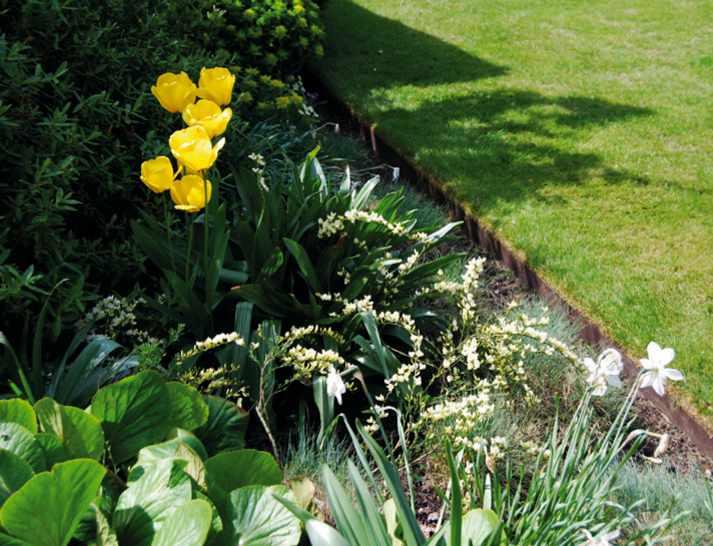
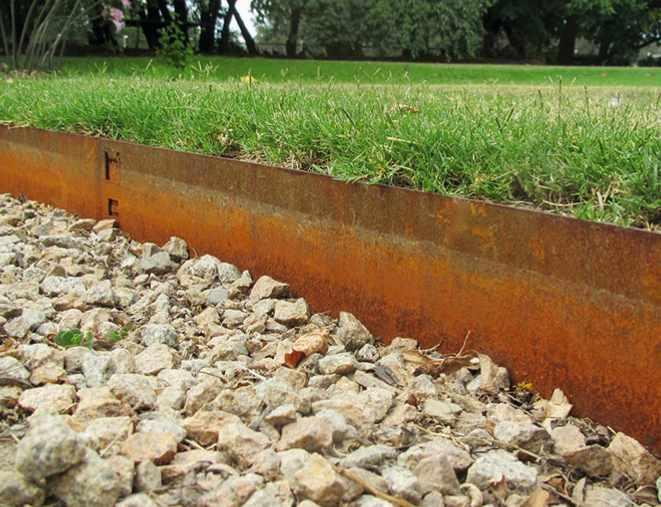
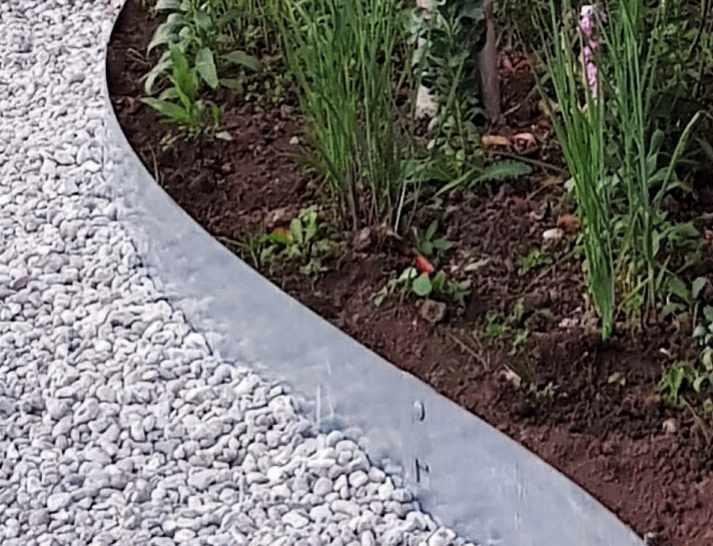
WE ARE THE ARK
by Mary ReynoldsTimber Press, £23.99
ISBN 978-1643261782
Reynolds’ latest book is an accessible dive into working with what’s around us to make our spaces true ecosystems. It is very much in the rewilding vein, but with an understanding that most of us don’t have acres of space to play with. It begins with a simple concept: give half of any land you own back to nature, and, if possible, grow food on the other half. Giving back could be as simple as using existing plants, allowing the lawn to return to a grassland, or gifting the night its darkness by unplugging your outdoor lights.
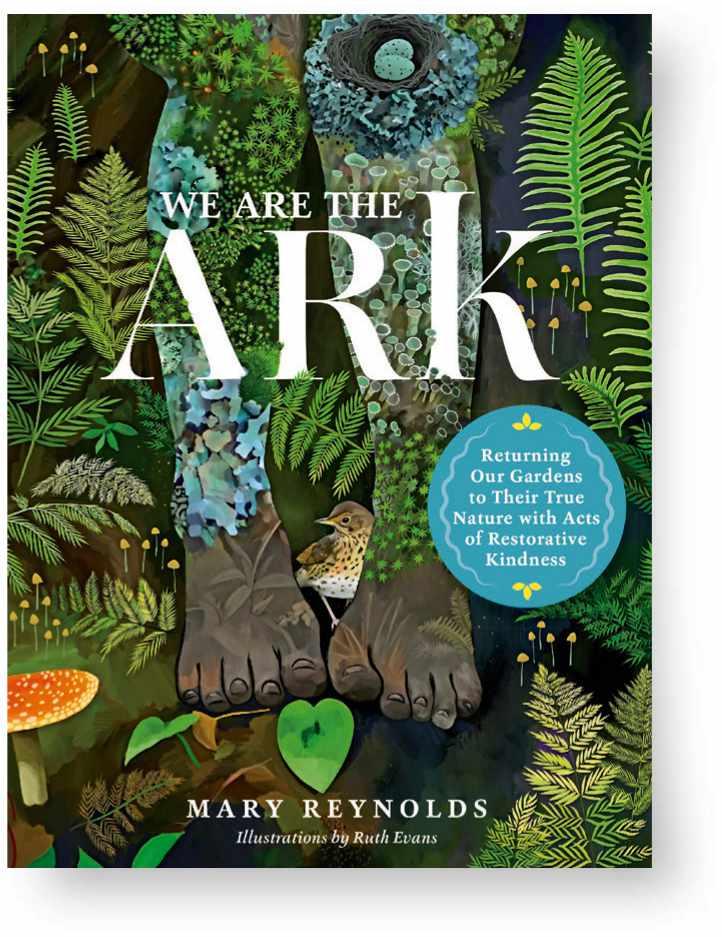
The book is rooted in practical detail; whether you aspire to transform your monoculture lawn into a meadow or just want to let the grass grow long, you’ll find all the necessary information to do so. Another of the book’s strengths lies in recognising the necessary spiritual connection we need to make with the land in order to find peace in allowing it to take control.
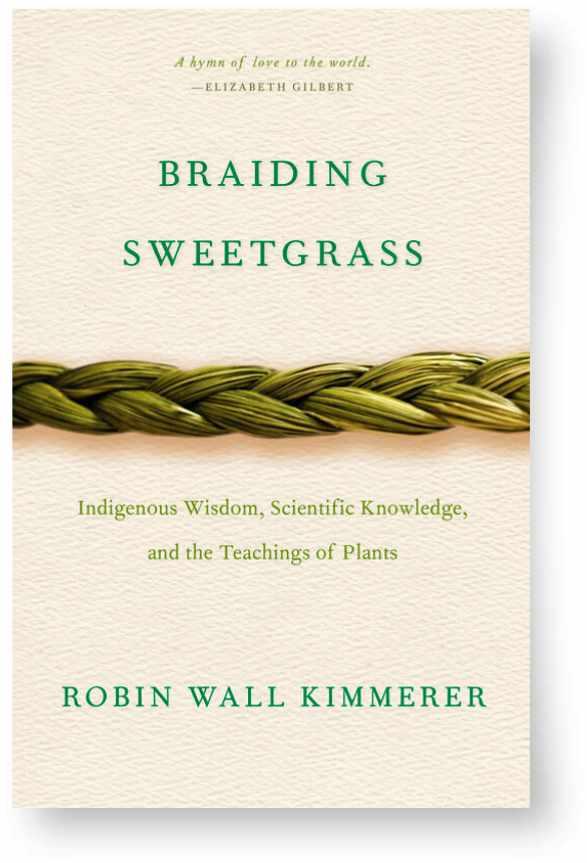 by Robin Wall Kimmerer
by Robin Wall Kimmerer
Penguin, £10.99
ISBN 978-0141991955
This is a gem and a wonder of a book about the need to put reciprocity at the heart of our relationship with the world around us. It’s a meditative teaching of indigenous ways, language and rights; a history of injustices to a people and place; a memoir of motherhood and of friendship with plants as much as people; and a musing on grief at our damaged planet. And yet it remains one of the most hopeful books on the environment, and our role in it, that I’ve ever read.
Kimmerer spent her working life as a botanist and she gently marries her academic work with her personal life; there’s many a wonderful botany lesson among life’s teachings. This is also one of the few books I would recommend as an audio book, as Kimmerer’s long history of delivering lessons to students means she has reading aloud down to a fine art. I often listen to chapters after reading them because I like the sound of her voice so much.
CITIES AND NATURAL PROCESS
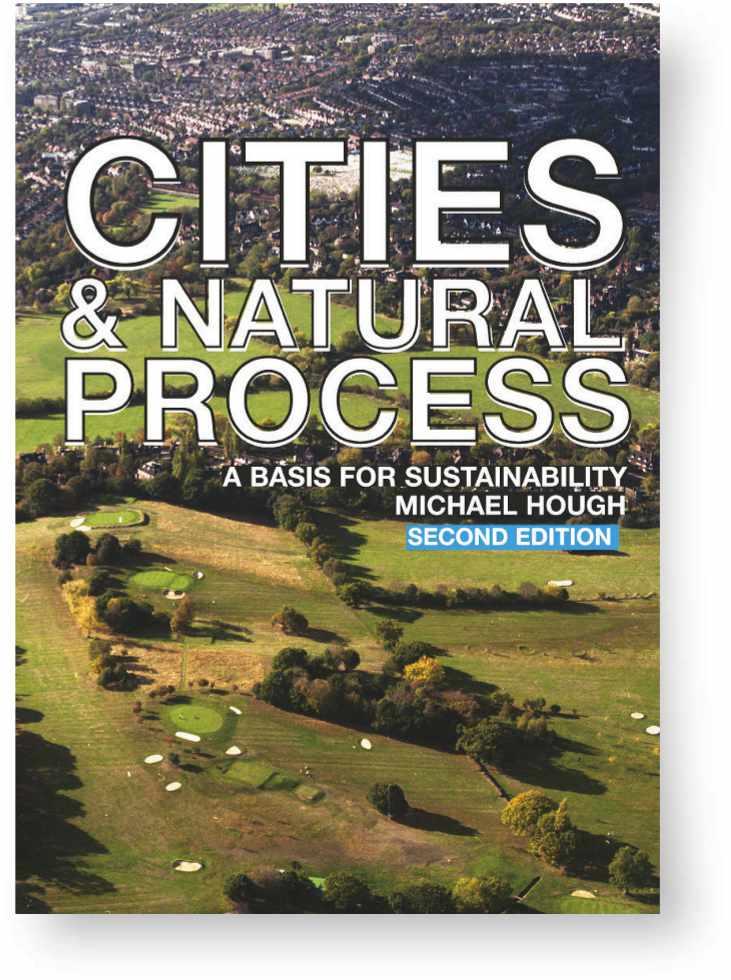 by Michael Hough
by Michael Hough
Routledge, £48.99
ISBN 978-0415298551
One for the landscape designers, this book argues for natural processes – whether that be water, wind or plants – to be placed at the heart of the design process to create cities that work with rather than against nature. By repositioning these elements as the drivers of design, Hough constructs a compelling case for a whole new way of creating sustainable urban living spaces.
The book explores what a city biosphere could look like through innovative use of water, plants, wildlife and city farming, and by making necessary climate connections. The section on water, which deals with everything from public fountains to woodlands and hydrology, is particularly good. Also valuable are the case studies, which are drawn from cities across the globe. It was well ahead of its time when it was first published in 1995, and the latest edition has a new final chapter linking these ideas up with the latest issues around landscape ecologies.
This is a gem of a book about the need to put reciprocity at the heart of our relationship with the world around us
Little Toller Books, £14
ISBN 978-0956254559
It was a hard choice between Nature Cure, Mabey’s truly groundbreaking memoir about his mental health and the healing power of nature, and this book, which is perhaps one of the more obscure titles in his illustrious back catalogue. But The Unofficial Countryside, which was written in the 1970s, is all about the wilder parts of cities, the crumbling warehouses, the neglected canal edges and the then overgrown bomb sites. Gentrification may have hijacked many such places, but even in our most urban areas, wildness creeps in. For those of us who are cityand town-bound, these spaces offer moments of reprise from our increasingly developed environment, and Mabey’s impassioned words urge the reader to seek out such hidden corners and the unruly, untamed joy they bring. The writing hasn’t dated either, though you might end up longing for a lost London. Use this book as inspiration to seek out these places; they have as much to teach us about design, resilience and habitats as any official natural reserve.
 by Chris Baines
by Chris Baines
Frances Lincoln, £25
ISBN 978-0711281288
I could recommend any number of brilliant books on the subject of wildlife gardening. Garden writer Kate Bradbury, horticulturist Frances Tophill and garden designer Jack Wallington have all written great examples recently, but this one – albeit over 30 years old – still stands as an excellent guide to making a truly wildlife-friendly garden.
Back in 1985, Chris Baines, who trained as a landscape architect, designed the first wildlife garden at the RHS Chelsea Flower Show. In the same year, his television show Bluetits and Bumblebees and his book How to Make a Wildlife Garden brought urban wildlife gardening to the masses.
The latter has been republished as the RHS Companion to Wildlife Gardening. It’s easy to read, informative and full of small, practical ideas for making habitats for wild things. With excellent illustrations, it’s worth it for the how-tomake-a-pond section alone. If you’re lucky, you may even find the original in your local charity shop for under a fiver.
THIRST
by Mary OliverBeacon Press, £24.75

ISBN 978-0807068960
Of Mary Oliver’s numerous anthologies, I’ve chosen Thirst for its inclusion of the brilliant poem ‘Praying’, with the memorable words ‘it doesn’t have to be the blue Iris, it could be weeds in a vacant lot’. It’s an inspiring thought, to make whatever is growing at your feet the subject of your daily prayer; wildness is all around and within us, and any journey towards a kinder world that makes space for all surely starts with such a prayer.
Oliver is mistress of paying close attention and her gift is to give you not only new ways of seeing, but a neat set of stanzas to carry around with you. There’s something very democratic about a poem that’s just the right length to memorise and thus take with you wherever you go. When you are lost or full of despair about human impact on the environment, Mary Oliver may just help you back to a place of tending to the wild things.

The wild, hidden corners of our cities have as much to teach us about design, resilience and habitats as any nature reserve

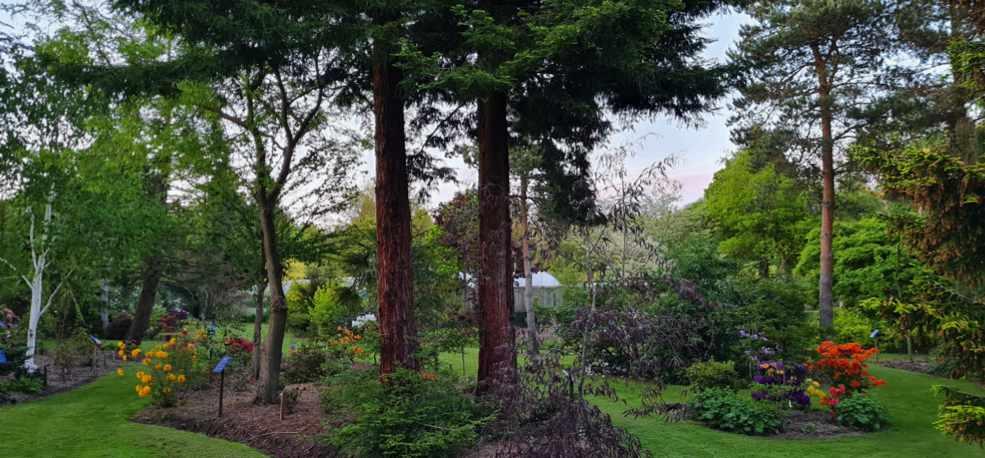
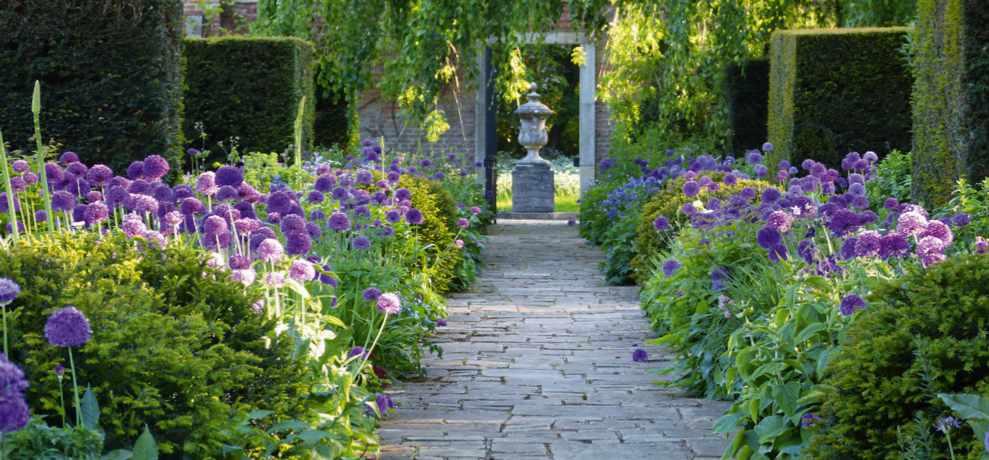
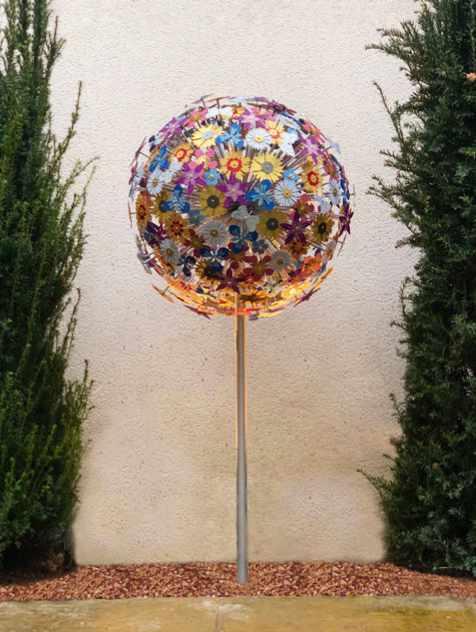
Ruth Moilliet produces highly finished sculptures inspired by the plant kingdom. Clients can choose from an existing portfolio or commission a bespoke artwork. For smaller pieces follow the purchase link on the website. Featured artwork - Pollination Sphere - anodised aluminium, stainless steel. sculpture@ruthmoilliet.com ruthmoilliet.com
Our fantastic Backdoorshoes will put a flutter in your step! They are lightweight, waterproof, durable and versatile. The perfect footwear to slip on and tend to the garden, walk the dog or even nip out to the garden office. We have over 30 fun designs to suit all! 15% Online discount for readers: GIINSPIRATION23. 01202 232357 backdoorshoes.co.uk
View our fantastic selection of metal garden screens that are both functional and stylish. They are perfect for creating a peaceful and secluded outdoor oasis in your garden. A precision-engineered and artistic solution that is both practical and beautiful, our garden screening will withstand the severe weather conditions and extremes experienced in the UK.
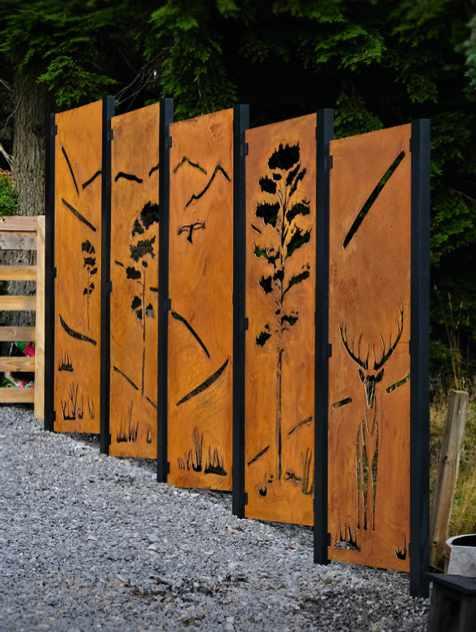
07720 841394 devenickdesigns.co.uk
With 190 acres of landscaped gardens, Ashridge House is perfect for a day of exploring, whether you want to discover what is blooming, or wander round our sculpture gardens. Dogs on leads welcome. Garden tickets can be bought on site in the Bakehouse.
Hertfordshire HP4 1NS | events@ashridge.hult.edu | ashridgehouse.co.uk
Visit our tranquil, nine-acre, woodland garden full of unusual trees and shrubs, many of which have been planted for their superb summer flowers. Many of the rarities on display are available for sale from our adjoining specialist plant nursery. RHS Partner Garden.
Smisby, South Derbyshire LE65 2TA | 01530 413700 | bluebellnursery.com

July sees the garden rooms at Cottesbrooke continuing to dazzle as late-season perennials such as dahlias, salvias and agapanthus flourish in the borders. Wander through the Wild Garden to see the giant gunneras, rodgersias and persicarias at their peak providing a lush, shady escape from the heat of summer.
Northampton NN6 8PF | 01604 505808 | cottesbrooke.co.uk
From beautifully crafted sulptures to practical accessories, we can help to make your summer garden special
Have you checked out the Gardens Illustrated Reader Rewards scheme? You can save money on travel, food & drink, gardening, and much more
1Browse
Take a look at some of our latest fantastic offers, covering gardening, lifestyle, travel, food and drink, and more.
2 Redeem Follow the link provided in each offer and apply the offer code when placing your order.
3 Find even more Go to gardensillustrated.com/offers to find the full range of discounts, deals and competitions available to you.
ENJOYAN AMAZING 10% OFF EVERYTHING AT HAYLOFT
Fill your garden with rare, unusual and exciting plants by taking advantage of this fantastic discount from Hayloft.
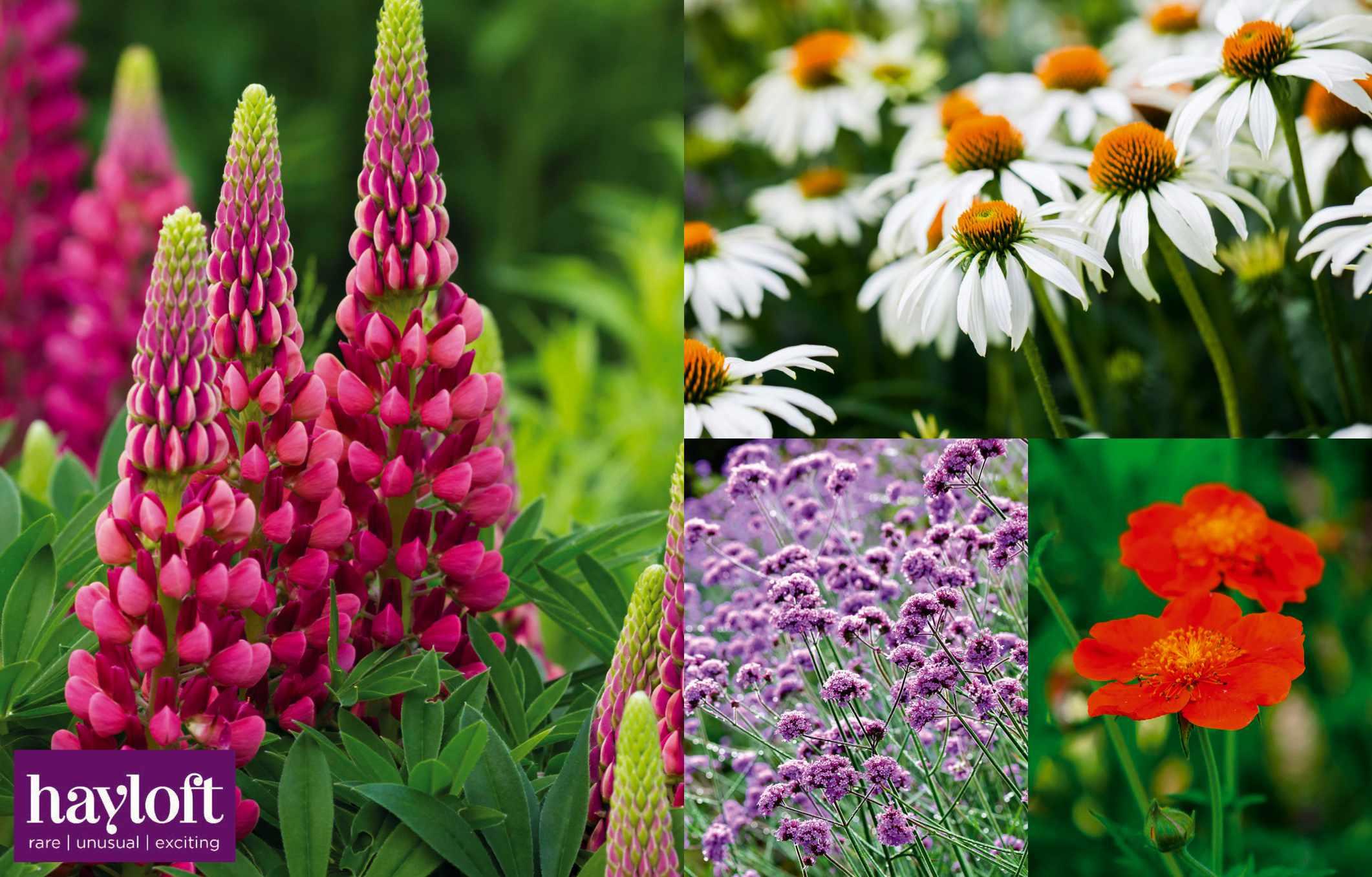
Hayloft searches the globe for the best plants, nurtures them in its nursery in the UK, then sends them out directly to you. Hayloft prides itself on its care and attention to plants at every step of the journey. Its plants are all selected by hand, supplied with care notes and delivered in recyclable packaging by courier. The friendly Hayloft customer care
SAVE 10%
team is renowned for its superb after-care service and is on hand to offer professional guidance and advice for all your gardening queries.
From perennials, annuals and bulbs to shrubs, trees, grasses and ferns, you’ll find plenty to inspire your gardening this year.
Claim your discount using code GI10 at hayloft.co.uk
To browse our full selection of offers, go to gardensillustrated.com/offers
SAVE UPTO 10%

Discover a different way to cruise with Fred. Olsen Cruise Lines. Based on five generations of seafaring, Fred. Olsen prides itself on a customer experience that’s uncrowded, warm and civilised – treating passengers as guests. And with more than 130 cruises to choose from, you’ll be spoilt for choice. With sailings from seven UK ports to destinations ranging from the British Isles to the Arctic, the Baltic, the Mediterranean, South America and much more, book yourself a holiday to remember today.
Save 5% with Gardens Illustrated discount. Combine it with the 5% discount available to Fred. Olsen’s Oceans Loyalty Club members to save up to 10%. To book, call 0800 035 5108 quoting Garden5.
SAVE £30
SAVE 10%

As Britain’s newest cruise line, Ambassador Cruise Lines is here to delight and inspire guests with sailings from seven regional ports. Its no-fly cruises from the UK offer the warmest of welcomes from the friendliest of crews. Onboard you’ll find amazing entertainment, exceptional cuisine, and an intimate but spacious cruising experience. With a range of inspiring destinations combined with unbeatable value, Ambassador Cruise Line promises you a holiday you won’t ever forget. Enjoy a 10% bonus discount on top of any of current deals and offers.
Visit ambassadorcruiseline.com and use code GARDENS10 at checkout, call 0808 102 8525 or book through your travel agent.
Hattingley Valley makes award-winning English wine from its state-of-the-art winery in Alresford, Hampshire. What sets Hattingley wines apart from the rest is the subtle use of oak barrels to age the wine. Hattingley wines take a minimum of 18 months to mature and develop, ensuring delicious flavours that showcase the versatility of English wine. You can try a selection of Hattingley wines for less when you buy a range case for £155, saving £30 on the RRP. This features six still and sparkling wines, including Classic Reserve NV and Still Rosé 2022.

To claim your discount, visit hattingleyvalley.com and use code GI25 at checkout at checkout.
To browse our full selection of offers, go to gardensillustrated.com/offers




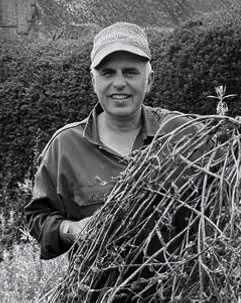






ACROSS
6 Garden molluscs, food for thrushes and hedgehogs, etc, but bad for eg hostas (5)
7 Bundle of long straw ready for thatching – sort of mealy (5)
8 An endangered pollinator – to live needs energy (3)
10 Genus of ‘starflower’ plants – in hope, I cultivated (7)
11 Urtica plants, food source for many caterpillars (7)
12 Fruit of eg Quercus or Corylus (3)
13 Eg Crested dog’s tail __ (Cynosurus cristatus) seen in wildflower meadows (5)
14 Daisies strung together for 22 yards? (5)
15 Restoring a habitat to a more natural state, as a gardener might do on a small scale (7)
16 Is angry about lilac (7)
18 A branch of this Mediterranean tree offered in peace? (5)
20 Bulbous underground stems of eg crocosmias (5)
21 For an eco-friendly lawn don’t do this in summer months – initially, manure only weekly (3)
23 Artificial material used eg for lawns, damaging to the environment (7)
25 Eg greenhouses needing wall support – shifts on slate (4-3)
27 Flower garland, from part of honeysuckle inflorescence (3)
28 Moisture-retaining material for the garden – a great deal left inside (5)
29 Where leaves attach to stems, so end twisted (5)
1 Let bough break … making a wildlife shelter for insects (3,5)
2 Area of particular biological/geological importance – initially Slapton Sands surely is (4)
3 See 14 down
4 Rude talk of fungal disease of plants? (4)
5 Glossy-leaved shrub with tubular flowers – possibly labiate (timeless) (6)
6 A plant shoot cut for grafting to stock (5)
7 A dwarf French bean with black/white seeds and two contrasting Chinese philosophical concepts (3,4)
9 Flavoursome, heavy-cropping strawberry – awfully pleasant, topped! (7)
13 Ingrained dirt – produced by garden’s first hoar frost (5)
14/3 A leading UK environmentalist / wildlife gardener – as in birches, maybe (5,6)
15 A stack of dead logs, say, could be a rotten place for wildlife! (8)
16 Eco-friendly moisture-retentive straw – makes good man lurch about (7)
17 Tiny eelworm – one tamed, surprisingly! (8)
19 The woad genus, as it is rewritten (6)
20 Myrrhis odorata, or sweet ___, aniseed-scented herb (6)
22 Good pollinators / consumers of plant-eating insects – but not good for picnickers! (5)
24 Cats’ little love apples? (4)
26 Barley ‘beards’ – left off cultivated grassy areas (4)

GARDENS ILLUSTRATED PRINTED ISSUES ORDER FORM
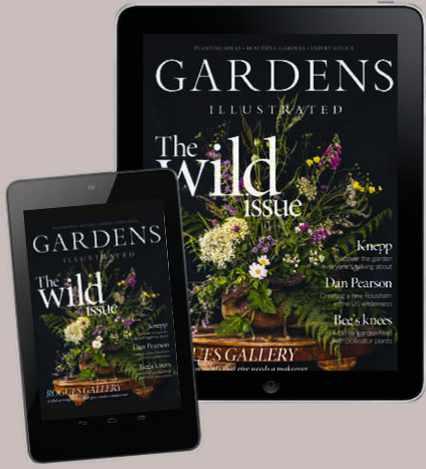
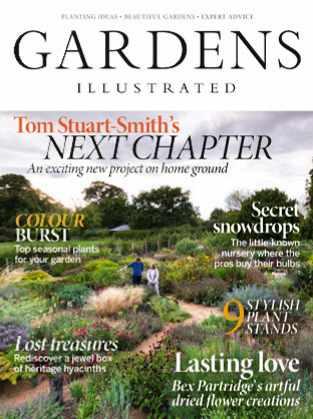
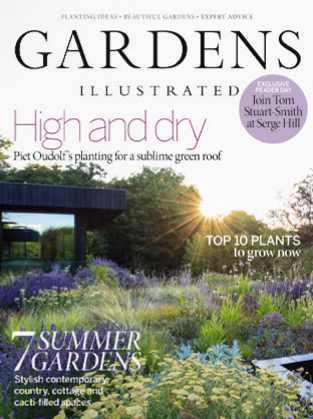
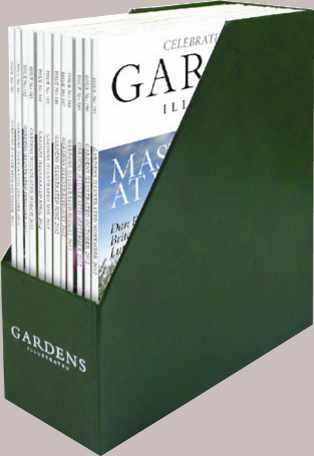
Complete this form and send to: Gardens Illustrated, Back Issues, PO Box 3320, 3 Queensbridge, Northampton NN4 7BF (You may photocopy this form).
SINGLE ISSUES
I would like to order copy/copies of issue(s)
SUBSCRIBERS
■ UK – £5.29 per copy
■ EU – £5.99 per copy
■ Rest of world – £6.99 per copy
NON-SUBSCRIBERS
■ UK – £6.49 per copy
■ EU – £7.49 per copy
■ Rest of world – £8.49 per copy
CLOTHBOUND SLIPCASES
I would like to order slipcase(s)
SUBSCRIBERS
■ UK – £8.49 each
■ EU – £9.45 each
■ Rest of world – £10.80 each
NON-SUBSCRIBERS
■ UK – £9.99 each
■ EU – £10.50 each
■ Rest of world – £12 each
Postage & packaging is included in all prices.
PAYMENT DETAILS
■ I enclose a cheque/international money order made payable to Our Media Ltd for £
■ I would like to pay by credit/debit card, please debit my card
Visa ■ Mastercard ■
■ ■ ■ ■ ■ ■ ■ ■ ■ ■ ■ ■ ■ ■ ■ ■
Expiry date ■ ■ ■ ■ Issue no. (if shown) ■ ■
Signature
Date / /
YOUR DETAILS
Title Forename
Surname Address
Post/Zip code
Daytime tel no.
Email address
Subscriber number (if applicable)
Please
if
■ We would also like to keep in touch by post and telephone about other relevant offers and promotions from our publisher Our Media Limited. If you’d rather not be contacted this way please tick here post ■ phone ■ . For more information about how to change the way we contact you, and how we hold your personal information, please see our privacy policy, which can be viewed online at policies.immediate.co.uk/privacy
To enter, scan the QR code above with your phone’s camera or go to: gardensillustrated. com/orticolario
Win a trip to Orticolario, one of Italy’s premier gardening events, held on the shores of Lake Como, 28 September – 1 October 2023. Now in its 13th year, Italy’s stylish garden show Orticolario will be dedicated to plants for a sustainable garden. The four-day gardening show is held in the grounds of Villa Erba, Cernobbio, overlooking Lake Como, and brings together top designers, nurseries and garden product companies, all with an eye to the very best in gardening, art and design. Alongside this theme of
sustainability, the show takes a look at the water landscape – both what we can do with water and how we might plant without it.
Held just as the seasons tip from summer to autumn, Orticolario gathers together a range of rare, unusual and collectible plants, craftsmanship and design with about 270 carefully selected exhibitors, talks, creative workshops, entertainment and seasonal food and drink.
To find out more about the show and events taking place, go to eng.orticolario.it
Terms and conditions In the event that the winners find themselves unable, due to force majeure, to take advantage of the trip, they will receive codes for an interactive visit to Villa Erba, the historic residence of the film director Luchino Visconti, to be enjoyed from the comfort of the winner’s own home. This promotion is open to all residents of mainland UK, aged 18 years or older. The closing date for entries is 11.59pm on 8 August 2023. The promoter is Our Media Limited (company number 05715415) with its registered address at Vineyard House, 44 Brook Green, Hammersmith, London, W6 7BT. For full terms and conditions, see gardensillustrated.com/orticolario.
Gardens Illustrated is offering readers the chance to win a weekend trip for two to Lake Como, including a visit to Orticolario as VIP guests.

THE PRIZE (for two people)*
• Flights: out of London to Milan on 29 September 2023; return Milan to London on 1 October 2023.
• Transfers from and to Milan airport.
• Two nights’ B&B at the Sheraton Lake Como Hotel in a double room.
• Tickets for Orticolario garden show on Saturday 30 September with lunch in the VIP area.
For your chance to win, answer the following question correctly:
Name the 16th-century Italian garden in Tivoli famed for its terraces and water fountains
a) The Garden of Ninfa
b) Trauttmansdorff
c) Villa d’Este
Enter online at gardensillustrated.com/orticolario
Closing date 11.59pm, 8 August 2023.
* Prize sponsors: Benetti Viaggi, Cernobbio Limousine Service – Sala Simone, Sheraton Lake Como, Orticolario.
Villa Erba in Cernobbio is the setting for this four-day gardening event. Orticolario offers a wide range of plants and crafts. The gardens of Villa Erba overlooking Lake Como.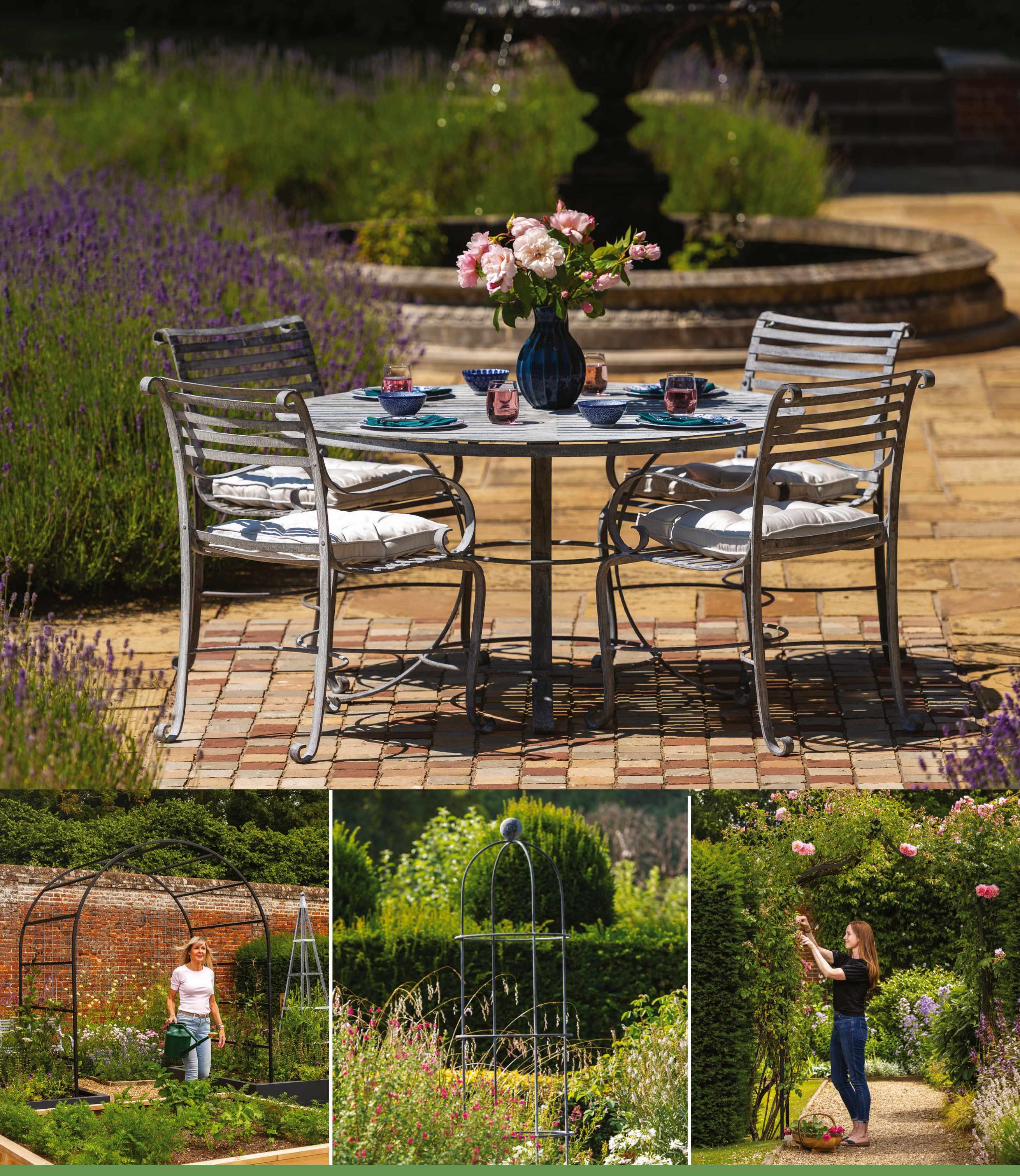

September 2023 – beg July 2024 BOOKING NOW
Covers the best in planting design while training in the more serious aspects of horticultural techniques. Practical sessions held at Arundel Castle under the guidance of head gardener Martin Duncan and at Sandhill Farm House, Rogate. Lectures by many leading gardening personalities and regular visits to outstanding private gardens. Students also learn to draw up planting plans.
(1 day a week (Tues), 10.30am–3.15pm, over three terms)
THE ESSENTIAL GARDEN DESIGN DIPLOMA

January – March 2024 BOOKING NOW
Based at the Chelsea Physic Garden and led by Rosemary Alexander and architect Catriona Rowbotham, the course is an overview of Garden Design, covering all the elements needed to rethink an average garden.Taking students step by step through site surveying, using the grid, horizontal and vertical features, garden layouts and planting plans, costing and specification, plus drawing tuition and homework on design and plant portfolios.Tutors are well respected in the industry and will guide students on how to succeed in this diverse profession.
(2 days a week (Wed &Thu), 10.30am–3.15pm, plus 2 days homework)
GARDENING FOR BEGINNERS
4 daysWednesday &Thursday 17/18 April & 24/25 April 2024
One of our most popular courses, led by master horticulturist Ben Pope, which aims to take each student through all the practical elements of caring for a garden from soil, tools, maintenance, seed sowing and propagating, weed control and pests and diseases.The first 3 days will be spent with lectures at the Chelsea Physic Garden and the final day will be spent gaining practical experience in Rosemary Alexander’s much praised garden near Petersfield and another private garden nearby, where Ben is in charge. Participants will be given a chance to prune, plant, sow seeds and regular maintenance tasks will be discussed. A light lunch and refreshments will be provided daily.
GARDEN DESIGN & CARING FOR YOUR GARDEN
Distance Learning Courses study anytime, anywhere in the world
A stepping stone to a new career.These two correspondence courses are a step by step guide to either designing your own garden or learning how to plant and maintain an existing garden: drawing up plans, hard landscaping, site analysis, planting, month by month tasks etc.Taught through a comprehensive course book, with projects submitted to us. (1-3 years to complete and individual assessment)
Not sure which Diploma course is for you? We prefer potential students to attend an Information Session when Rosemary explains the course and you can see our work space.
JUST CONTACT US TO SET UP A DATE & TIME
www.englishgardeningschool.co.uk
Email: info@englishgardeningschool.co.uk


Tel: 01730 818373
Long established as the leader in gardening tuition Based at the unique and historic Chelsea Physic Garden
follow us on Instagram

It happens about once a week – I emerge from bed to inspect the garden, and find that something has been rummaging in the night. A broken stem of last summer’s growth here, half a chewed-up glove there, a plastic compost bag trawled across the lawn. I imagine it’s a particularly wily fox, but if so, they always close the shed door behind them. Playful, yes, but considerate.
This kind of thing might have bothered me once. I’ve found all sorts in the garden: cat poo, cat-caught pigeons, rat burrows, sweet wrappers and burnt-out tealights from revelries past. There was the weekend I went to Glastonbury and received a particularly grisly message from the husband about a deceased rat the “size of a loaf of bread” splayed elegantly on a patio slab. I live a stone’s throw from one of south London’s main arteries, so it was never going to be bucolic, but I still harboured that gardening arrogance that this was my space: how dare something come and use it as a toilet/playpark/graveyard?
I’m not sure when I started to soften, but nevertheless,Ihave.Perhapsitwasresignation, or realising that getting cross about it was a waste of effort. More broadly, I think it’s an understanding. When we moved here, the
garden felt lifeless. The lawn was in better shape, sure, and the patio was probably cleaner, but there were no birds or spider webs. I installed a compost bin and a water butt, dug broad flower beds and pushed barerooted perennials into them. We were giddy with delight to receive a bird feeder for Christmas, filled it up with seeds and fat balls and waited, eagerly, for the restaurant to open.
By a year after we moved in, the garden was fat with first-year enthusiasm. I’d wet my bare feet on dewy lawn in the early hours of a summer morning and simply crouch down to listen to the bees and hoverflies that had turned up in their droves to the flowers I’d grown. Summer waned, bringing with it the burning fire of autumn, and the spiders arrived. Huge webs spun by fierce mothers that cared little for my daily inspections. I loved these spiders, and hated to breach their webs. They showed me that among the petals and the leaves and the growth that I had ushered in, I had created something greater – a home for other living beings. When I planted bulbs on the cusp of winter, I lifted the earth to find it wriggling with pink worms. The soil was unrecognisable from the hard, dry pellets I’d run my fingers over the year before. Snow fell in January, and it was still and beautiful, interrupted by the ginger pottering of the fox across the lawn.
How to make these changes? Part instinct, part laziness, part letting go. For insightful and practical advice, Jack Wallington’s A Greener Life offers a route to a more ecologically sensitive garden in nine steps. Reading Dave Goulson’s A Garden Jungle will make you see all insects differently. Andrew Timothy O’Brien’s To Stand and Stare will give you the permission to occupy your garden in a gentler way. Drop the peat, abandon the hose, watch where the weeds grow and see if you can fold them into your scheme (white deadnettle has become a major player in mine). But beyond all this, acknowledge and accept that our gardens are not just for us – and greater satisfaction comes from sharing.
I found it difficult to get into the garden last winter. I was heavily pregnant, I was releasing a book, we were on the cusp of ripping the whole thing up. Some days, it was an achievement just to stand by the back door. One February morning, however, I did, for a few minutes, and was rewarded by the sight of a blue tit hopping from one tall fennel skeleton to another, fastidiously picking off something delicious. I realised that I had made something that didn’t warrant my constant attention. The garden had made its own wild beauty. ■
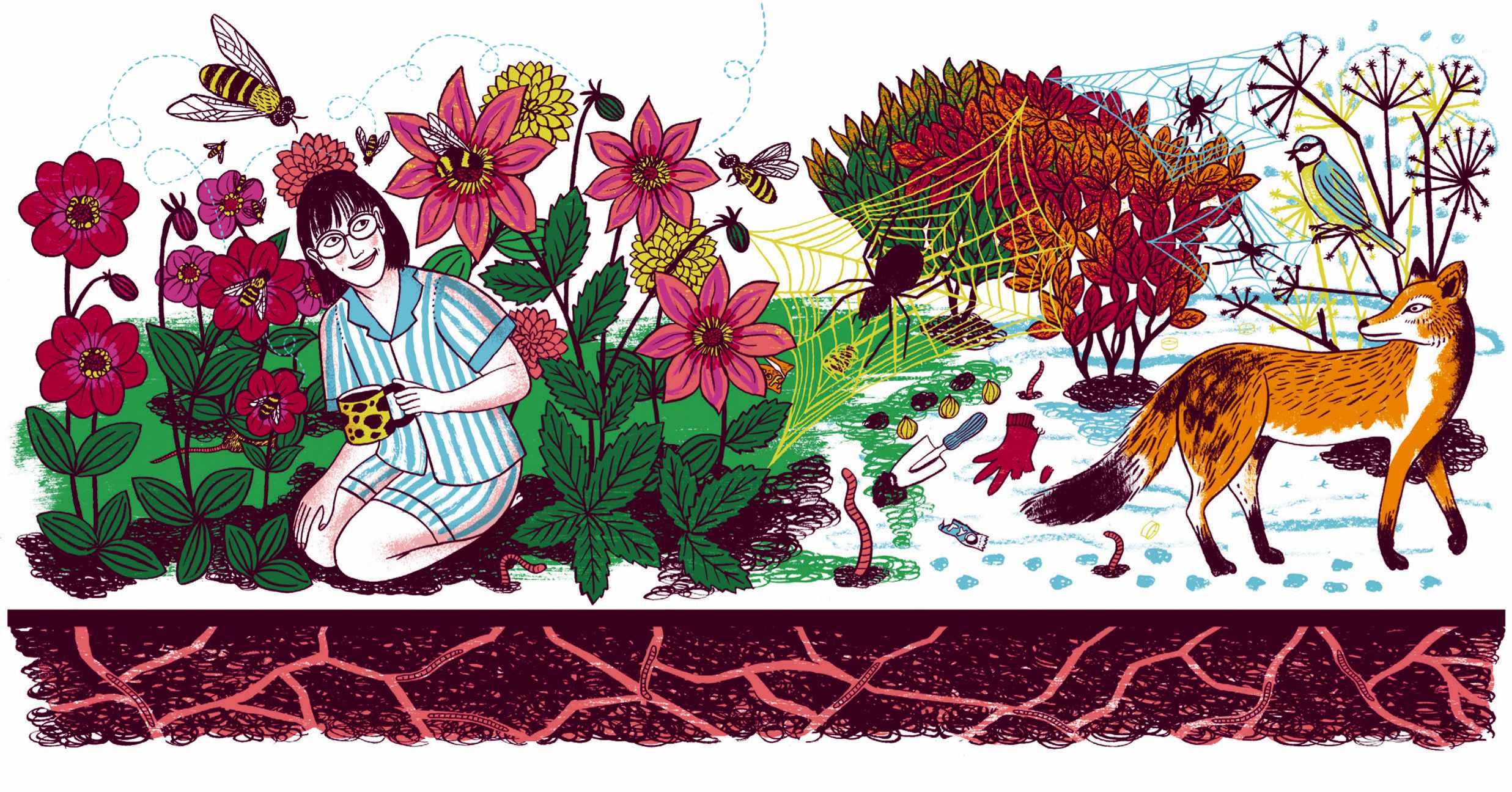
Like many gardeners, Alice Vincent used to want to feel in control of her garden space, but now she is learning to let go a little and welcome in the wildness
ILLUSTRATION ALICE PATTULLO

